results Sorry, we didn't find a result for you!
${doc.title}
${doc.teaser}
Leipzig is looking forward to you!
You have questions about your trip? Call us: +49 341 7104 260
Tips for planning
- Our travel packages
- Save money with the LEIPZIG CARDS and LEIPZIG REGIO CARDS
- Be inspired by our top 10 tips
Current weather in Leipzig
Weather tips
- Leipzig with Kids
- Leipzig for Culture Lovers
- Leipzig for Two
- Active holidays
- Insider Tips
- Restaurants and Cafés
- Sustainability
- Accessible Leipzig
- Castles and Palaces
- Industrial Heritage
Leisure Activities
- Lakes and Waterways
- Spas & Wellness
Top Highlights
- Travel Packages
- Group travel
- Welcome Cards
- Tourist Information
- Brochures & Catalogues
- Travel & Traffic
- Information for travel operators
- Media Information
- Photo archive
- Media service
- Contact person
- Jobs and internships
- Plan your event
- Congress initiative
- Congress City Leipzig
- Excursion destinations

Spring Awakening
in Leipzig and its surrounding region!
Leipzig Travel – Your journey starts here
Leipzig is not just a lively city with plenty of variety and full of culture , creativity , history and the spirit of the age. Leipzig is also embedded in a vast and incredible region with refreshing lakes and waterways , fairytale castles and palaces and miles of idyllic cycling and hiking paths . Come and explore Leipzig with everything it has to offer in and around the city. Our tips will ensure your trip to Leipzig is a memorable one.
Spring in Leipzig and the Leipzig Region
Colourful Spring is here!
…plan your spring holiday in Leipzig and its surrounding region now!
How would you like to explore Leipzig and its surrounding region?
These tips will help you plan the perfect trip to Leipzig:
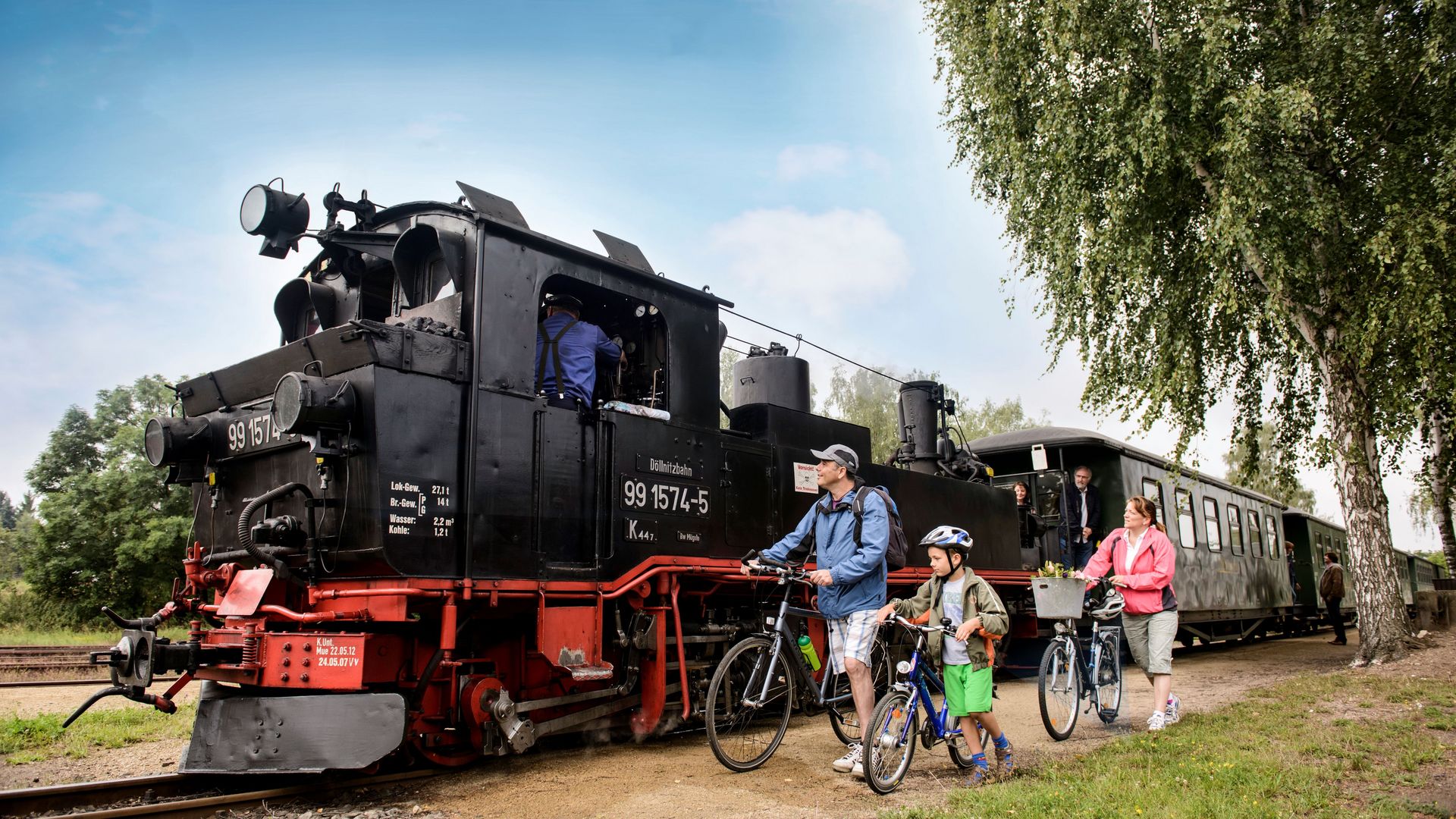
Family holidays in Leipzig and the Leipzig Region
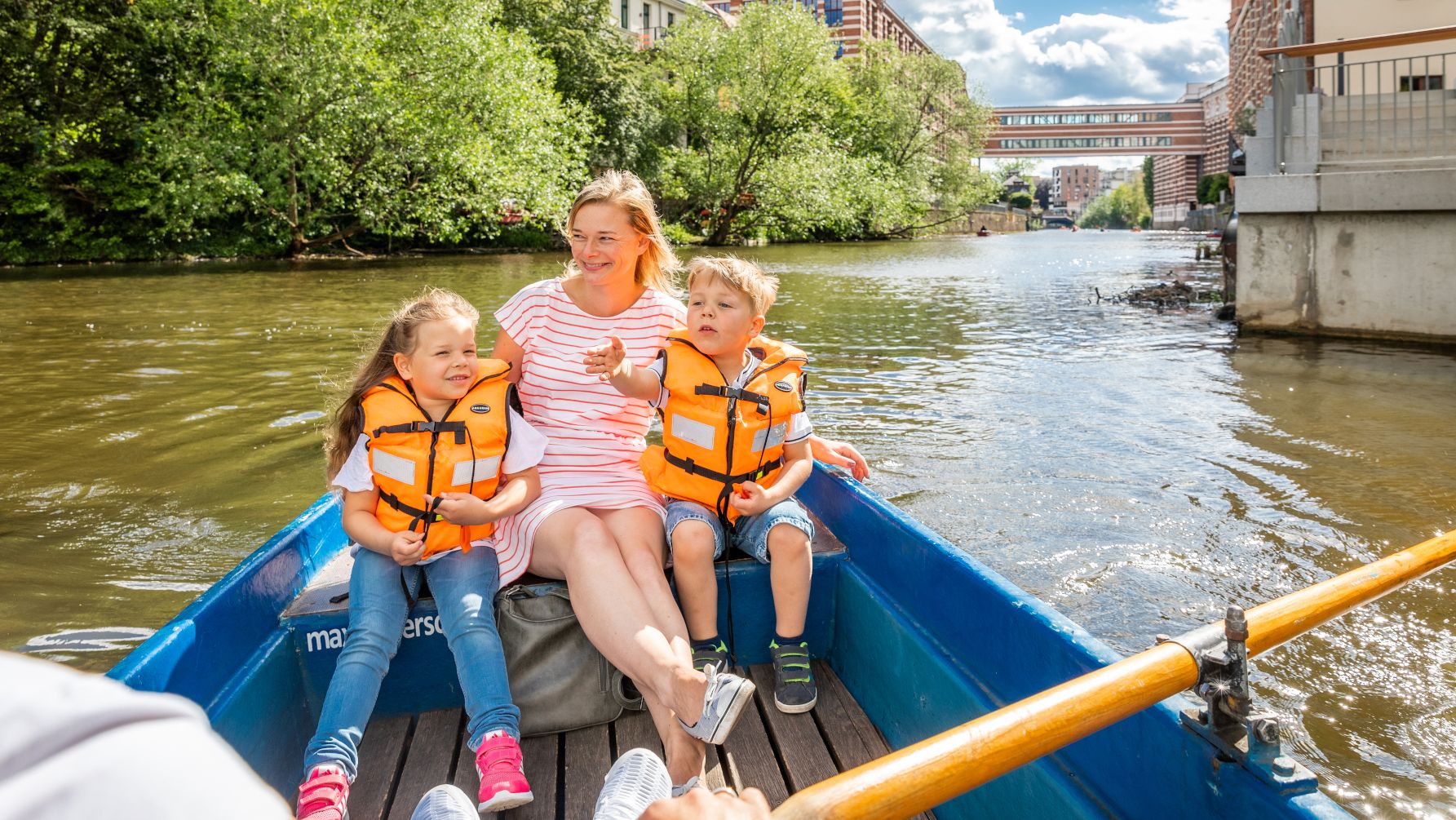
Boat Trips – Leipzig for Families
Explore the waterways of Leipzig together as a family.
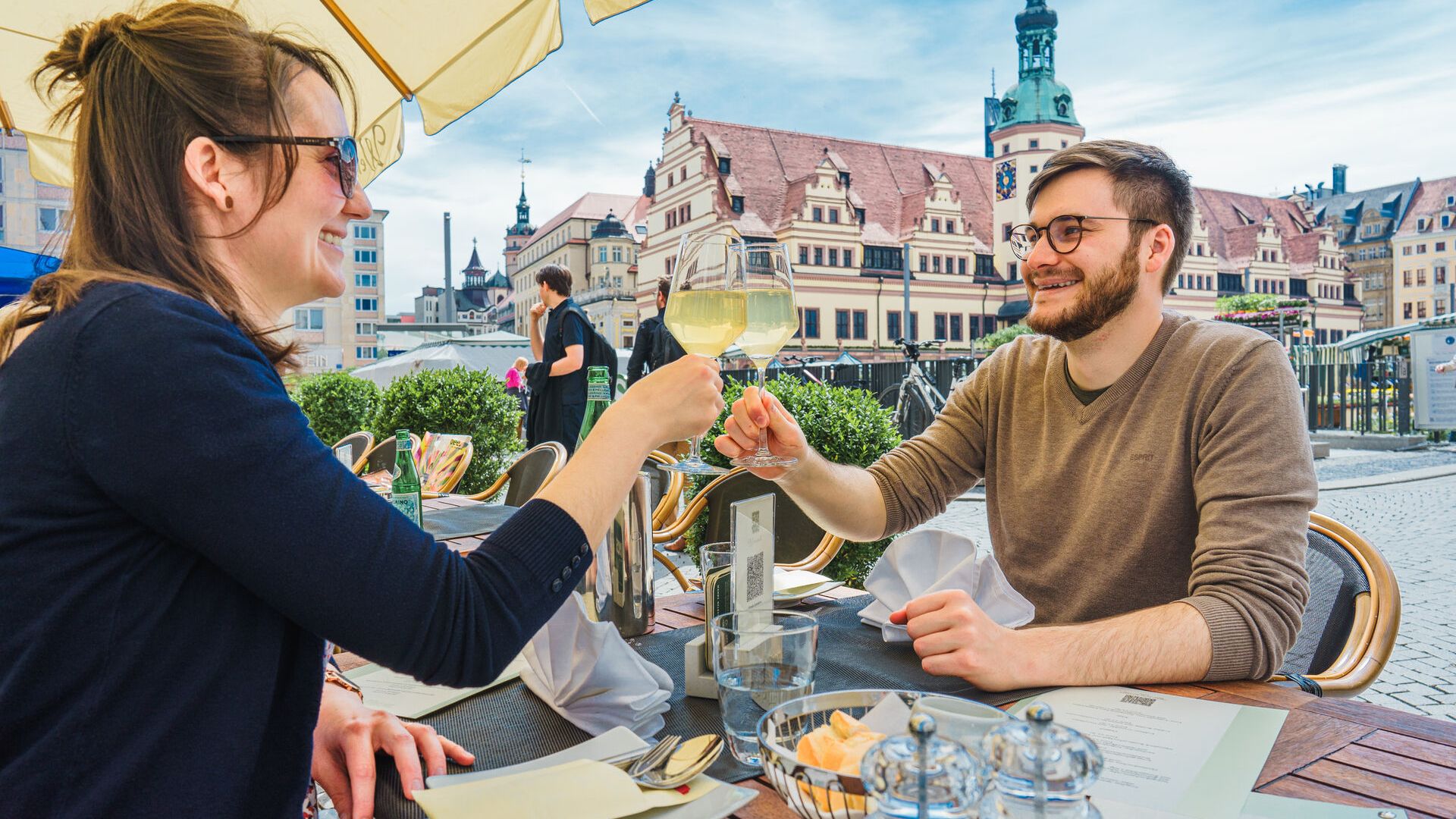
Discover Leipzig for two
The Weinstock restaurant is right in the middle of Leipzig city centre.
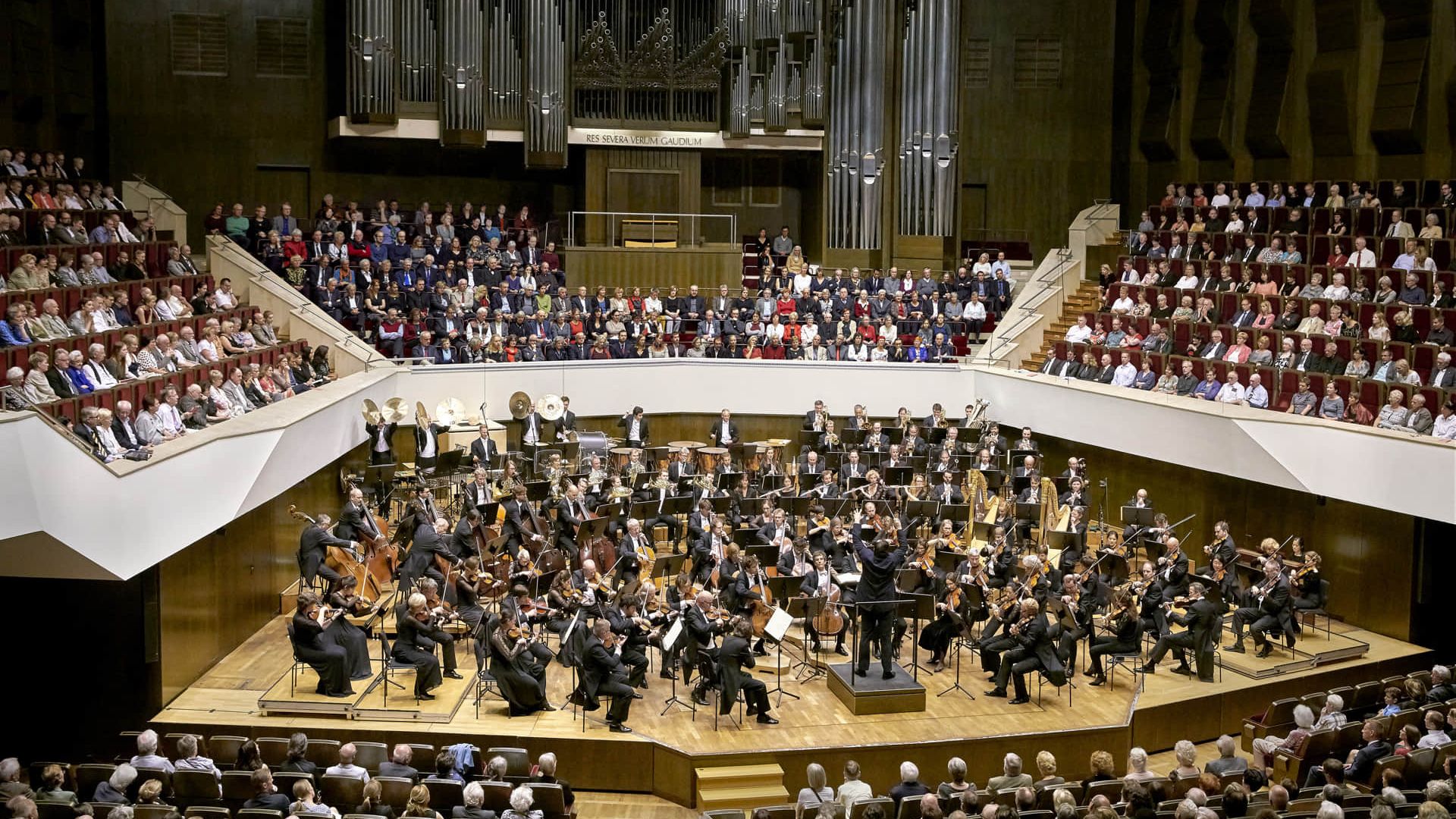
Cultural trip to Leipzig
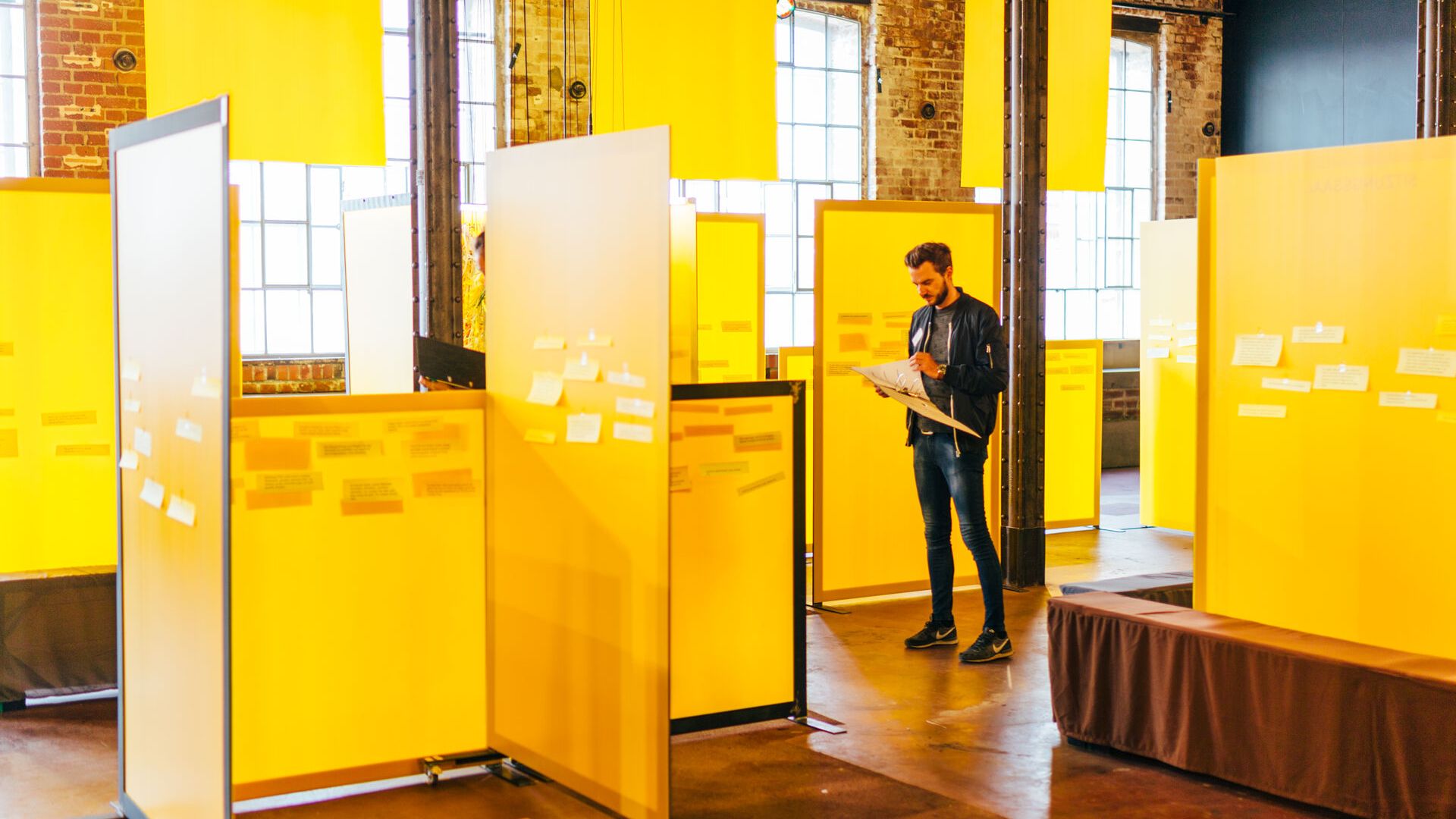
Use our insider tips to discover Leipzig
Exhibition room on the Spinnerei tour.
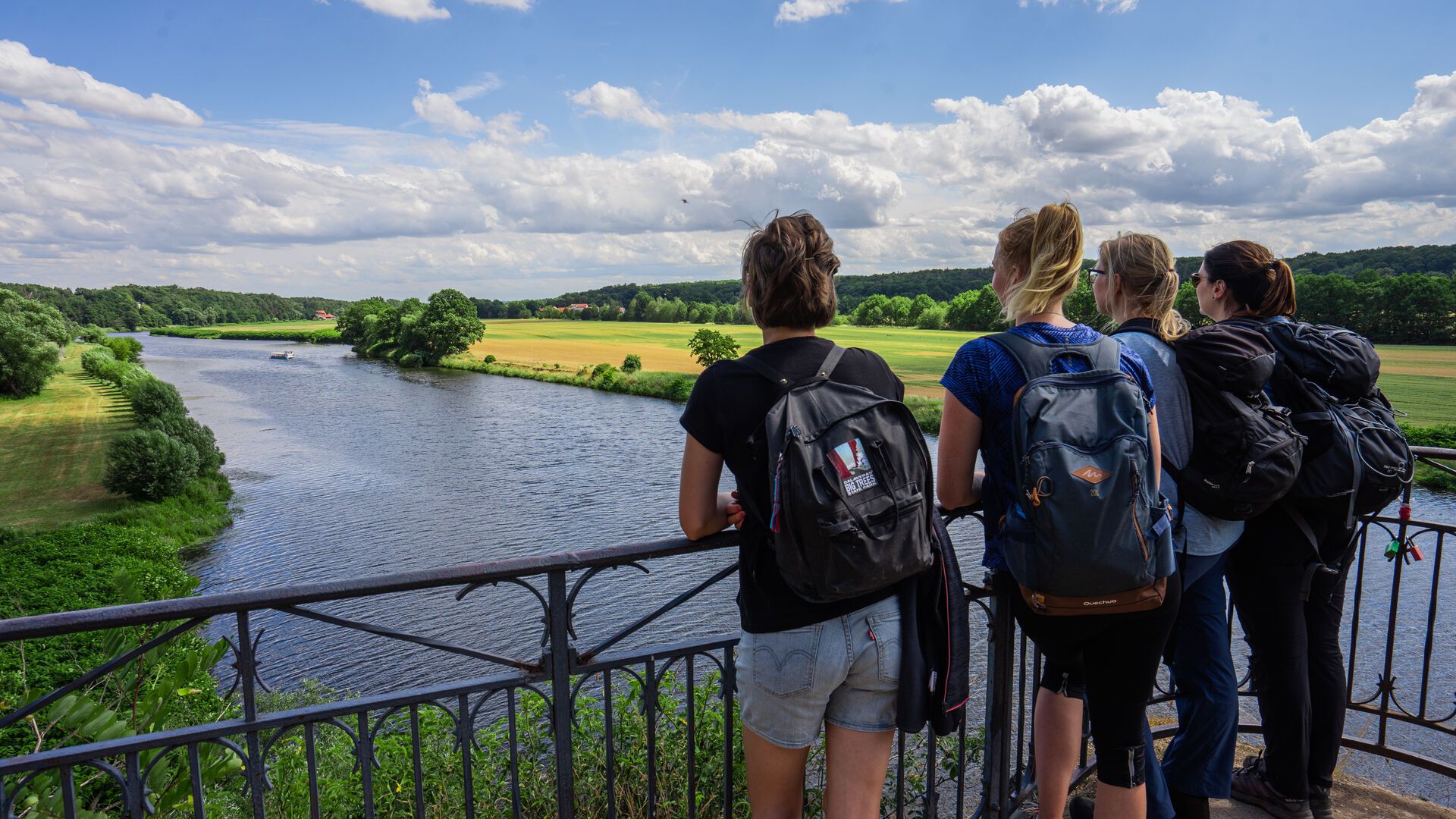
Active holidays in the Leipzig Region
The Leipzig region offers pure nature for hiking fans.
Share your trip with us
#leipzigtravel
Sustain Europe
Leipzig Tourist Information Office
Brochures and catalogues
Download or order
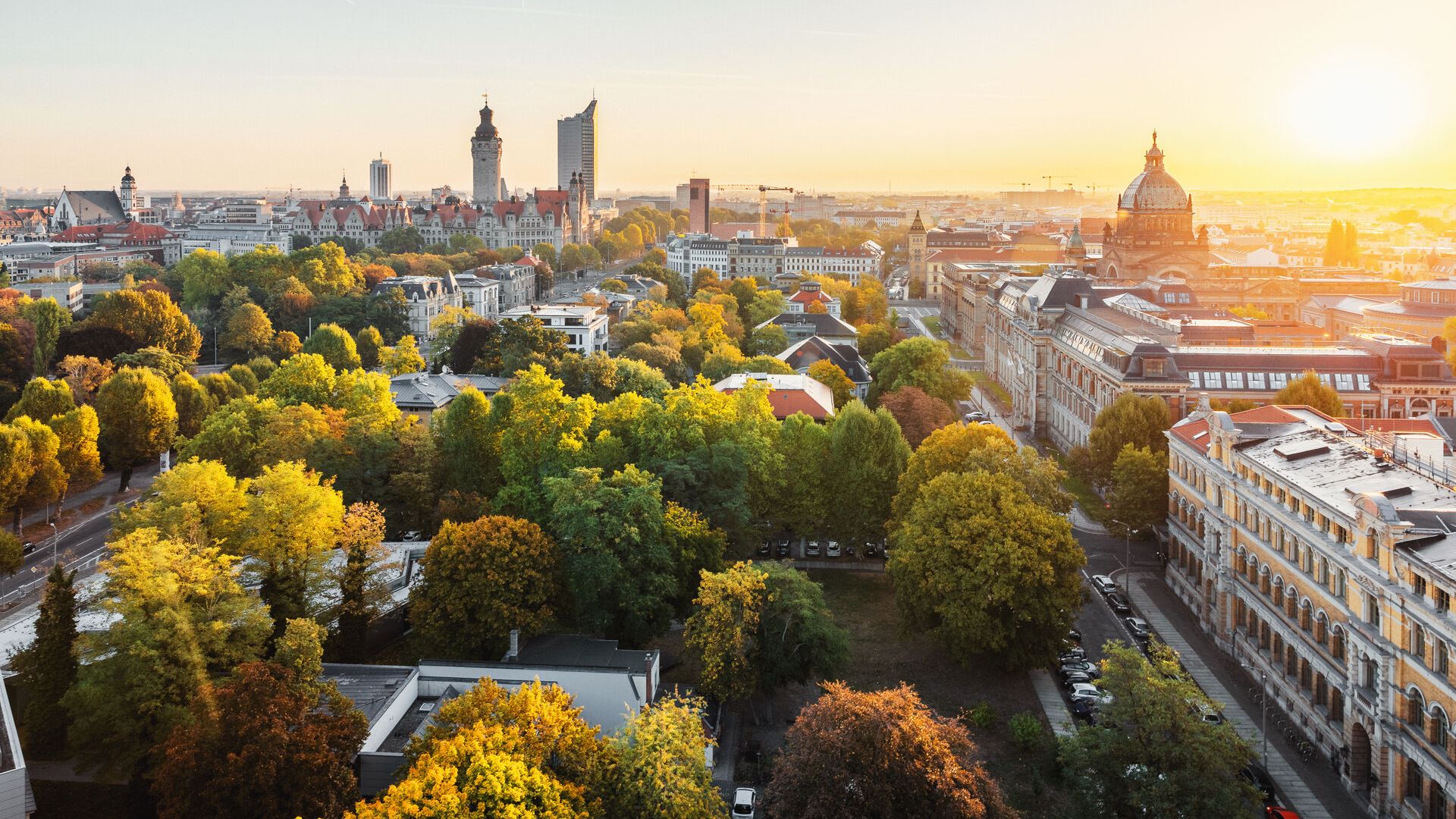
Leipzig Blog
Numerous articles about what not to miss in Leipzig!
Meetings, conferences and congresses in Leipzig
Congress initiative "Feel the spirit ... do-it-at-leipzig.de"
Leipzig ist the perfect destination, when it comes to meetings and business events of all kinds and sizes. The partners of the congress initiative “Feel the spirit … do-it-at-leipzig.de” are happy to assist you by offering unique venues, modern conference hotels and an attractive supporting programme to top off your event.
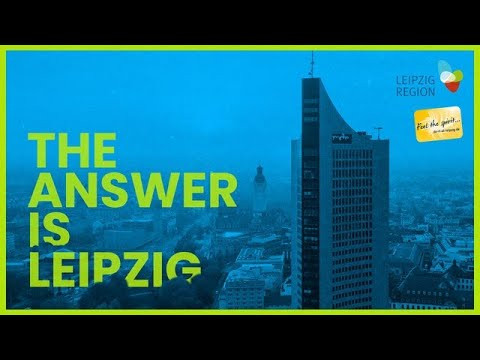
LEIPZIG – CITY OF MERCHANTS AND ARTISTS

HERE IS THE SCENE OF THE FINE ARTS ALIVE

HERE LIVES TRADITION – NOT ONLY IN TRADE
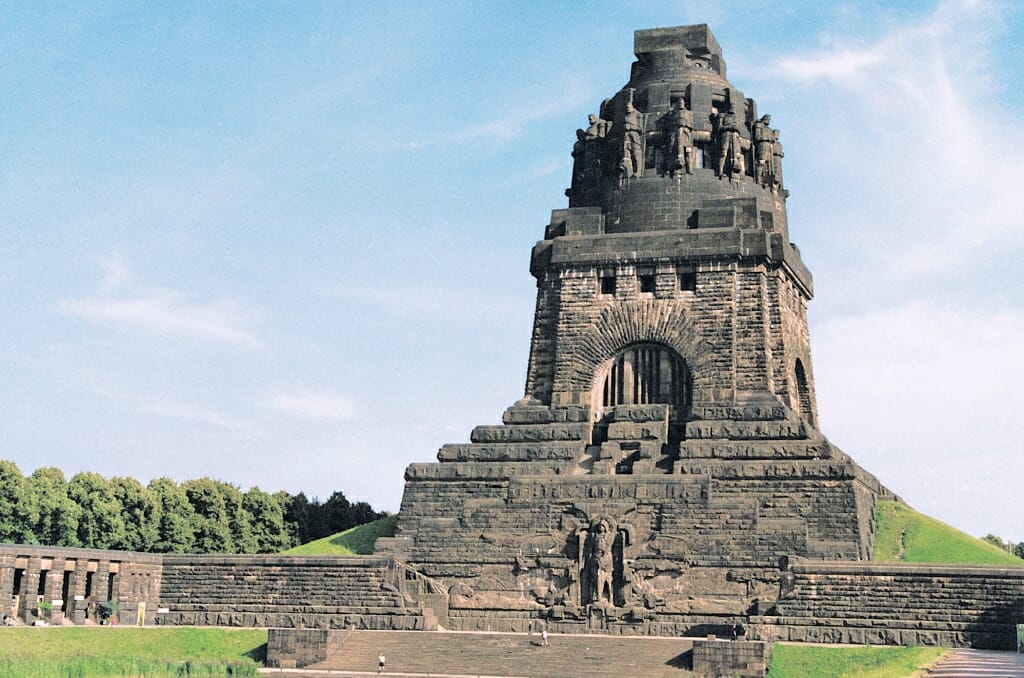
HERE FOUGHT THE EUROPEANS SIDE BY SIDE

THE BKB TRAVEL GUIDE TO LEIPZIG
You will find detailed information for preparing and enjoying your trip to leipzig in our guidebook “3 days in leipzig”. compact, easy to use and informative a programme for three days, a city plan, special tips and addresses. we show you the highlights, the pleasant districts, take a break with you, and tell stories … just as much as you need for three days “3 days in leipzig” is available as a paperback from your bookstore or from the bkb shop, where you can also buy it as an ebook.
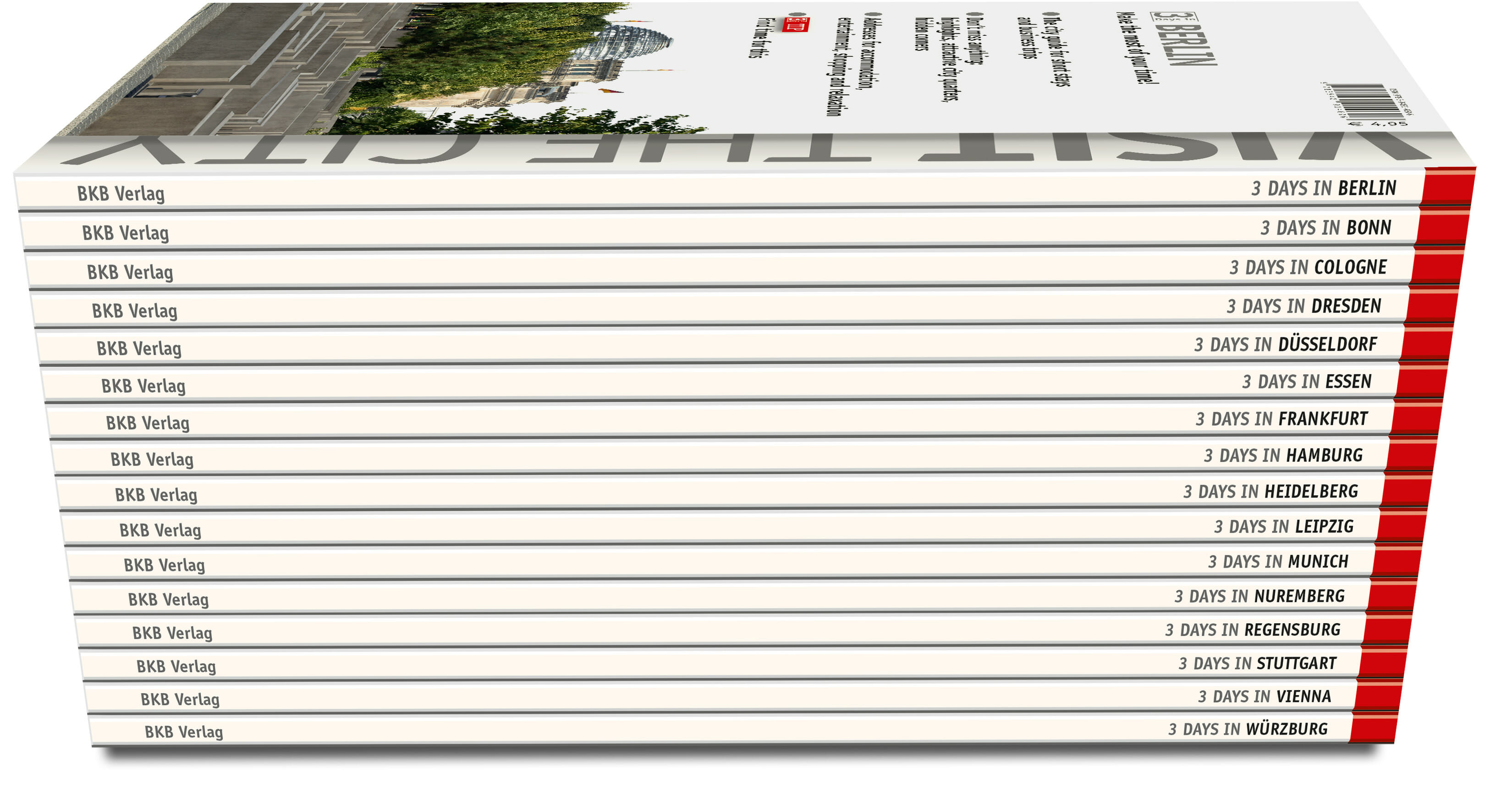
The travel guide “3 Days in ” is available in german or english language in the BKB Shop or in your bookstore!
The texts and images on our website are to help you get your bearings and plan your trip to Hamburg. All information has been carefully researched by the 3-Days-in editorial team and continually updated. Nevertheless, it is possible that individual details are incomplete or out of date. We are therefore grateful for every correction or addition to our information. Please send your hints to: [email protected]
TIPS FROM THE VISIT-THE-CITY EDITORS FOR YOUR 3-DAY TRIP TO LEIPZIG
Much has been written about leipzig, hype describing it as the new berlin. but it’s better to explore this vibrant city with all its contrasts for yourself: green wasteland and industrial monuments, burghers’ houses, concrete housing blocks and post-modern architecture have made their mark on the city. magnificent arcades invite you to go shopping, lakes in former open-cast mines to go swimming and relax, and everywhere you will find street cafés and beer gardens where you can linger, leipzig day 1, the old city hall, the heart of leipzig is the marketplace, site of the altes rathaus (old city hall), one of the finest examples of renaissance architecture in germany. this long building was constructed in only nine months, in 1556–57, by hieronymus lotter, mayor of leipzig and architect to the prince elector. today the first floor is home to a museum of city history that takes visitors on an exciting trip back in time to the golden days and the low points in the story of leipzig. for a long time now, the city has been governed from the neues rathaus..

MAGNIFICENT BUILDINGS OF THE OLD MERCHANTS
Everywhere in the city centre you come across merchants’ houses with so-called through-yards, many of them now used as shopping arcades. as a trading city needs a lot of space for delivering, storing and selling, on a plot of land there was usually a front house and one or several houses in back yards, linked by a narrow passage. they enabled carts to be loaded quickly without turning. trading took place in the vaults of the ground floor, with offices and residential accommodation above and storage space for goods in the attics. an example of this is the 18th-century barthel hof , where the crane beams with which goods were hauled up to the stores can still be seen., a real master of music: johann sebastian bach, one of leipzig’s most famous people is the man who became director of music for the city and for st thomas’s church in 1723. you can feel closest to him in the church, which was his second home in leipzig. whatever is performed, “jesu, joy of man’s desiring” or “praise the lord”, a choral or a motet, there is nothing more impressive than listening to a concert of his work in st thomas’s church : every friday at 6pm and saturday at 3pm you can do this., the church, altered in 1496 as a hall church in late gothic style and later given a baroque tower, has been connected to music for over 800 years, as its choir, the world-famous thomanerchor, was founded at the same time as the first church in the 12th century. when he was master of music in the church, bach conducted the boys’ choir with its high, bright voices. go to the bach museum to find out more about the life and works of the great composer and musician..

A PLACE TO FEEL THE HISTORY: “WE ARE THE PEOPLE!”
The nikolaikirche (church of st nicholas) is known as the church where the “peaceful revolution” in the german democratic republic began in 1989. every monday christian believers and others met after the church service to express their concern about the situation in the republic, and then demonstrated peacefully in the city centre with a motto that became famous: “wir sind das volk” (we are the people)., over time the monday demonstrations became a mouthpiece for people who wanted their dissatisfaction to be heard. many prominent persons such as kurt masur, director of the leipzig gewandhaus orchestra, joined the movement, which soon gained support beyond leipzig. the result was the “peaceful revolution” that led to the reunification of germany., today the nikolaikirche is a must for all who take a tour of leipzig. it was built in 1555 in honour of saint nicholas, patron of the merchants. a hall church with a conspicuous octagonal central tower, it is one of the landmarks of the city., the place the great elector gave his name: augustusplatz, today the university dominates this square. until 1968 it was considered one of the most beautiful public squares in a germany city centre. then the demolition gangs of head of state walter ulbricht came in and paved the way for the “modern face of socialism”. the city-hochhaus high-rise, opera house and gewandhaus date from this period., the new augusteum, the main building of leipzig university with its auditorium maximum, the paulinum with its hall and the university church of st pauli are a modern complex with historical references as a reminder of the old university ensemble. the superb mende fountain in front of the gewandhaus is the last remaining testimony to the square as it once was. to get a good view of leipzig city centre, don’t fail to go up to the roof of the panorama tower ..

LEIPZIG AT NIGHT
If you would like to get to know leipzig’s nightlife with a tour of some pubs, there are many alternatives. start in auerbach’s keller , made famous by goethe’s drama faust. here goethe heard of the legend of dr faustus riding on a barrel, and incorporated the story in his most famous dramatic work. have a hearty meal here to prepare for the evening ahead., drallewatsch is the entertainment quarter in the city centre, with many small restaurants and trendy bars around the alley called barfussgässchen. after that, go to the theatre district stretching along gottschedstrasse to karli (karl-liebknecht-strasse), at the south end of the city centre., there is a separate nightlife scene in karl-heine-strasse in the plagwitz district. leipzigers like to sit in the open air, so it is not surprising that there are beer gardens (the local word is freisitz) attached to most locations. they have become a real cult., leipzig day 2, where europe stood together – the battle of the nations, it may have a martial appearance, but it is a major testimony to history: the völkerschlachtdenkmal, a monument commemorating the battle of the nations, which put an end to napoleon’s domination of europe in 1813. flanked by embankments and gateways, the monument rises behind a large pool of water, the “sea of tears” intended as a symbol of the blood and tears that were shed in the battle. a lift takes visitors up to the hall of fame, where the crypt serves as a symbolic tomb for more than 120,000 soldiers who fell in the battle of the nations. don’t pass up an opportunity to listen to a concert given by the denkmalchor leipzig (monument choir) in the völkerschlachtdenkmal. the acoustics are unique every sound is reflected back with a time lag of seconds, and this remarkable echo means that a classical choir concert is an unrivalled experience. if you find the interiors too gloomy, you can enjoy a wonderful view of leipzig from the observation deck of the monument..

LEIPZIG’S MUSICAL TRAIL
To follow in the footsteps of great composers in leipzig and walk through 800 years of music history, in the city centre simply follow the curving ribbon of stainless steel in the ground. it is part of the leipzig “trail of notes” , connecting the places where composers and musicians such as telemann, bach, mendelssohn, schumann, wagner, grieg, mahler and reger lived and worked. it leads from the gewandhaus via the opera house to the paulinum and the concert hall called mdr-kubus. to make the music audible, at all 23 stations of the trail there are panels and sound installations. with this globally significant heritage, leipzig is applying to be included on the german list of proposals for unesco world heritage sites., shopping in the arcades, “to the venetians their bridges, to the leipzigers their arcades”, according to a local saying. the pedestrian-friendly inner city of leipzig its two main axes, grimmaische strasse and petersstrasse, is characterised by a unique system of passages and “through yards” such as mädlerpassage , barthels hof and speck’s hof . shopping is fun outside the city centre, too: along gottschedstrasse, a street of pubs, you will find many small but high-class stores with a highly individual range of goods. for the alternative scene, walk along karli, a street south of the city centre named after the co-founder of the german communist party, karl liebknecht. the promenaden in the central station, the biggest rail terminus in europe, is an extremely modern shopping centre ..

CULTURE IN THE EVENING
You have to set priorities. leipzig is famous as a city of music, home to internationally renowned ensembles like the gewandhaus orchestra and the choir of st thomas’s church ( thomanerchor ). events include the international bach festival and many other music festivals, ranging from a capella and jazz to street music and wave gothic. the leipzig opera is famous far beyond the city, and the leipzig ballet is one of the great international dance ensembles. dramas are performed in large and small theatres, and a host of small venues staging satire and cabaret has given leipzig the nickname “german cabaret capital”., you can find listings here . order tickets at home before you travel to leipzig., leipzig, day 3, industrial architecture, if you don’t believe that you can take a trip in a genuine venetian gondola in leipzig, go to the ristorante da vito in plagwitz. here, on the weisse elster river, there is an unbelievable variety of industrial architecture from the late 19th century that has been renovated and is now sought-after residential, office, retail and workshop space. on foot or in a gondola you can explore these beautiful buildings with picturesque back yards, small gardens and idyllic stretches of canal. take a stroll along the karl-heine-kanal past former factory sites that are turning into exciting places in modern leipzig..

THE OLD COTTON SPINNING MILL
Where cotton was once spun, today you can discover one of the most fashionable addresses for contemporary art the spinning mill , founded in 1884 and one of the biggest in europe, even had its own plantations in east africa. when it had to close in the 1990s, the first artists moved into its halls of red brick. today the whole of the new leipzig school, well-known artists such as neo rauch, tilo baumgärtel, julius popp, rosa loy and hans aichinger, are represented in what used to be a factory zone. the artists were followed by galleries, craft workshops, designers, architects, the residenz theatre and the luru cinema. and so the artists’ colony means there is a lot to explore, old and new masters …, the museum der bildenden künste (museum of fine arts) in a glass-and-concrete block on sachsenplatz takes you on a journey through art history whether you prefer old masters, the barbizon school or the leipzig school, paintings or sculpture, graphic, photographic or video works, there are many highlights to admire. naked, wrapped only in a cloak and wearing sandals on his feet like an ancient god, beethoven sits on a throne decorated with allegorical scenes, an eagle at his feet. the sculptor max klinger used marble, onyx, ivory, precious stones and bronze to depict as a heroic divinity the composer whose works had raised him to the sphere of the gods. this colossal statue of beethoven on the first floor is only one example from klinger’s oeuvre that is displayed here: with salome, cassandra, christ on olympus and the crucifixion, the city of leipzig honours its illustrious son with a wide-ranging exhibition of his work..

COFFEE HOUSE CULTURE
Leipzigers love their coffee houses. long ago goethe expressed his delight after staying in the city: “praise to my leipzig” round off your trip to leipzig with a visit to the riquet coffee house . this well-known café in an art nouveau building with elephants’ heads on the door has a long tradition. you will feel transported back to the days when waitresses in starched white aprons served delicious cake and excellent coffee, ladies in their finery met here for a chat, and distinguished gentlemen leafed through their newspapers. in the age of starbucks and coffee to go, this is only a nostalgic vision, of course, but time spent in this café is still very enjoyable..

TO GO TO LEIPZIG BY RAIL OR PLANE
Leipzig central station has good links to all places in germany. situated on the edge of the city centre, it is a good starting point for a first exploration of the city. by air you can reach leipzig via leipzig-halle airport, which is served by many airlines. it lies approx. 15 km outside the city but has good public transport connections. the journey to leipzig by local train takes about 15 minutes. for small groups of up to 8 persons, the airport shuttle is a good alternative. alongside the airport shuttle, taxis and transfer providers operate trips to the airport (journey time approx. 30 minutes)..

Picture credits: all photos BKB Verlag except Leipzig, Aussicht vom Völkerschlachtdenkmal: fotolia.com , Urheber: aro49 , Foto-ID#150148049; Kunstszene EIGENART Ausstellung: Urheber: Stella Hamberg; Paulinum: Leipzig Tourismus und Marketing GmbH, Urheber: Andreas Schmidt; Gewandhaus bei Nacht: Gewandhaus zu Leipzig/Urheber: ©Jens Gerner; Gewandhausorchester: Gewandhaus zu Leipzig, Urheber: ©Jens Gerner;

17 Top-Rated Attractions & Things to Do in Leipzig
Written by Barbara Radcliffe Rogers Updated Dec 26, 2023 We may earn a commission from affiliate links ( )
Germany's fastest-growing city, Leipzig is one of the most popular tourist destinations in eastern Germany , and thanks to its rich cultural and musical heritage, is regularly cited as one of the most livable cities in Europe . It's also cited as one of the continent's greenest cities, with one-third of its land covered in parks, green spaces, and forests.
A center of art and learning since the Middle Ages, as well as an important center for the book trade, it has long been a city of culture and was the home of Bach and Mendelssohn. Martin Luther preached here, and Goethe set scenes of Faust in one of its restaurants.
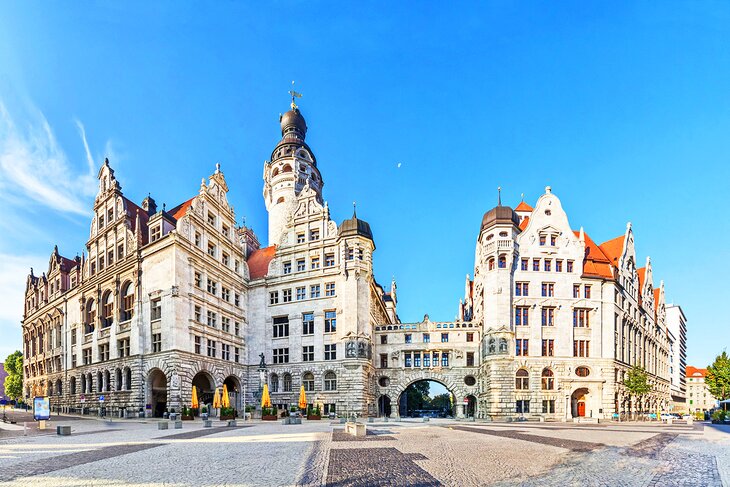
The city's attractions reflect all these and more. Music lovers will find concerts in the magnificent Gewandhaus, home of the world-famous Gewandhaus Orchestra, and in the church where Johann Sebastian Bach served as choirmaster; they can conduct a virtual orchestra at the home of Felix Mendelssohn, and pause for coffee and cake at Coffe Baum, a favorite of Schumann, Grieg, and Wagner.
The Leipzig zoo, one of Europe's best, is a favorite place to go with children, and families will also enjoy the ample parks. For tourists, it is a very manageable city, with many things to do right in the compact Old Town. If traveling by train, you will arrive at the grand Leipzig Central Station right in the heart of the city.
However close its attractions, don't think you can spend just one day in Leipzig — you will want time to see its excellent museums, pause for a concert in one of its churches, and savor the pastries in at least one of the coffeehouses it is famous for. Find the best places to visit with this handy list of the top tourist attractions and things to do in Leipzig.
See also: Where to Stay in Leipzig
1. Markt and Old City Hall
2. hear the music at st. thomas church, 3. st. nicholas church and the miracle of leipzig monument, 4. battle of the nations monument, 5. leipzig zoo, 6. neues gewandhaus, 7. museum of fine arts, 8. forum of contemporary history (zeitgeschichtliches forum), 9. mädlerpassage and naschmarkt, 10. coffe baum coffee museum, 11. mendelssohn house, 12. canoe or bike along the karl-heine canal and weisse elster, 13. grassi museum, 14. the leipzig cotton mill, 15. take a day trip to torgau and hartenfels castle, 16. leipzig university and the paulinum, 17. leipzig botanical garden, where to stay in leipzig for sightseeing, map of attractions & things to do in leipzig.
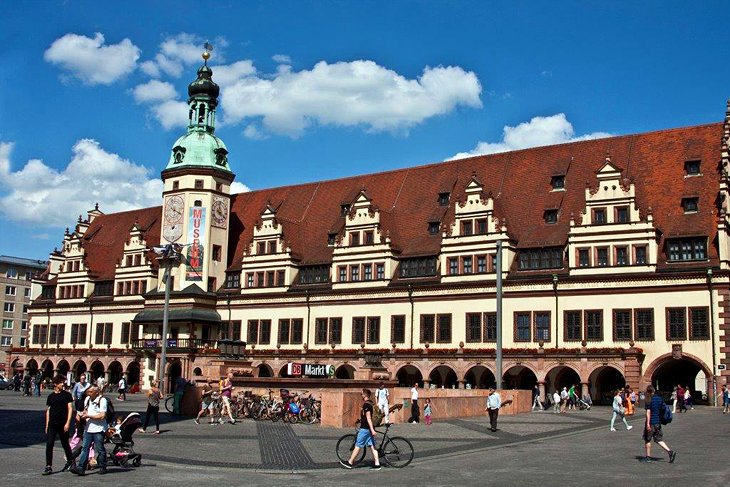
The Markt in Leipzig, for many centuries the hub of city life, is dominated by the Old City Hall (Rathaus), a Renaissance building erected in 1556 and considered one of the most beautiful Renaissance buildings in Germany . The tower, with its Baroque crown, is placed asymmetrically over the main entrance, above which is a roofed balcony used for public proclamations, often involving trumpeters in traditional costumes.
The colonnades along the front were built in 1907, replacing the wooden shops and booths that once stood here, but you'll still find shops under the arcade. Inside the Rathaus is a museum filled with artifacts and pictures from Leipzig's history, from its medieval fairs to the 1989 "peaceful revolution."
The large square is the scene of a farmers market , and during the city's many music festivals (the annual Bach Festival fills the city's churches and concert venues with music each June), it is fitted with a stage for performances.
Address: Markt 1, D-04109 Leipzig
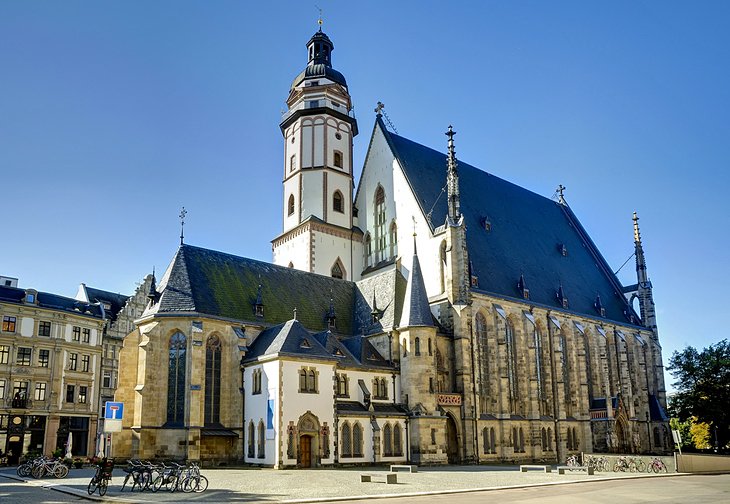
Southwest of Leipzig's Markt stands St. Thomas Church (Thomaskirche), home of the world-famous St. Thomas Boys' Choir . The choir dates from 1212, the year the church was built. Originally serving as an Augustinian monastery, St. Thomas was altered in later centuries, and in the 15th century was given the form of a Late Gothic hall-church, a style popular in Upper Saxony.
The west front dates from renovation work carried out between 1872 and 1889. Martin Luther preached here in 1539, and the church choir became a center of Protestant sacred music. Frequent choir and organ concerts, twice-weekly motets, Bach Passion concerts, and the Christmas Oratorio draw music lovers to St. Thomas throughout the year.
Johann Sebastian Bach was the church's choirmaster from 1723 to 1750, and his remains are interred here. Outside the church in a small square stands a statue of Bach, commemorating his years as choirmaster. Opposite the church is the Bosehaus , home of the Bach Research Institute and Memorial and the Bach Archives.
Address: Thomaskirchhof 18, 04103 Leipzig
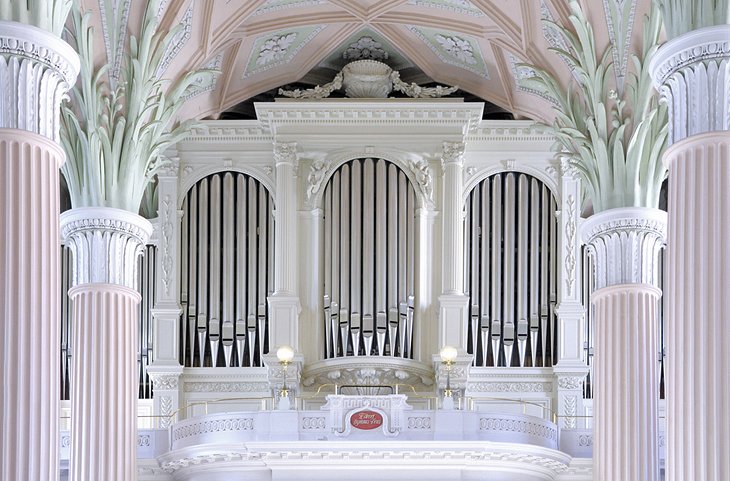
Built in the 12th century, St. Nicholas Church (Nikolaikirche) has been altered in various ways over the centuries, the most recent transforming its interior into the Neoclassical style in the 1700s. The entire interior is white, and its fluted columns rise to capitals from which palm fronds seem to spring out and support the groined ceiling.
It's a surprising flourish to an otherwise Neoclassical interior. Several works by Johann Sebastian Bach , who was music director both here and at St. Thomas Church, premiered here, and the church's organ is known for being one of the finest in Europe.
In the Nikolaikirchhof square outside, a monument echoing the design of the columns and their palm capitals commemorates the church's role as the rallying point for demonstrations against communist rule in East Germany in 1989. This uprising, known as Monday Demonstrations , began spontaneously, not planned or organized, in Leipzig following the weekly Friedensgebet (prayer for peace) in the St. Nicholas Church on September 4, 1989.
These continued each Monday, to the growing alarm of the communist government, until on October 9 about 70,000 peaceful demonstrators carrying lighted candles faced an armed security force of 8,000, who had been given orders to shoot. The size of the crowd and their non-violence convinced the forces not to fire, and the result became known as the Miracle of Leipzig . As news of the night spread, similar demonstrations were repeated in other East German cities, eventually leading to the reunification of Germany.
Address: Nikolaikirchhof 3, 04109 Leipzig
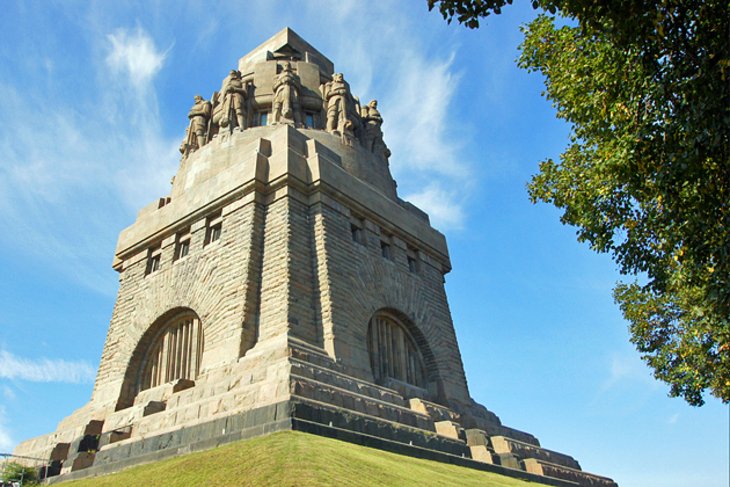
One of Germany's most important monuments — and a leading example of the Wilhelmine school of architecture — is the imposing Battle of the Nations Monument, the Volkerschlachtdenkmal. The largest war memorial in Europe, it was completed in 1913 to commemorate the 100th Anniversary of Napoleon's defeat at the Battle of the Nations in Leipzig in 1813.
On this battlefield, nearly 600,000 soldiers clashed in the largest battle in Europe prior to World War I. Napoleon's army was decisively defeated and forced to retreat to France, eventually leading to his exile to Elba the following year.
Heroic statues, 12 meters tall, surround the monument and its interior chamber, and there's a spectacular view from the viewing platform, 91 meters above (it's a long climb and there is no elevator). Below the monument is a museum about the Battle of Leipzig, illustrating the equipment and the military life of the soldiers who fought here. The monument is a 15-minute tram ride from the city center.
Address: Straße des 18 Oktober 100, 04299 Leipzig

More than just a day's outing for children, Zoo Leipzig is among Germany's best, where 850 different animal species live in habitats very close to their natural homes. Here, you can watch through an underwater glass wall as elephants swim, be greeted by the calls of black howler monkeys, see penguins play, look for alligators in the murky re-creation of the Everglades and find shy koalas lazing in their own eucalyptus forest.
In tropical environments, meet Germany's only Komodo Dragon , a lizard that can grow up to three meters long; drift in a boat through a rainforest inhabited by 100 exotic animal species; walk jungle paths; or get a bird's-eye view across the lush green canopy from the treetop trail. More than 24,000 plants create a tropical environment, where you can also see a garden with 60 exotic fruits and spices growing.
Enter a volcano tunnel to meet living fossils, creatures that look just as they did millions of years ago, or watch Amur tigers — the world's largest cats — in a Siberian landscape. Sit on the terrace of the Kiwara Lodge to enjoy the panoramic view of the savannah as giraffes munch on leaves and zebras gallop past ostriches, oryx, gazelles, and flamingos.
Added in 2017, the high-mountain landscape of the Himalayas is home to the zoo's snow leopards and red pandas , and the renovated walk-in aviary housing griffon vultures. One of Germany's largest aquariums holds an underwater world of colorful fish and living corals, where reef sharks and other species swim in circles around visitors.
Address: Pfaffendorfer Str. 29, Leipzig
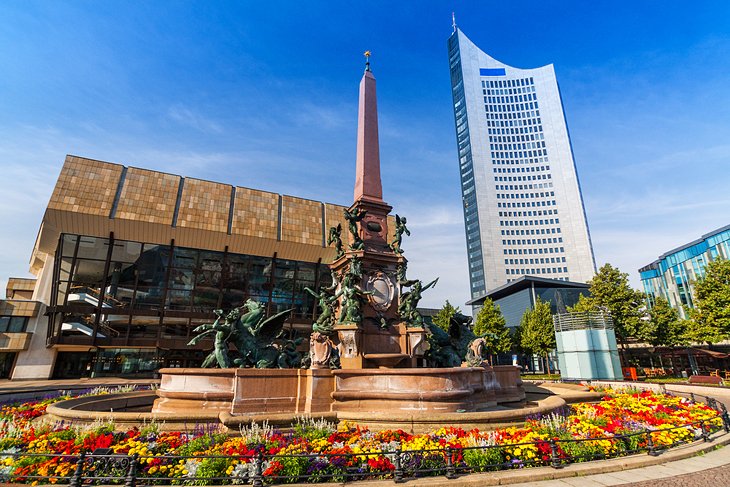
Immediately east of the University in Leipzig is the Gewandhaus, the magnificent home of the world-famous Gewandhaus Orchestra . Built in 1981, the three-story hall is decorated with paintings by modern artists and is well known for its excellent acoustics.
In the Grosser Saal, the main concert hall is one of the city's two Schuke organs (the other is at St. Thomas Church). In addition to its first-rate concert program, the hall hosts organ concerts during the Bach Festival in June and a number of other special events.
Address: Augustusplatz 8, 04109 Leipzig
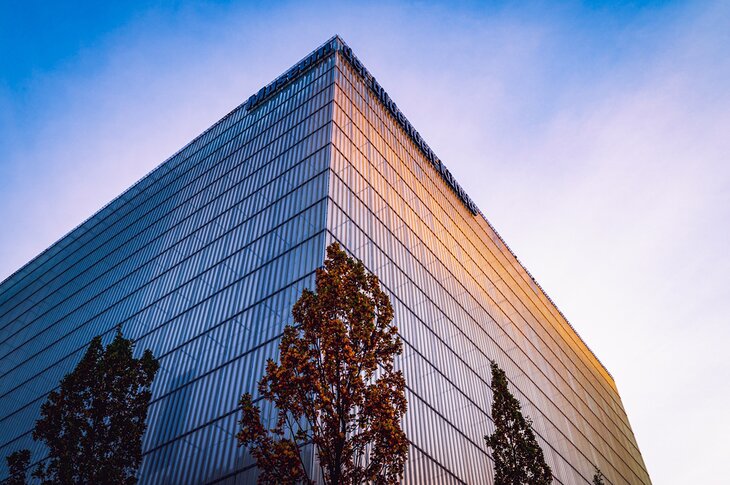
Although housed in one of Leipzig's newest architectural wonders, the Museum of Fine Arts (Museum der bildenden Künste) was in fact founded in 1837 and only settled into its new large-cubed home in 2004. One of Germany's most important national cultural institutions, the museum contains more than 3,500 paintings from the Middle Ages to the present, including works by Dutch, German, and Italian Masters.
While the museum displays few works by "big name" Old Masters — works by Frans Hals and a unique collection of 18 works by the two Lucas Cranachs being the exceptions — the collection of more than 400 paintings by 17th-century Dutch artists is exceptional in showing the development of this school.
More than 700 19th-century German works illustrate the progression from Classical to Romantic to Impressionism to Symbolism. The collection of 55,000 drawings and graphics includes works by William Hogarth, Daniel Chodowiecki, and Anton von Dyck, and the museum holds the definitive collection of works in all genres by Max Klinger , including 70 sculptures.
The building itself is a glass cube, 36 meters high, with its courtyards and terraces, where some of the larger three-dimensional works are displayed, visible from the outside. Its design is intended to reflect Leipzig's traditional passages.
Address: Katharinenstrasse 10, 04109 Leipzig
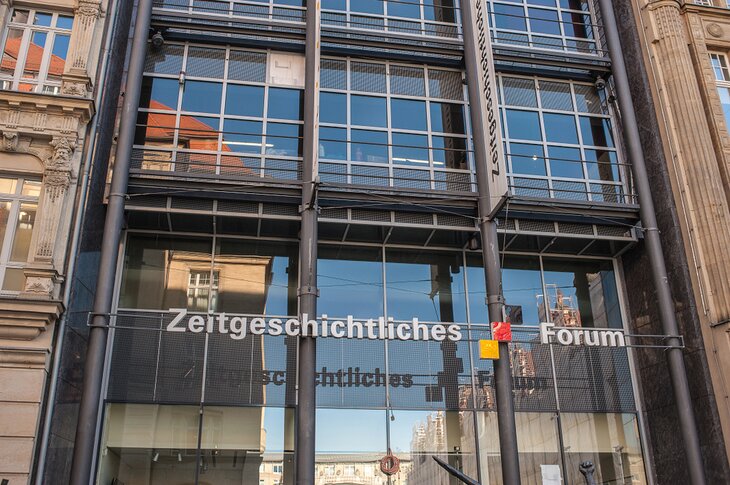
Through objects, photographs, recorded accounts, films, and thousands of artifacts, the Forum of Contemporary History tells the story of Germany from the end of World War II in 1945 until the Peaceful Revolution of 1989 and the subsequent reunification of Germany.
There is a heavy focus on everyday life for Germans under the communist dictatorship in the Soviet Occupation Zone, and on the opposition and civil disobedience to the repression of the Socialist Unity Party.
Permanent exhibitions examine the changes and challenges that reunification brought and consider the influences of globalization, international terrorism, and the digital revolution on the process of melding the two societies that had lived under such different economic and governmental systems.
If you are interested in a further look at Germany under the Communist occupation, visit the Stasi Museum and Memorial in the former headquarters of the "Stasi," the oppressive secret service of the former GDR. Admission to both museums is free.
Address: Grimmaische Str. 6, Leipzig, Germany
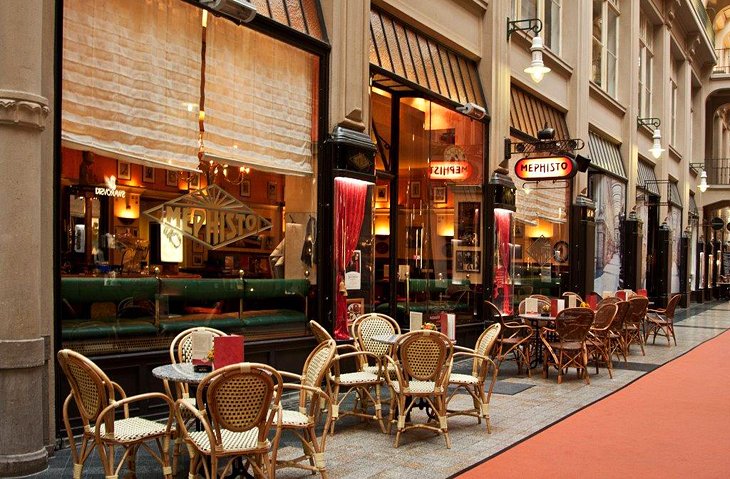
Opposite one end of the Old City Hall is the entrance to the Mädlerpassage , one of the charming old shopping arcades that tunnel through buildings in the heart of the old city. It leads to two other passages, Königshofpassage and Messehofpassage. Originally connecting merchants' houses and shops in the trade fair days, these covered alleyways protected tradesmen from the weather, and gradually they became the elegant arcades they are today.
Other European cities have such passages, but nowhere else is such an extensive network preserved. These covered streets are worth exploring for the shops, cafés, and restaurants they hide, and for their fascinating décor. At several points, they open out into covered courtyards, and elsewhere smaller passages intersect.
Decorations range from a beautiful tooled leather ceiling to a courtyard with modern tile artwork. In the Mädlerpassage, look for the statue of Faust and Mephistopheles in front of Auerbach's Keller , one of the most popular restaurants in Leipzig and where Goethe set the infamous cellar scene (Goethe was a frequent guest of the Keller, as was Martin Luther).
Opposite the entrance to the Mädlerpassage, behind the Old City Hall, is the Naschmarkt, a quiet little square laid out in 1556. On the north side is the Old Commercial Exchange (Alte Handelsbörse), an Early Baroque building dating from 1678.
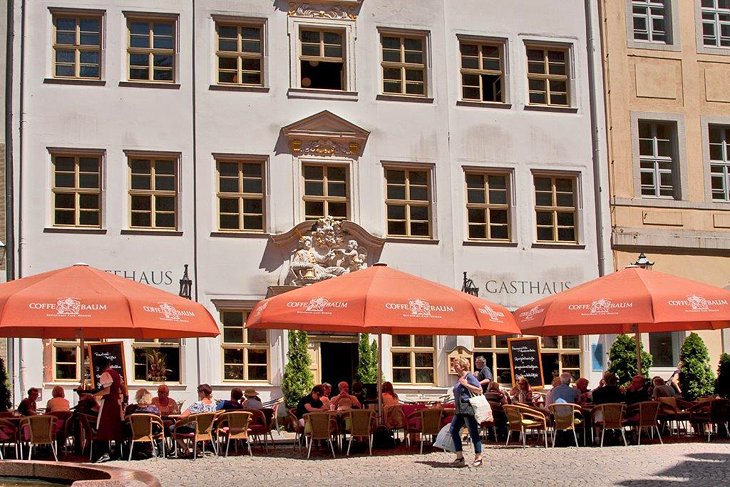
One of the oldest coffee shops in Europe still in its original form, Coffe Baum opened in 1717.
Coffe Baum honors that heritage with a museum of coffee that fills 15 rooms on the upper floors of the historic building. More than 500 artifacts trace the history of coffee itself and the rise of the coffee house culture in Saxony — where many believe the German obsession with coffeehouses began.
Displays include roasters, various methods and machines for brewing coffee, vintage containers and advertising, early porcelain coffee cups, and the leather cases made to protect them. The museum is free, but you won't be able to pass the display case in the café without stopping for a slice of their signature Baumkuchen.
Address: Kleine Fleischergasse 4, 04109 Leipzig
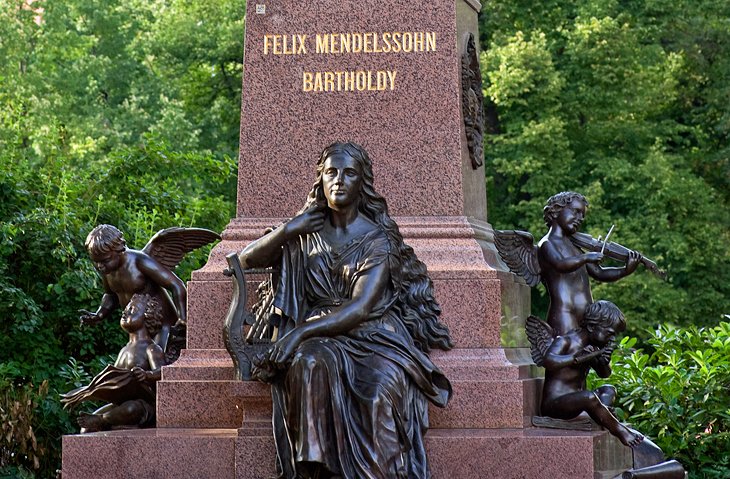
The Mendelssohn House in Leipzig is the only authentically preserved residence of the great composer, Felix Mendelssohn Bartholdy. Originally built in 1844, and occupied by the composer and his family from 1845, the house has been restored according to the original plans and furnished in the late Biedermeier style popular at the time.
In his study and music salon are personal belongings, sheet music, and watercolor paintings by Mendelssohn, as well as documents and displays relating to his life and work.
In 2014, new interactive features were added to the museum, including a video library and the "Effektorium" — a conductor's podium where visitors can conduct a virtual orchestra. The music salon is used, as it was in Mendelssohn's days, for weekly Sunday Concerts, Leipzig's Piano Summer. A statue of Mendelssohn stands in a small park outside St. Thomas Church .
Address: Goldschmidtstrasse 12, D-04103 Leipzig
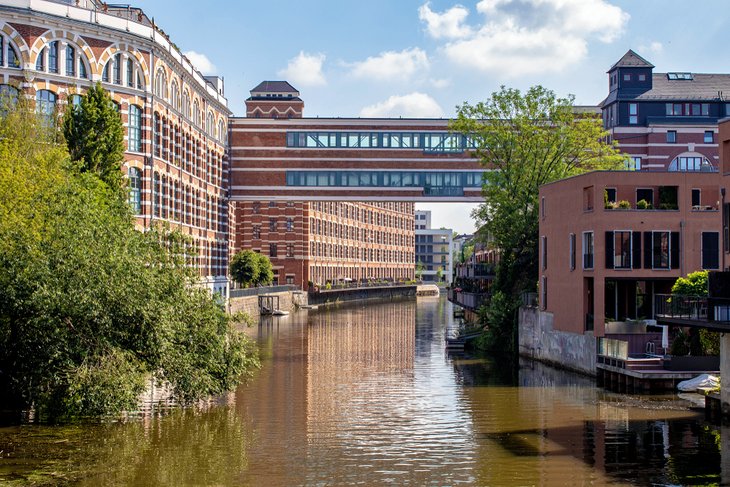
The Karl-Heine Canal leads from the river Weisse Elster through the old industrial district of Plagwitz, past beautiful brick industrial buildings and under tree-lined banks. The canal, Weisse Elster, and other waterways form an interlocking system of natural rivers and canals, a web of opportunities to discover another side of Leipzig.
The canal and some rivers are bordered by walking and bicycle paths, and wind through residential, industrial, and natural areas.
Waterside landmarks include the beautiful brick Buntgarnwerke Leipzig, built in 1875, Europe's largest architectural complex in Wilhelminian style. You can paddle under massive stone arched bridges, past the 1867 racecourse at Scheibenholz, and the impressive villa of the Baedeker family of guidebook fame.
Rent kayaks at Stadthafen Leipzig, the city's harbor, to paddle on your own, or join a canoe tour at the harbor to discover the waterways with a guide. You can rent bicycles at the harbor or at other locations around the city, or contact either nextbike or the Deutsche Bahn's Call a Bike service.
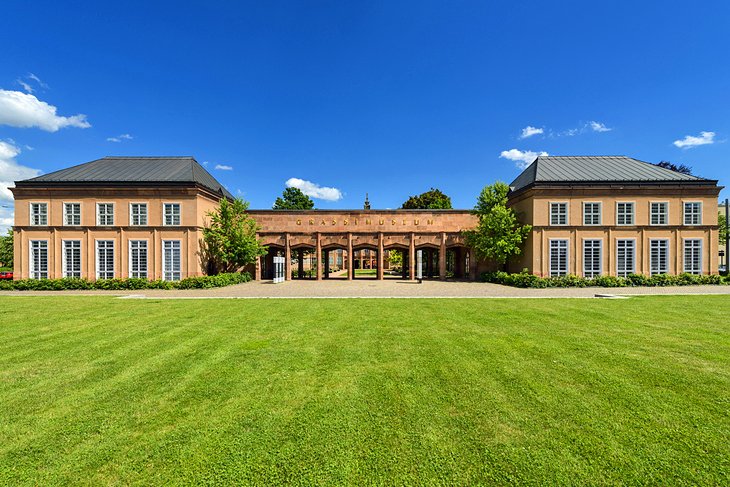
The Grassi Museum was established in 1895 and moved to its current home in 1929. The building is in fact three excellent museums in one, housing the city's ethnography, applied and decorative arts, and musical instrument collections.
The Museum of Musical Instruments is a particular favorite for visitors and includes instruments from the Middle Ages to the 20th century, as well as hands-on sound laboratories and extensive archives. Be sure to take a stroll through the city's impressive train station. Built in 1915, it is the largest railroad terminal in Europe.
Address: Johannisplatz 5-11, 04103 Leipzig
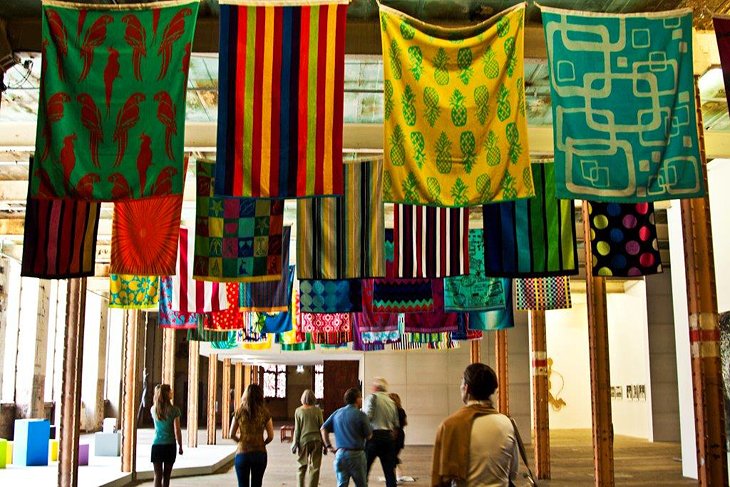
An area that's becoming increasingly interesting to explore is the Leipziger Baumwollspinnerei, the Leipzig Cotton Mill, in the district of Lindenau. This 10-hectare former industrial site was an important commercial center focusing on the cotton trade. At its peak before WWI, the complex formed a complete community that included 20 factories, homes, schools, and parks, along with more than 240,000 spindles.
In the past two decades, the Spinnerei has been transformed into a cultural destination, with art galleries, vast exhibition spaces, art studios, and workshops. About 100 artists, including fashion and other designers, printers, potters, sculptors, a goldsmith, and porcelain manufacturer, have settled here, and the complex is also home to a café, restaurants, and a film club.
The largest of the Spinnerei buildings has become a non-profit center for contemporary art , and the entire complex is the epicenter of Leipzig's vibrant art scene and the "New Leipzig School." A highlight of the complex is what may be Europe's largest and most comprehensive art supply store , a vast supermarket of art and craft materials and tools; an entire wall is devoted to brushes alone. To get there, take tram 14 from Leipzig Bahnhof to the S-Bahn Plagwitz station.
Address: Spinnereistraße 7, 04179 Leipzig
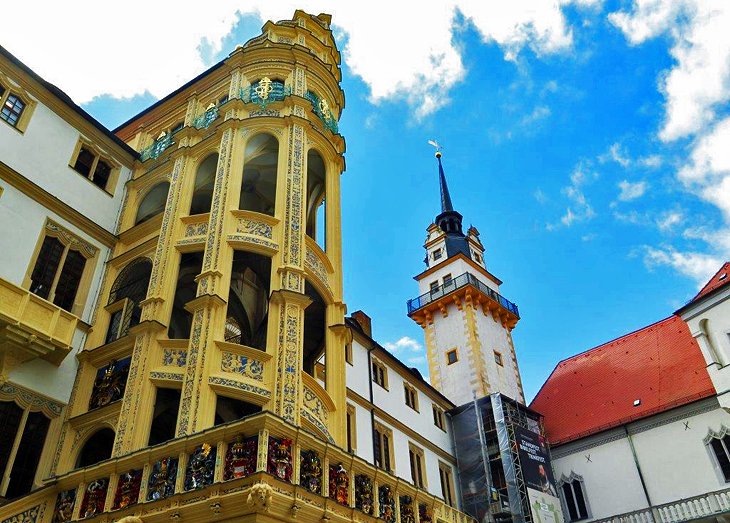
About an hour from Leipzig by car or 45 minutes by train, the hilltop town of Torgau is one of the major sites connected with Martin Luther and the Reformation . It was the political center of the Reformation, where Luther wrote some of his most significant works. The first Protestant songbook was published here, and it was where the Protestant rulers signed the Torgau League of Princes.
The town is dominated by the early Renaissance Hartenfels Castle , and it was in its wing that the world's first Protestant church was built, according to Luther's ideas, and consecrated by him in 1544. A beautiful spiral staircase rises from its broad courtyard, constructed without a central supporting column. The staircase and the Schöner Erker, a richly decorated oriel window dating from 1543, have been restored to their Renaissance splendor.
Luther's wife, Katharina von Bora, died in Torgau, and her grave memorial is one of the treasures of the church of St. Marien . Her house, where she died in 1552, is a museum, one of more than 500 late-Gothic and Renaissance buildings in Torgau. The beautifully decorated City Hall overlooks Torgau's market square, surrounded by other restored Renaissance buildings.
A monument in Torgau commemorates the meeting here of eastward-advancing US troops and westward-moving Soviet troops on April 25, 1945, signaling the approaching end of World War II.
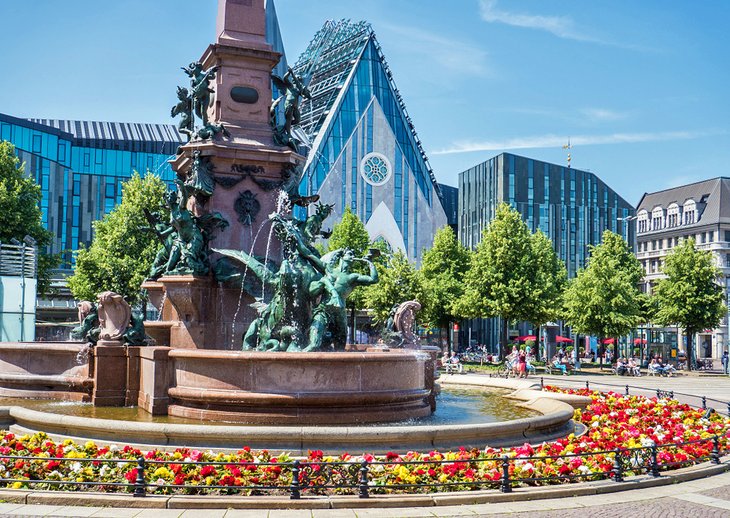
The dominant feature in Augustusplatz is the 34-story building occupied by Leipzig University, with its lofty café, Panorama Tower - Plate of Art, at 110 meters above the city. One of the world's oldest universities — and the second oldest in Germany — Leipzig University was founded in 1409, and more than 60 percent of its buildings were destroyed in World War II.
Surviving the war undamaged, only to be destroyed by dynamite in 1968 under the Soviet occupation, the Paulinerkirche was built in 1231 for the Dominican monastery and inaugurated by Martin Luther in 1545 after the Protestant Reformation.
In 2007, construction began on the Paulinum, in the exact location of the former church and reflecting its Gothic architecture.
Inside the Post-modern exterior, the soaring nave reflects its Gothic predecessor with rows of reeded columns rising to an intricate vaulted ceiling. The Paulineraltar, the Gothic altar , was saved from the original church and, along with several large polychrome sculptural works, relieves the stark white of the interior. The hall is now used primarily as a concert venue.
The university is home to four museums: the Egyptian Museum ; the Museum for Musical Instruments ; the Museum of Antiquities ; and the University Art Collection , with paintings and sculptures dating back to the Middle Ages.
Incorporated in the lecture theater block is the Schinkeltor from 1836 and the surviving entrance to the old university, the Augusteum. Of interest nearby is the old Moritzbastei , a bastion dating back to 1515 and the only relic of the town's old fortifications.
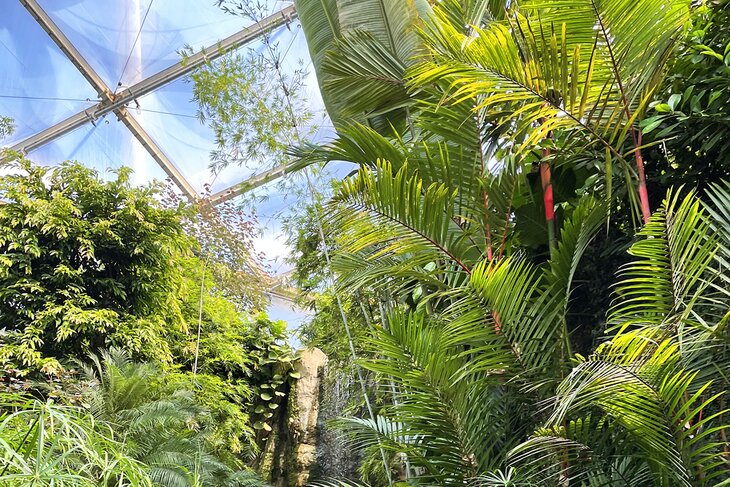
The Leipziger Botanische Gärten can trace its roots back as far as 1542 as the medicinal plant garden for the former Dominican monastery of St. Paul, in Augustusplatz. It was re-established at the current site in 1877.
Despite devastation during World War II, this nine-acre site features 4,500 species of plants representing in 1800 genera, with examples from Eastern Europe, North America, Asia, and South America. Highlights are the herb garden; the "scent and touch" garden; and the series of large greenhouses with cacti, subtropical, and tropical plants from around the world.
Address: Linnéstrasse 1, 04103 Leipzig
The Rathaus, the old city hall in Leipzig, lies between the historic squares of the Naschmarkt and the larger Markt. Around these attractions are St. Nicholas Church and several of the fine old shopping arcades that characterize the historic center of the city. The train station is conveniently nearby. Here are some highly-rated hotels in the old center of Leipzig:
Luxury Hotels:
- In a historic building with modern amenities that include a spa with a sauna and steam room, Steigenberger Grandhotel Handelshof is right in Naschmarkt and next to St. Nicholas Church.
- With a pool, parking, and elegant rooms, Hotel Furstenhof, a Luxury Collection Hotel, Leipzig is equidistant between the Hauptbahnhof (rail station) and the Markt.
- Also with a fitness area and pool, Leipzig Marriott Hotel is a block from the Markt and two blocks from the Hauptbahnhof, close to the shopping streets.
Mid-Range Hotels:
- Opposite St. Thomas church and a five-minute stroll from the Markt and Old City Hall, INNSIDE Leipzig is one of the city's newest hotels, an excellent value with upscale and contemporary rooms at moderate rates.
- Radisson Blu Hotel Leipzig is at the outer edge of the old town center, a 10-minute walk from the train station and two minutes from the pedestrian shopping streets. For those concerned with sustainability, this is a Certified Green Hotel.
- Close to the train station, shops, and restaurants and an easy walk to the historic center, pentahotel Leipzig has a Club Level, which includes breakfast and dinner.
- Opposite the Hauptbahnhof and two blocks from the Markt, Seaside Park Hotel Leipzig is surrounded by restaurants.
Budget Hotels:
- A block from the train station and a 10-minute walk to the old town center, IntercityHotel Leipzig is only five minutes from the zoo.
- Three blocks from the Markt, BEST WESTERN Hotel Leipzig City Center faces a side entrance of the rail station.
- Art Hotel City Leipzig has spacious, well-decorated rooms, about a five-minute walk from the train station and 10 minutes from the old center.
More Related Articles on PlanetWare.com
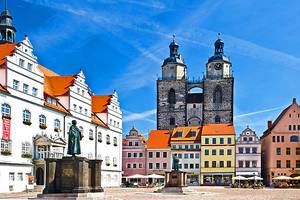
Places to Visit near Leipzig: Several fascinating cities are within an easy day trip from Leipzig. A 30-minute train ride takes you to the old university town of Wittenberg , the birthplace of Martin Luther's Reformation. A 40-minute train ride west of Leipzig, Erfurt also has connections to Martin Luther and has an interesting Jewish history as well.
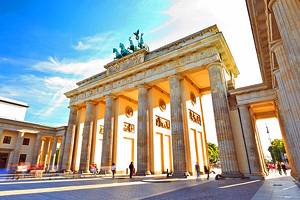
Where to Go Next : Leipzig sits almost equidistant from eastern Germany's two most important cities, Dresden , with its magnificent palaces, and Germany's capital, Berlin , with its many museums and art galleries , both places you will want to spend some time exploring.
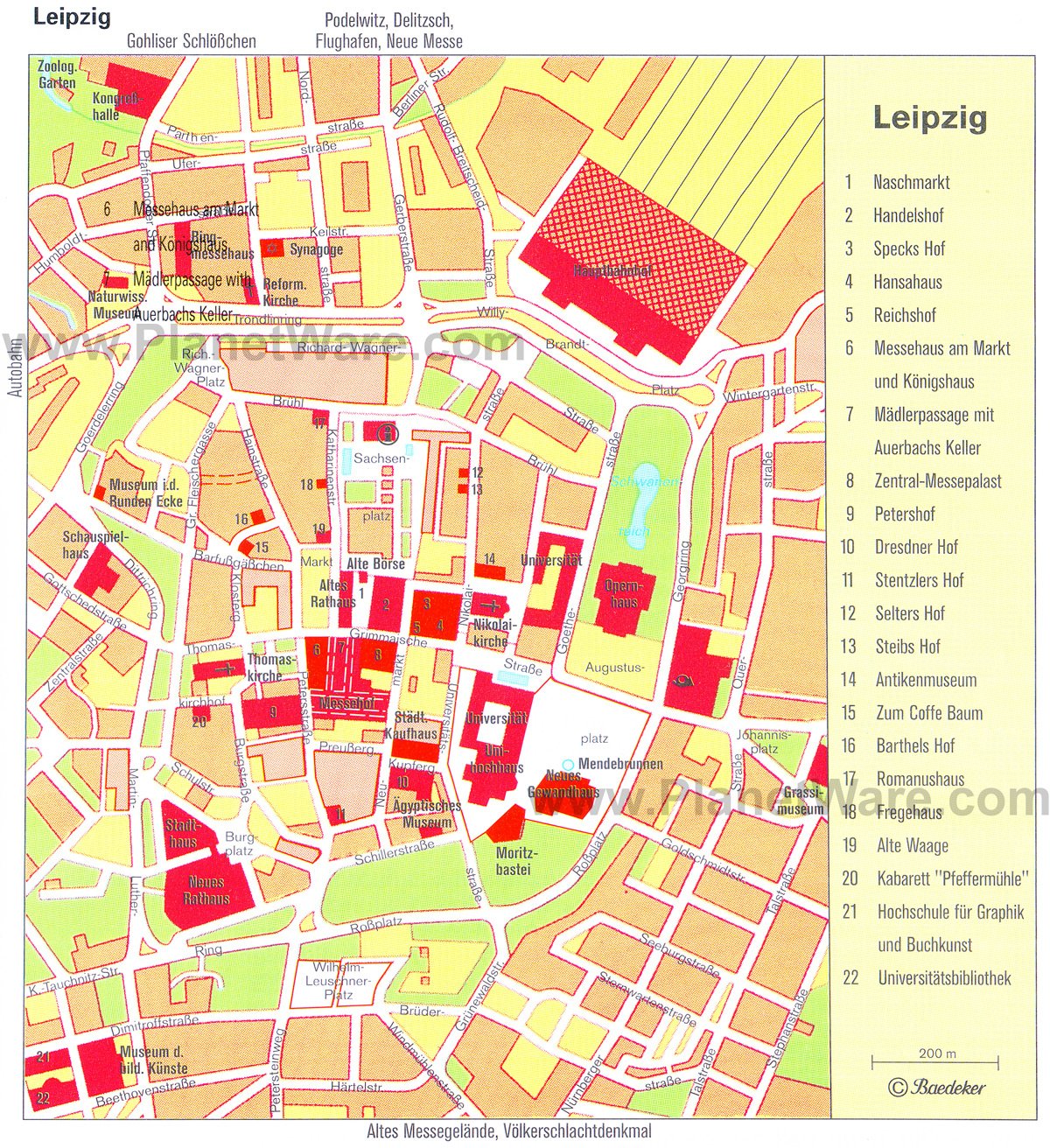
More on Germany


Home » Travel Guides » Germany » 15 Best Things to Do in Leipzig (Germany)
15 Best Things to Do in Leipzig (Germany)
Having long been a centre for trade, culture and learning, the city of Leipzig was where East Germany’s Peaceful Revolution gained traction in the 1980s. The Monday Demonstrations were held at St. Nicholas Church, blooming into a peaceful protest movement that eventually toppled the GDR’s government.
Long before then, the composers Johann Sebastian Bach and Felix Mendelssohn were Leipzig residents, and there are compelling visitor attractions for both figures. The city was founded in the 11th century at the intersection of two key trade routes, the Via Imperii and the Via Regia. So it was natural that during the Medieval Holy Roman Empire Leipzig made name for its international trade fairs. That tradition persists today at the Leipzig Messe, the exhibition halls to the north of the city.
Let’s explore the best things to do in Leipzig :
1. St. Thomas Church

Between 1723 and 1750 Johann Sebastian Bach was the cantor at this 13th-century Gothic church.
It has also been Bach’s burial place since 1950, and you can find his ledger stone on the floor of the choir and see a statue in his honour outside in front.
The St. Thomas choir is still one of the most prestigious in the world, and you can come to hear them on Fridays, Saturdays on Sundays.
Following the concert on Sundays you can take a tour of the Baroque tower, which was finished in 1702. Richard Wagner was also baptised in this church, while around 20 years earlier in 1789 Mozart played the organ here.
2. St. Nicholas Church

This Gothic and Baroque Church was the scene of the Monday Demonstrations that eventually helped reunite Germany.
With less of a Stasi presence than Berlin, and regular foreign visitors for the Leipzig Messe (Trade Fair), Leipzig was the first large city in the GDR to have peaceful anti-government protests in 1989. And because the church backed those protesters, holding a prayer for peace every Monday since 1982, St. Nicholas was the venue for the demonstrations.
In the space of a few weeks the numbers had swelled from a few hundred to 120,000 by 16 October 1989. And when the security forces failed to intervene the movement had the momentum to bring down the Berlin Wall a month later.
Going back 250 years, St. Nicholas was also where Bach premiered many of his pieces including the seminal St John Passion.
3. Museum der Bildenden Künste

Leipzig’s fine arts museum reopened in 2004 in a bold glass cube in the centre of the city on Katharinenstraße.
The previous building had been wiped out in the war, although the most valuable art had already been stored away.
With art from Medieval times to today, one of the museum’s strong points is its works by German Renaissance masters like Lucas Cranach the Elder and Frans Hals.
Later, Caspar David Friedrich’s painting, the Stages of Life is one of the masterworks of the German Romantic movement.
At the new building’s inauguration in 2004 the museum also received a donation of over 40 pieces of 19th-century French art, running the gamut from Delacroix and Camille Corot to Impressionists like Monet and Degas.
4. Völkerschlachtdenkmal

A lasting piece of Wilhelmine architecture is this monument to the Battle of Leipzig.
The battle took place in 1813, and brought about one of Napoleon’s final defeats, against a coalition of armies from Russia, Prussia, Austria and Sweden.
Over 600,000 fought at Leipzig, making it the largest battle until the First World War.
The monument was inaugurated on the battle’s centenary in 1913 and is still one of the tallest war monuments in Europe at 91 metres.
It has a concrete frame clad with granite and is on two storeys.
The first is a crypt decorated with eight statues representing fallen soldiers, accompanied by Totenwächter (Guardians of the Dead). On the upper storey are four 9.5-metre statues symbolising the idealised German qualities of faith, fertility, bravery and sacrifice.
5. Zeitgeschichtliches Forum

This museum is all about East Germany from 1949 to Reunification.
The permanent exhibition documents all aspects of life in the GDR under the repressive SED (Socialist Unity Party) regime.
There are 3,200 exhibits like personal accounts, excerpts from speeches, propaganda posters, jerseys worn by the GDR national football team, communications equipment, art, consumer products, photographs, medals and archived documents.
A big slice of the exhibition handles the resistance and civil courage leading up to the Monday Demonstrations and the fall of the Berlin Wall.
There are also informative galleries dedicated to life in the former East Germany after Reunification.
6. Bach-Museum

Opposite St. Thomas Church is a museum on the life and work of Johann Sebastian Bach.
Maybe the most exciting exhibition is the treasure room, where music manuscripts hand-written by Bach are kept in glass cases.
These documents are so delicate that they can only be kept on show for a few months at a time before going back into storage, so the display is constantly rotated.
There are also musical instruments like the console of an organ that he played, a violone from his orchestra and a viola d’amore designed by his close friend Johann Christian Hoffmann.
You can trace Bach’s family tree and see just how many members of his family were involved in music, as court musicians, cantors, instrument makers or organists.

Whenever you visit Leipzig the chances are that something will be happening on the market square.
The core of the Christmas market is located here, where you’ll find a 20-metre Saxon spruce amid hundreds of stalls.
At other times there are weekly produce markets and an Easter market, while during the Wave-Gothic-Treffen (The world’s largest gothic festival) there are medieval themed stalls and sideshows like jousting in the square.
For architecture, the square is a blend of old and new: The west and south sides are traced by the Old Town Hall and the 16th-century Alte Waag building, which housed the city scales and for centuries was the hub of Leipzig’s trade fairs.
8. Altes Rathaus

Begun in 1556, the arcaded old town is the most beautiful historical landmark in Leipzig.
The Altes Rathaus is considered one of Germany’s best examples of Renaissance architecture, and is embellished with gables, mullioned windows and a tower that is slightly offset to the left.
Under those arcades on the ground floor are all kinds of restaurants, while the building has hosted the Leipzig city museum since 1909. This attraction shows off the town hall’s interiors, examples of period decoration from around the city interiors and dips into Leipzig’s past.
There’s a complete historical model of Leipzig in the monumental Festsaal, remnants of the city hall’s former dungeon, decoration from the destroyed St John’s Church and Roman artefacts.
Don’t miss the hand-written copy of the Sachsenspiegel, the 13th-century law-book and custumal of the Holy Roman Empire, one of the earliest texts in German.
9. Leipzig Zoo

First opened in 1878, Leipzig Zoo has the honour of being one of the oldest in Germany, but it is also one of the most modern.
The attraction has pioneered new habitat concepts like the Gondwanaland biome.
This is a 16,500-square-metre indoor environment where the temperature is a steady 25°C and humidity is kept at between 65 and 100%. The edifice supports all kinds of tropical plants and animals like squirrel monkeys, giant otters, komodo dragons, leaf-cuter ants and a host of fish, turtles and frogs.
Another indoor hall is Pongoland, which opened in 2001 and provides a 30,000-square-metre indoor habitat for gorillas, two groups of chimpanzees, bonobos and orangutans.
10. Museum in der Runden Ecke

On 4 December, less than a month after the wall fell the Monday demonstrators occupied this building which had been the headquarters of the Stasi in Leipzig.
This gesture was one landmark events of the Peaceful Revolution and landed a symbolic blow on the SED government.
Now, a lot of the interior of the building has been kept as it was up to 1989, and the Stasi – Power and Banality exhibition goes into the history and methods of the infamous state security service.
There are tons of documents like confiscated correspondence, along with equipment for doctoring letters, uniforms, shredders, uniforms and all manner of surveillance equipment, from listening devices to cameras.
11. Grassi Museum

On Johannisplatz and Housed in a historically preserved building from the 1920s, combining Art Deco design with New Objectivity, the Grassi Museum is three museums rolled into one.
There’s a Musical Instruments Museum, an Ethnography Museum and maybe most interesting of all is the Leipzig Museum of Applied Arts.
If you have an eye for Art Deco design make for that applied arts museum, which is rich with ceramics, glassware and furniture from the 20s and 30s in the Art Nouveau to the Present Day exhibitors.
There’s also a Roman hall with artefacts recovered from Eythra close to Leipzig.
The musical instruments museum has pieces from the 1500s to the 20th century, while the ethnography museum boasts 200,000 exhibits from East Asia, Southeast Asia, South Asia, Oceania, Australia, Africa, the Americas and Europe.
12. Leipzig Panometer

In the southern suburb of Connewitz, a disused gasometer has been turned into a visual panorama by the Austrian artist Yadegar Asisi.
Fifty metres tall and 57 metres in diameter, the gasometer dates to 1909 and has a brick-built shell.
This building has been showing Asisi’s panoramas since 2003 and they tend to be updated every two or three years.
The images are 30 metres high and 105 metres in circumference.
At the time of writing this post in 2017 the current theme is the Titanic, while past panoramas have depicted the Battle of Leipzig, the Amazon, Ancient Rome and Mount Everest.
Accompanying each panorama is also small exhibition on the given topic.
13. Leipzig Hauptbahnhof

If you’re wondering why a train station should be on the list, Leipzig’s Hauptbahnhof is no typical train station.
First it’s the largest station in the world by floor area, covering 8.3 hectares and with a facade almost 300 metres long.
The station is also a museum, as on track 24 there are five historic locomotives like a Second World War-era DRB Class 52 steam engine and an aerodynamic DRG Class SVT 137 diesel locomotive introduced in the 1930s.
And besides all this the station’s concourse was converted into a three-storey shopping mall 20 years ago, with boutiques and high-street shops under the epic brick arches.
14. Mädlerpassage

In the centre of Leipzig there’s a plush shopping passage between Grimmaische Straße and Neumarkt.
The passage was developed in the 1910 by the leather manufacturer Anton Mädler and designed in an understated historicist style by the architect Theodor Kösser.
Once you step in off the street, the size of the development is astonishing, at four storeys in height and with a length of more than 140 metres.
Within is an extension of the Auerbachskeller, a wine tavern that dates back to the 15th century and counted Goethe as one of its patrons in the 18th century.
And this is joined by up to 40 specialty shops, cafes and restaurants, all in an opulent setting.
15. Mendelssohn-Haus

In a Neoclassical edifice on Goldschmidtstraße is the last and only preserved private apartment belonging to the 19th-century composer Felix Mendelssohn.
The building is from 1844, Mendelssohn moved in with his family in 1845 and passed away here in 1847. The building was turned into a museum for Mendelssohn’s life and work in 1997 on the 150th anniversary of his death.
On display are hand-written documents, watercolours composed by Mendelssohn and original furniture.
The museum was updated in 2014 and a new interactive display allows you feel what it’s like to conduct your own orchestra.
The grounds are also maintained as an historic garden, and the coach house has been converted into a venue for chamber music.
15 Best Things to Do in Leipzig (Germany):
- St. Thomas Church
- St. Nicholas Church
- Museum der Bildenden Künste
- Völkerschlachtdenkmal
- Zeitgeschichtliches Forum
- Bach-Museum
- Altes Rathaus
- Leipzig Zoo
- Museum in der Runden Ecke
- Grassi Museum
- Leipzig Panometer
- Leipzig Hauptbahnhof
- Mädlerpassage
- Mendelssohn-Haus

Germany Footsteps
Top 21 Things To Do In Leipzig [Full Guide]
Going on a Leipzig trip and want to know all the top things to do in Leipzig? We have you covered! Below you will find our guide to all the best attractions in Leipzig Germany to plan your ultimate trip.
One of the major cities in the eastern part of Germany, Leipzig has a long history as an important trade and cultural centre. It’s well known for its musical past as well as the role it played in the Monday Demonstrations and a peaceful end to the German Democratic Republic.
Leipzig is also becoming increasingly known as being a hip centre and “the new Berlin” and there are many reasons to visit here as a tourist.
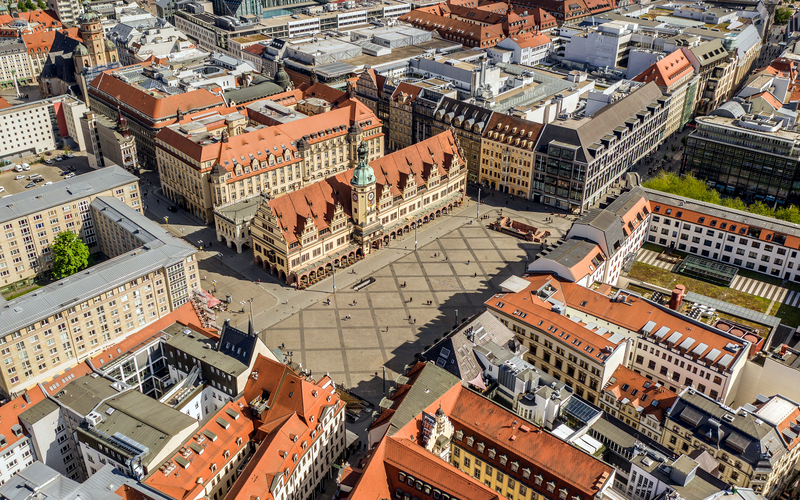
From learning more about the Monday Demonstrations and life in East Germany to appreciating Bach’s music and learning about Leipzig’s Medieval past, there are many answers to what to do in Leipzig and plenty of fun things to do for a few days.
And even thinking beyond the attractions on offer in Leipzig, it is worth a visit here. Leipzig in a fun and vibrant city with plenty to take in and enjoy and we very much enjoyed our time here.
Below, you will find our Leipzig travel blog with everything you need to know about the best places to visit in Leipzig, things to see in Leipzig in winter and Leipzig with kids as well as the best places to stay for your ultimate vacation in Leipzig!! There is also a handy map of all the Leipzig things to do and a one day itinerary if you are short on time.
Traveling to Germany? Click here to download your free Germany Trip Planning checklist . We’ll help you get ready for your trip!
Table of Contents
An Introduction To Leipzig
With a population of over half a million people (and over a million in its larger urban zone), Leipzig is located about 185 kilometres southwest of Berlin in western Saxony. It’s located in a fertile basin that is intensively farmed.
Leipzig first showed up in records in 1015 AD with the name Urbs Libzi. It was well located in the middle of a plain where two major trade routes of central Europe met which helped bring development of the town.
However, it’s believed the area had been first settled in the 5th century BC. Slavic immigrants built a permanent settlement in the 6th century which was called Lipzk in around 800.
1175 was a big year as it’s when the city of Leipzig was officially established.
Leipzig prospered with its two annual markets at Easter and Michaelmas declared imperial fairs in 1497. Leipzig was given economic privileges which helped it grow further – like towns within 15 kilometres were not allowed to hold their own markets.
By around 1700, Leipzig was a major commercial centre with a great network of roads into the town. While its geographic location had been central to its growth, it also had a downside with several battles taking place in Leipzig or nearby including the Battle Of Leipzig (or Nations) in 1813 as part of the Napoleonic Wars.
Leipzig’s economic growth also lead to cultural growth and Leipzig is especially known for its printing industry and musical past thanks to Johann Sebastian Bach and many others. It’s still a musical hub today.
Trade was the most important economic activity and when the first long distance railroad in Germany opened in 1839 between Leipzig and Dresden, things grew even further.

About a quarter of Leipzig was destroyed in World War II. After the war, it became part of the German Democratic Republic (East Germany) and the city was rebuilt. Leipzig’s trade fairs returned but being part of the German Democratic Republic was not great for Leipzig with its mix of industries and services before the war thinned out so it was left with primarily heavy industry.
Leipzig played a role in the reunification of Germany and is known as the Stadt der Helden (City of Heroes) because of this. The Monday demonstrations took place starting on the 4th September 1989 and were weekly peaceful mass protests against the East German government.
While they didn’t just take place in Leipzig, they started here before growing to other cities and towns in the country and kept growing in size. They were integral in the reunification of Germany.
The time after this was hard for Leipzig with the heavy industry in the area largely closing and within six years, 90% of jobs in the industry had gone. Many people left Leipzig at this time.
In 2000, an urban-renewal plan saved Leipzig from decline and managed to reverse it by improving the historic centre of the town, improving urban infrastructure and attracting new industry.
Today, Leipzig is a major industrial centre and a transport hub. It’s reversed its fortunes and again is an important economic centre. It’s one of Germany’s fastest growing cities and is known for being hip and as “the new Berlin”. It offers a lot for tourists and it’s a fun place to explore.
Top 17 Things To Do In Leipzig Germany
Here are the best things to do Leipzig offers. Read through and select the ones that fit your interests and timeframe. If you only have one day to visit Leipzig Germany attractions, find our one day places to see in Leipzig itinerary below.
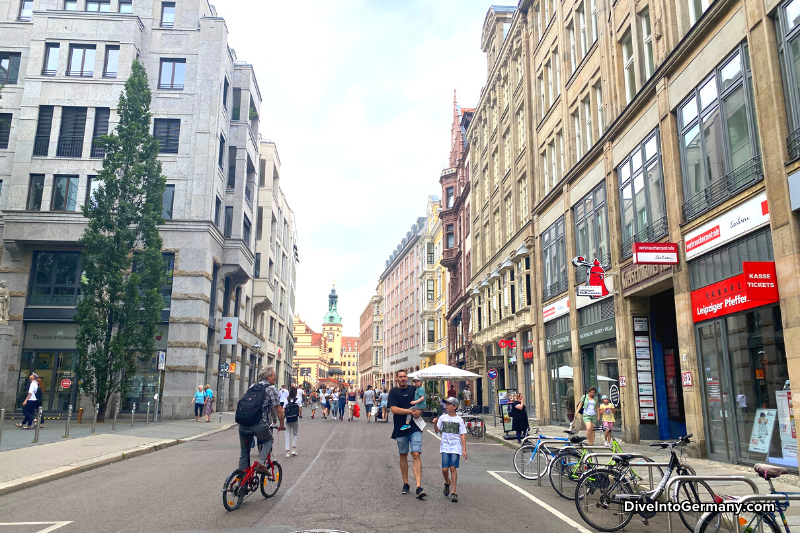
The best place to start exploring Leipzig is definitely in its Old Town. Thanks to not being as decimated as many other cities in Germany in World War II, it has more pre-war buildings than most.
Marktplatz (next on this list of Leipzig things to see) is the perfect place to start and many of the attractions in this list are located in the Old Town.
The Old Town is compact and this makes it perfect for tourists. You can see and experience a lot on foot without much walking. It makes things very easy.
So take some time to stroll around and examine the architecture and take in the vibe while visiting the Leipzig things to do below that interest you most as you explore.
Marktplatz (Market Square)
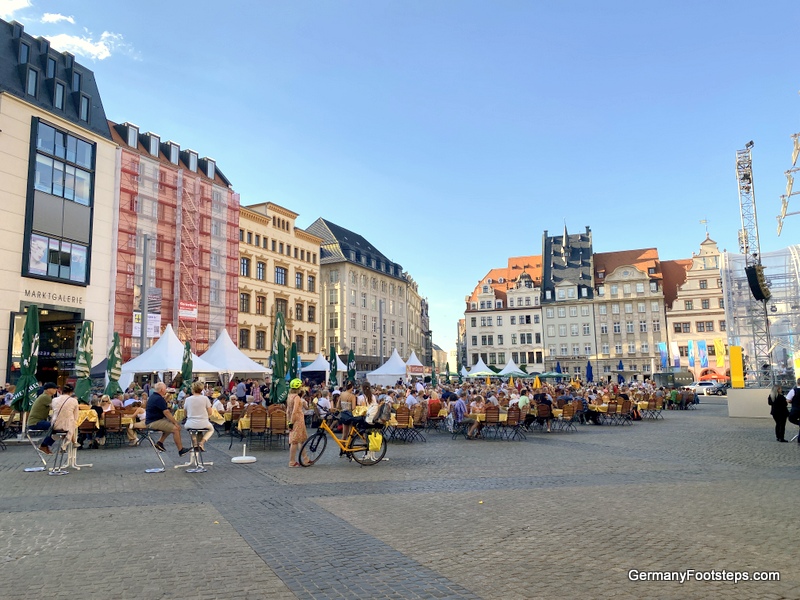
The heart of the Old Town, you definitely won’t want to miss this as you explore Leipzig. Take a seat, have a drink or a meal and soak it all in!
The architecture around the square is a blend of old and new. You’ll notice the Old Town Hall (more below) and the 16th century Alte Waag building is also worth checking out.
Many events take place in this square and if you plan your visit well, you may get to enjoy ones like the Christmas Market, Easter Market or the Wave-Gothic-Treffen, a big festival for “dark music” and “dark culture”. There are also weekly produce markets.
Leipzig Altes Rathaus (Leipzig Old Town Hall)
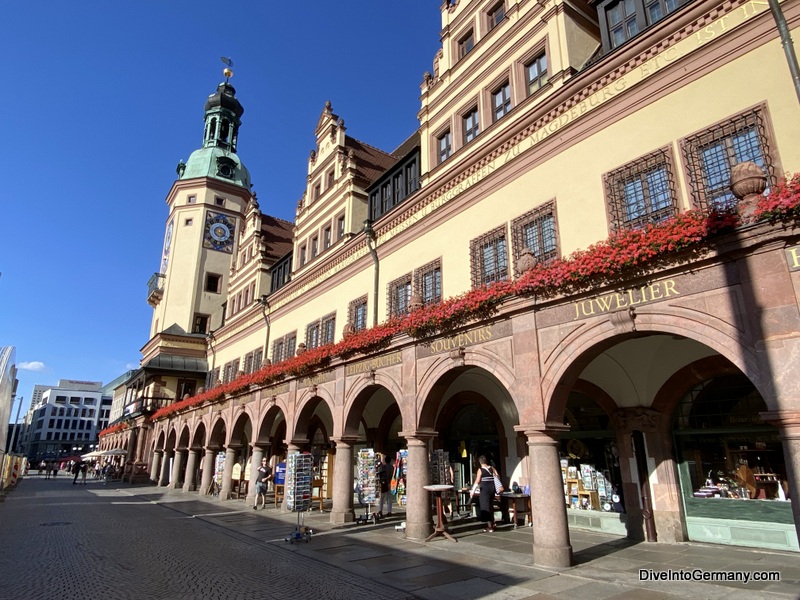
My favourite building in Leipzig, the Altes Rathaus (Old Town Hall) was built in 1556-1557. It’s a great example of German Renaissance architecture and is quite a landmark with its windows, gables and tower.
Restaurants are at home on the ground floor and the city history museum (coming up next on this list of Leipzig places to see) is inside. Visiting the museum is the best way to see the interior and period decoration.
But whether you want to go inside to the museum or not, examining the outside should definitely be on your list of things to do in Leipzig today.
Stadtgeschichtliches Museum ( City History Museum)

The best way to see inside the Old Town Hall, Stadtgeschichtliches Museum is worth visiting in its own right. This is the place to go to learn all about Leipzig’s history from Medieval times to now. Leipzig has a very interesting history, and I enjoyed discovering it here.
There are two floors with around 2,000 exhibits detailing this history as well as attic and dungeons. In the dungeon, you can learn about justice in the Middle Ages including torture equipment and weapons as well as some example criminal cases. The first floor is focused on the Middle Ages with the next floor focused on more modern times.
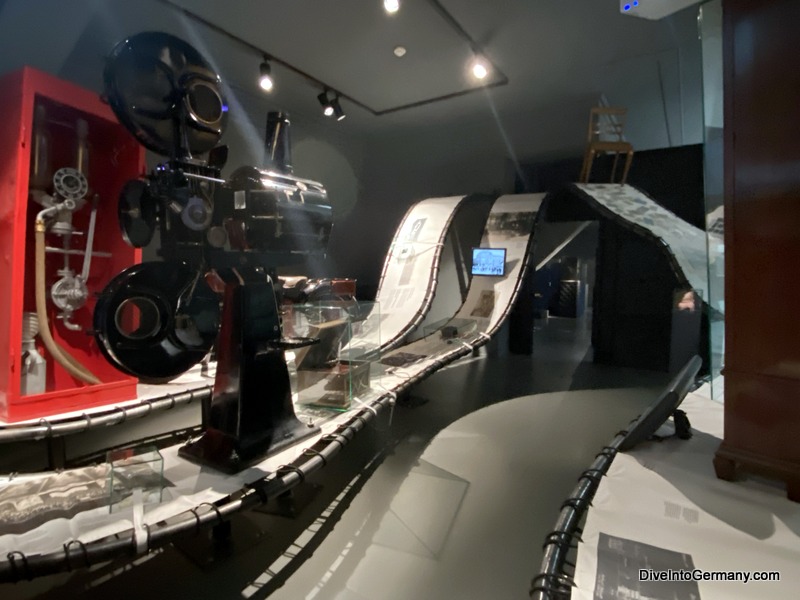
I enjoyed seeing a dress made from money in the 1920s thanks to rampant inflation and in protest to some of the events going on at the time. There is also a historic model of Leipzig from 1822 which is worth a look.
There is another part of this museum at Haus Böttchergäßchen which is just a few minutes’ walk away. Here are temporary exhibits also related to the history of the area. There is also a children’s museum. See the things to do with kids section below for more information on this attraction.
You can buy a combined ticket for both places.
I found this museum very much worth the time with lots of interesting information and exhibits.
Zeitgeschichtliches Forum (Forum Of Contemporary History)
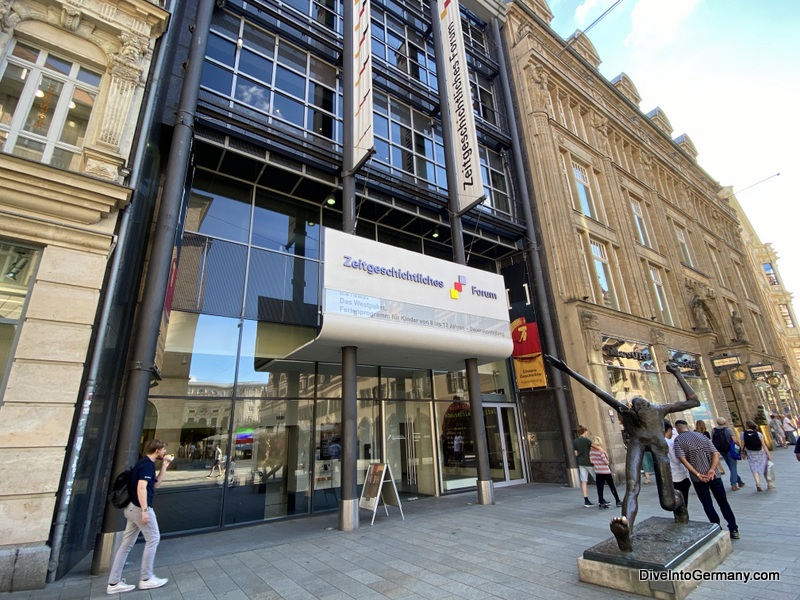
If you are looking for free things to do in Leipzig and are interested in the German Democratic Republic (otherwise known as East Germany), head straight here! It’s just a tiny walk from Marktplatz.
This free museum covers everything in the history of this country from 1949 to reunification. There are over 3,000 exhibits which cover all aspects of life including personal accounts, propaganda posters, archived documents and art and media.
It also, of course, covers everything you need to know about the downfall of this regime including the resistance movements that lead to the Monday Demonstrations and the fall of the Berlin Wall.
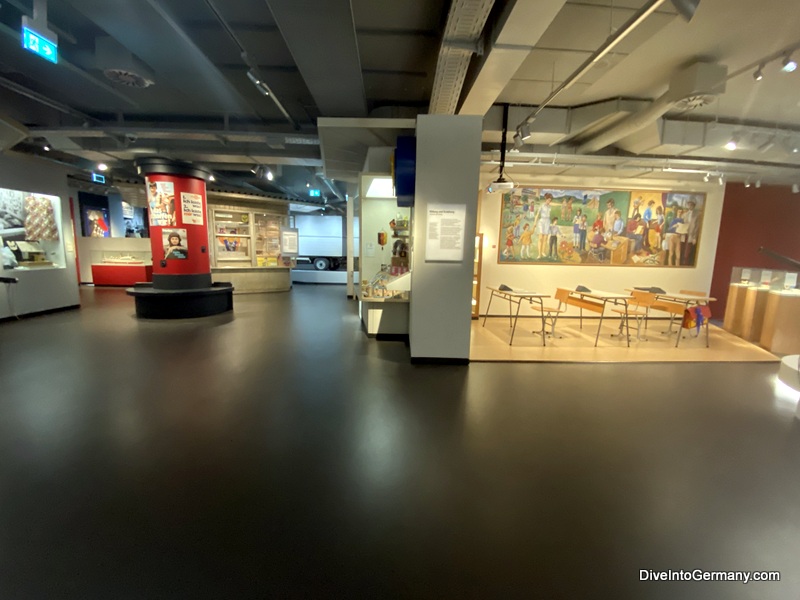
There are also exhibits about life in this region after reunification.
It covers a lot of information and it’s very well done. While I did find as an English speaker I did miss out on some aspects of the museum, there is plenty in English to keep you busy here for a couple of hours and it’s very much worth the stop.
Nikolaikirche (Church Of St Nicholas)
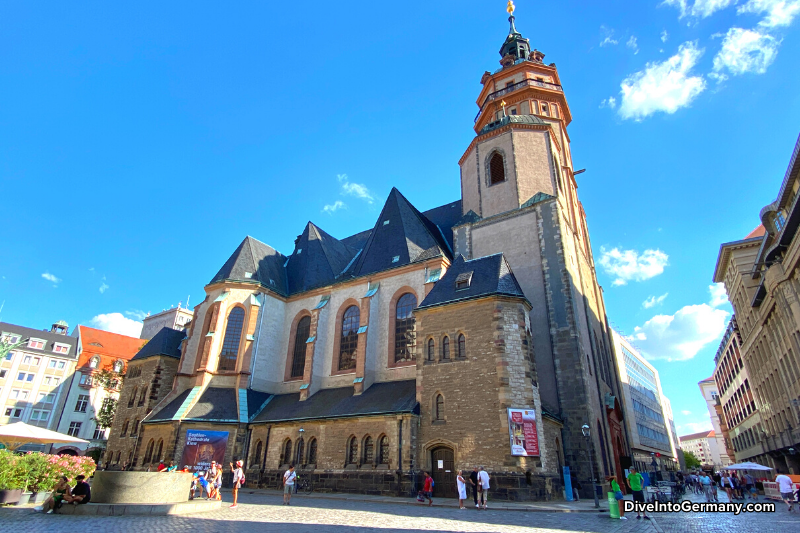
Even if you are not a church person, make your way to Nikolaikirche, a church with a big past.
Construction started on this church in 1165 in a Romanesque style, but it was turned into a Gothic hall church in the 16th century. In the 18th century, Baroque elements were added and the church has had a neoclassical interior since 1797.
While it’s a pretty church, it’s more about the events that have happened here that ensure its place on this Leipzig Germany things to do list.
Firstly, Johann Sebastian Bach was the music director here and at Thomaskirche (more below) between 1723-1750. Several of his works were premiered here.
In recent times, this church played an important part in the end of the German Democratic Republic. Starting in 1982, every Monday the church has held a prayer for peace. This still continues today.
However, more importantly is that these prayer sessions lead to the Monday Demonstrations in 1989 when candlelight demonstrations started following the prayers. This helped lead to the reunification of Germany.
There is a single column in front of the church to commemorate this movement.
Entry is free and I highly recommend you wander inside and say your own prayer for peace even if you aren’t religious.
Museum der Bildenden Künste (Museum Of Fine Arts)
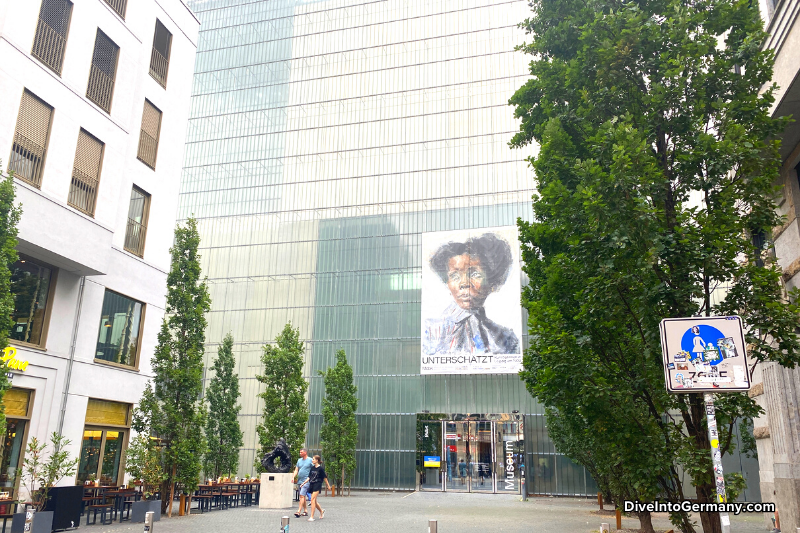
Art loved will want the Museum der Bildenden Künste at the top of their list of fun things to do in Leipzig. This fine art museum is a short walk from everything on this list so far and has a huge collection of paintings from the 15th century to today including works by Monet, Munch, Frans Hals, Cranach and more.
There are also rooms dedicated to local artists, Neo Rauch, Max Klinger and Max Beckmann.
It’s not just about the inside either, the building itself is interesting and is like a glass cube.
You need at least a couple of hours to visit here.
Museum in der Runden Ecke (Museum In The Round Corner)
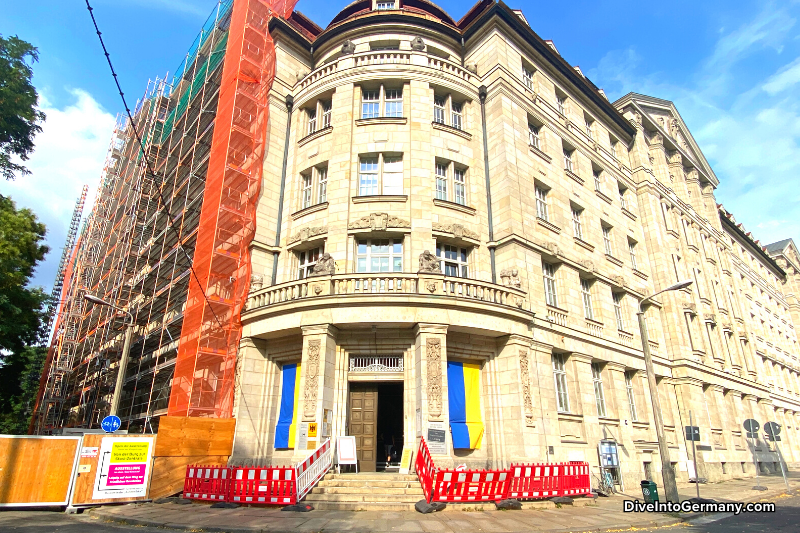
Also known as the Stasi Museum, this is the site of the Stasi (secret police) headquarters in Leipzig. Today, it’s the place to go to learn about how the Stasi operated to surveil, arrest and recruit people.
The museum is on the first floor and much of the interior has been kept how it was in 1989. You can see how they operated, their jail cells (like above) and much, much more. While it is a smaller museum, there is a lot crammed in.
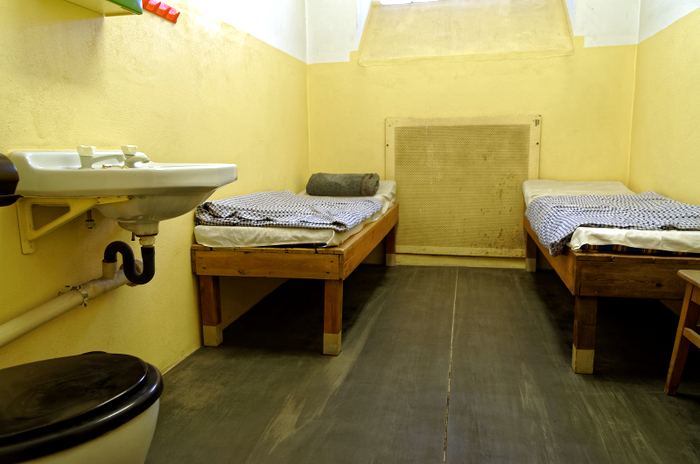
There are many exhibits like confiscated correspondence, uniforms, listening devices, secret cameras and more as well as information to help you understand how it ran and the methods they used. It’s quite mind blowing some of the things they did to keep tabs on people.
Information is in German so make sure you pick up an English audio-guide so you get the most out of your visit. The audio guide has a small charge.
Thomaskirche (St Thomas’ Church)

Thomaskirche is a beautiful 13th century Gothic church although it’s best known for its similar Bach legacy to Nikolaikirche. Bach performed at both.
His remains were buried here in 1949 beneath a bronze plate in front of the alter. There is also a statue of him out the front. When I visited, there was also a small exhibit about Bach, but it was only in German.
It wasn’t just Bach who played a part in Thomaskirche’s musical history with Mozart playing the organ here in 1789 and Richard Wagner was baptised here.
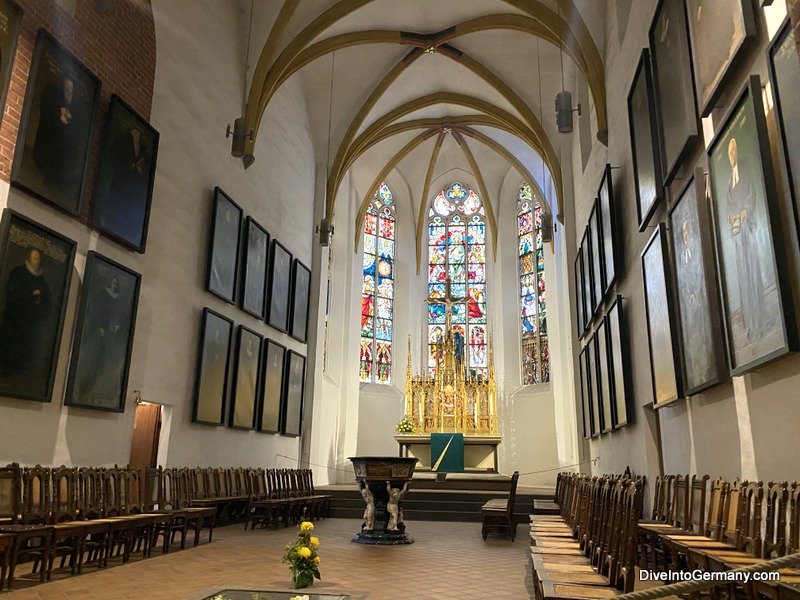
The boys choir at Thomaskirche is over 800 years old and is still one of the most celebrated in the world.
The church’s tower is 60 metres high with the structure from the 14th century. You can climb the tower as part of a tour. You can find the latest details here .
Bach-Museum
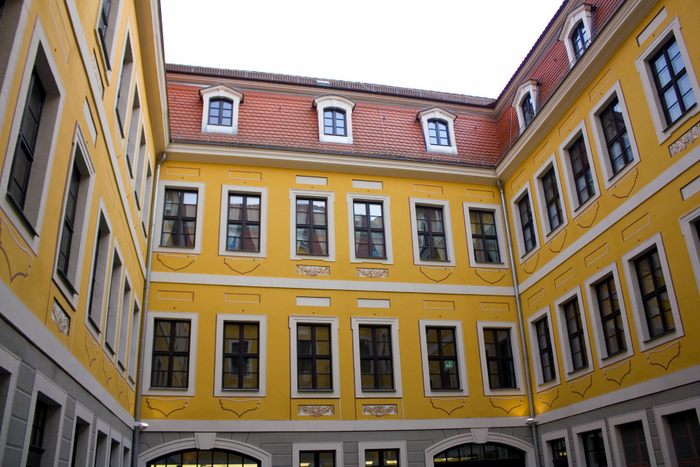
While you are taking in the sights at Thomaskirche, your next stop on this things to see Leipzig list is across the road at the Bach-Museum. As you can guess, it’s all about the life and work of Johann Sebastian Bach, perhaps Leipzig’s most famous resident.
It’s interactive with a range of items from his old instruments, to learning his family tree (many were musicians) to listening to his music.
The biggest draw of this attraction is the “Treasure Room” where hand-written, original manuscripts by Bach live in glass cases.
Augustusplatz

Leipzig’s largest square, Augustusplatz is a great addition to your list of cool things to do in Leipzig to see the surrounding buildings.
While the square itself is not that special, it hosts many markets and festivals throughout the year. It’s also home to the tallest building in Leipzig, City-Hochhause (which is coming up next), Gewandhaus (concert hall) and the opera house.
It’s definitely worth walking through here during your exploration of Leipzig.
City-Hochhaus
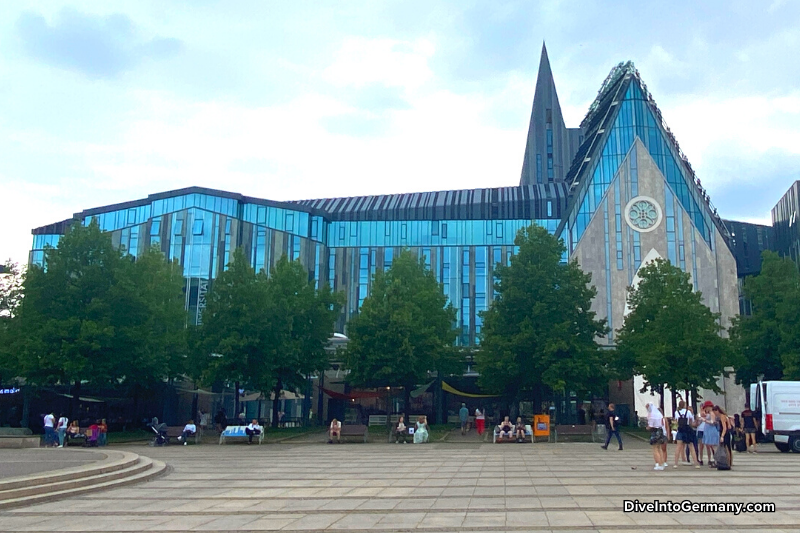
City-Hochaus is located on Augustusplatz and is the tallest building in Leipzig at 142 metres tall.
What’s more interesting for visitors is that it has a viewing platform on the 31st floor with great views over Leipzig. On a clear day, you can even see far beyond Leipzig.
For an even better experience, there is a restaurant as well, the Panorama Tower Plate of Art. You can also have a drink while you check out the views.
You can see the latest opening hours for the viewing platform and more information about the restaurant here . There is a charge to visit the viewing platform.
Museen Im Grassi

Museen Im Grassi is a university run collection of museums with three great options. It’s to the east of the Old Town about a 15 minute walk from Marktplatz, less from Augustusplatz.
It’s home to the Museum für Musikinstrumente (Museum of Musical Instruments), Museum für Völkerkunde (Museum of Ethnography) and Museum für Angewandte Kunst (Museum of Applied Arts). Each has its own entry fee.
Art Deco and Art Nouveau lovers will enjoy the Museum of Applied Arts with ceramics, furniture and glassware from the 1920s and 30s to the present day.
The Museum of Musical Instruments has pieces from the 16th to 20th century. There’s also a fun, interactive sound laboratory.
The Museum of Ethnography has a huge collection with pieces from all over the world.
Völkerschlachtdenkmal (Monument to the Battle of the Nations)
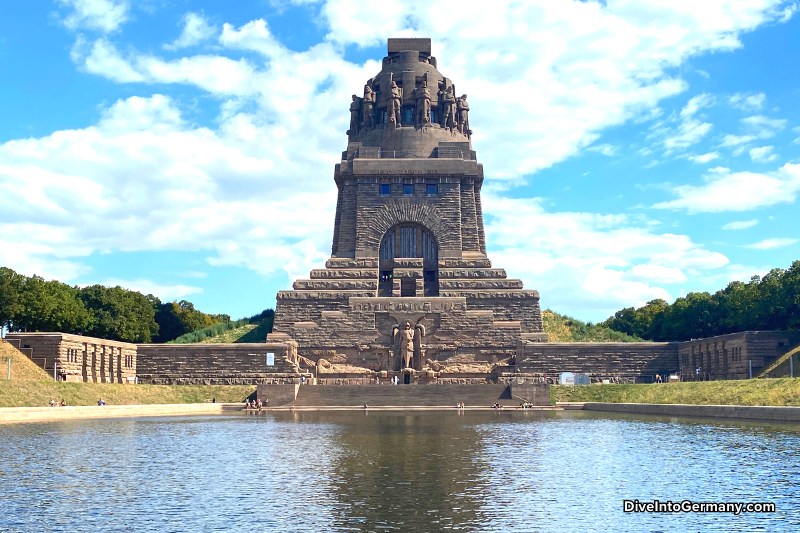
The Völkerschlachtdenkmal is massive monument in honour of the Battle of Leipzig (also known as the Battle of Nations) that occurred here in 1813. This battle was the largest in Europe before World War 1 with over half a million soldiers fighting and about 20% dying. It resulted in a decisive defeat of Napoleon destroying French power in Germany and Poland.
The monument was built in 1913 for the 100th anniversary of this battle, and it is BIG at 91 metres tall. I was blown away by the size when we first sighted it a couple of kilometres away. Closer, it is even more striking. Photos just don’t do justice to how big it is.
It’s well worth adding this to your list of places to visit near Leipzig for all of these reasons. I’ve never seen such a grand war memorial. For a small fee, you can enter the monument and the attached museum.
Inside is a huge crypt with statues representing fallen soldiers, a short film and there are two viewing platforms.
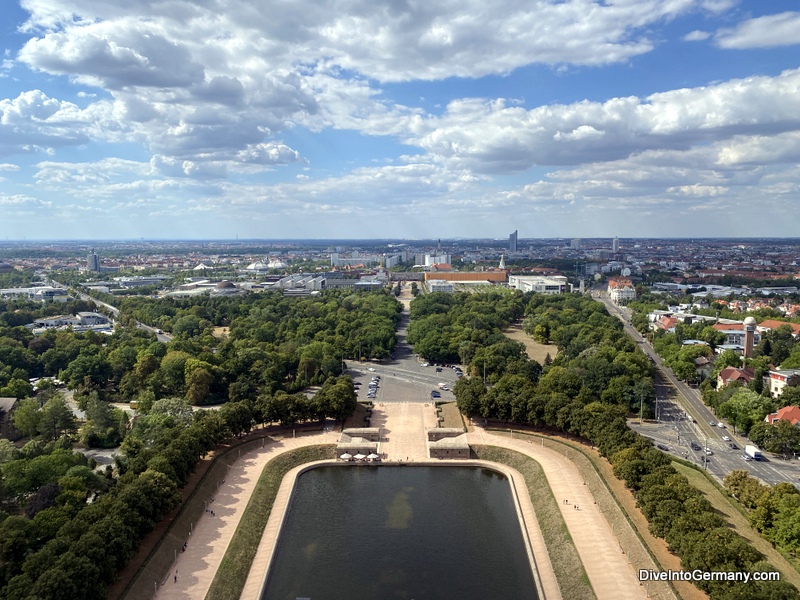
The lower platform has a lift, but the upper one requires walking up a spiral staircase. It’s tight and there are even traffic lights to tell you went you can enter! Views are great though and even the lower platform has great ones if you don’t want to do the stairs. However, note that you need to walk up a few floors before you get to the elevator.
Hot tip: There is a toilet at the entrance to the site which is 80 cents to use. Go to the ticket office for a free option.
Südfriedhof (South Cemetery)
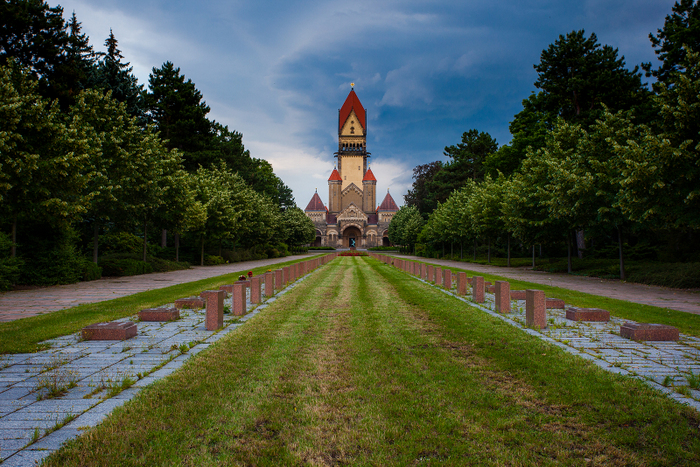
If you are looking for unusual things to do in Leipzig, head straight to Südfriedhof, the largest cemetery in Leipzig.
Südfriedhof is a big, beautiful park with shrubs, squirrels, foxes and more including what looks like a castle (but it’s a crematorium).
Many of Leipzig’s famous residents are buried here, and there is also a monument to antifascists killed by the Nazis.
It’s located next to Völkerschlachtdenkmal.
Asisi Panometer
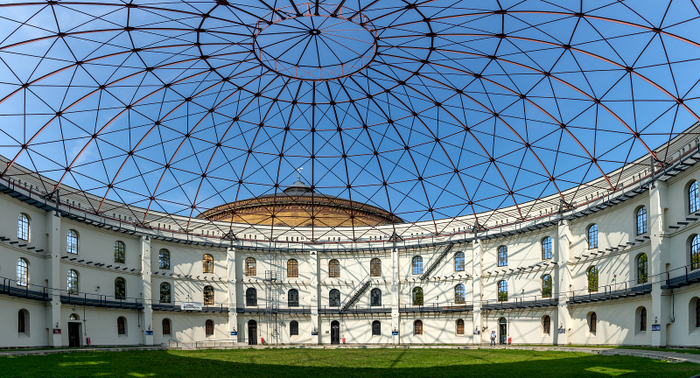
Located south of the centre is one of my favourite of the things to do around Leipzig, the Asisi Panometer. At 50 metres tall and 57 metres in diameter, this gasometer is big with a brick shell. Today, it shows the world’s largest panoramas.
This attraction was formerly a gasometer that was no longer used – until Austrian artist, Yadegar Asisi, came along. Using paper, pencil and computer technology, he created huge panoramas (30 metres by 105 metres in circumference) which show here.
They are huge, monumental scenes that change every couple of years. Past images have been the Titanic, Battle of Leipzig, the Amazon and more.
At the time of writing this, it is Carolas Garten (Garden) all about the nature in our garden. An exhibit accompanies each panorama on the same topic.
Accompanying each panorama is also small exhibition on the given topic.
You can also find Asisi Panoramas in a few other cities in Germany like Dresden and Berlin. You can read our full review of the Dresden Panometer here which will give you an idea of what to expect.
Leipzig Food Tour
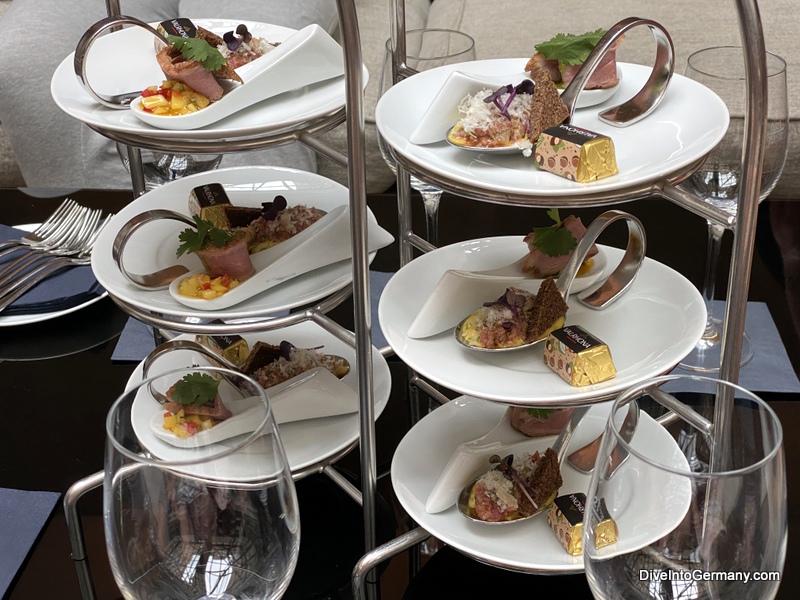
If you have the budget and the time, I can’t recommend taking a Leipzig food tour enough. We did this on our recent trip and it was a great way not just to taste lots of local food and drink, but also to learn more about the city.
The three hour walking tour had us stopping six times for food and drinks while the guide taught us a lot about the city both on our stops and as we wandered around. It was great!
You can find out more information about taking a Leipzig food tour (including all the food we ate) in our full review here.
Best Things To Do In Leipzig In Winter
While most of the things to see in Leipzig Germany listed above are possible in winter time, there are also some fun things to do in Leipzig Germany which are especially for the winter months.
Leipzig Christmas Market

When it comes to places to go in Leipzig in December, there is a massive standout attraction – the Leipzig Christmas Market. Located in and around Marktplatz, this market runs for about a month before Christmas and started in 1458.
It’s one of the largest Christmas Markets in Germany with over 250 stalls. There’s local food, art and craft creations and more. There is also a traditional performance of trombonists every evening on the balcony at the Old Town Hall.
You can also find Christmas Markets at Augustusplatz, behind the Old Town and by Nikolaikirche. Leipzig is a great place to come for Christmas Markets.
Oper Leipzig (Leipzig Opera)
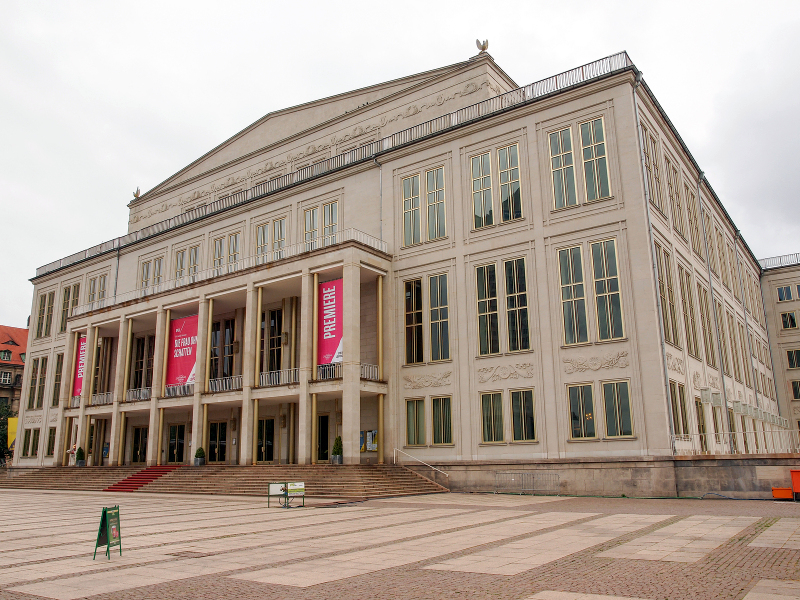
While you don’t have to wait until winter to visit the opera house and take in a show, this can be a great time to prioritise it. It’s a fantastic inside option or if you are looking for things to do in Leipzig at night. Leipzig has a long and proud muscial history after all.
At Oper Leipzig, you can attend the opera, ballet or musical or more.
The Gewandhaus Orchestra is particularly well regarded so try to visit a performance by them.
Find more information about the latest performances here .
What To Do In Leipzig In One Day – Leipzig Itinerary
Only have one day in Leipzig? What a shame! But it’s ok, it’s still worth going to Leipzig if you only have one day.
With one day, I recommend you stick to the Old Town attractions. There is a lot of interest here, and you can have a fabulous day exploring.
I recommend you:
- Start at Marktplatz and visit the Stadtgeschichtliches Museum (City History Museum) in the Old Town Hall to learn about Leipzig’s history
- Take a short walk to Zeitgeschichtliches Forum (Forum Of Contemporary History) to learn about the German Democratic Republic
- Visit Nikolaikirche (Church Of St Nicholas), the starting point of the Monday Demonstrations
- Choose between the Bach-Museum, der Bildenden Künste (Museum of Fine Arts) or the Museum in der Runden Ecke (Museum In The Round Corner) depending on if you are a Bach fan, would prefer to see art or learn about the secret police
- Visit Thomaskirche (St Thomas’ Church)
- Finish the day at Augustusplatz and take a ride up to City-Hochaus’ viewing platform
Things To Do In Leipzig With Kids
We visited Leipzig with our three kids aged 6 – 12. While kids can definitely enjoy the top 16 Leipzig attractions above, there are also a couple of attractions below they may especially enjoy.
From the above attractions, ones that worked particularly well were the Asisi Panometer – it’s on such a grand scale, just so impressive – and the Museum in der Runden Ecke. They found it interesting to see what the Stasi were up to. It really sparked their imaginations!
Kinder Museum
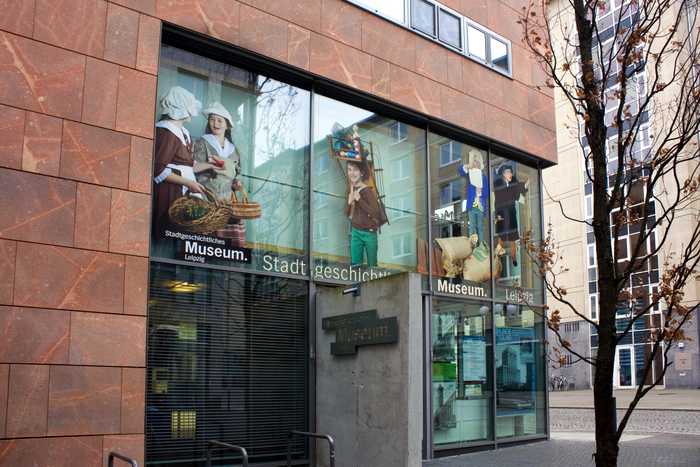
Located in the Haus Böttchergäßche part of the Stadtgeschichtliches Museum (more information about this above), the Kinder Museum is a great place to visit if you are travelling with kids.
Here you will find the interactive exhibition, Children Hold A Trade Fair, which helps children understand the history of Leipzig and its status as a trade fair city.
It’s aimed at 6 – 10 year olds and has six themed areas with kids being able to do things like touch and weigh goods, dress up as merchants and traders and learn old currencies. They can also play old games.
It’s a fun, educational experience.
Leipzig Zoo

Leipzig Zoo is huge and quite impressive. If your kids love zoos (or you!), this should be high on your list of things to do near Leipzig.
It has themed areas like Africa, Pongoland and Asia. What’s really cool is the Gondwanaland biome. This is a massive indoor area that’s been set up to mimic the tropics with a temperature of 25°C and humidity set as well.
This allows a whole lot of tropical plants and animals to live and thrive. You can explore via a jungle trail, in the treetops with suspension bridges or by boat. It’s very impressive, although I must admit that we didn’t spot many animals.
The boat is a small extra fee but worth it, even if you don’t speak German like us (so don’t understand the presentation at the beginning).

While Gondwanaland is the highlight, there are plenty of other cool things to see at this zoo. I especially liked Pongoland (apes, gorillas, etc) with the chimpanzees being especially fun to watch.
We have been to many zoos around the world to the point where I can be quite blase about visiting zoos now. However, I did not feel blase at this zoo. It’s great.
It’s located walking distance from the Old Town to make a visit here even easier.
Best Place To Stay In Leipzig
When it comes to where to stay in Leipzig, there is a great range of hotels and other accommodation options. You won’t have any problem finding somewhere to stay.
Below I’ve listed a few different places to consider depending on what type of accommodation you are looking for.
BEST – Steigenberger Grandhotel Handelshof Review

This luxury hotel is moments from Markt Platz and the Old Town Hall in an unbeatable position. It’s the best place to stay in Leipzig. Housed in a former exhibition building, you’re surrounded by history.
The 5-star rooms and suites all have flat-screen TVs with satellite channels, tea and coffee making facilities, toiletries, bathrobes and most have seating areas. The rooms range from superior doubles to presidential suites and are all well appointed.
Facilities include a restaurant, bar and, my personal favourite, a 2 floor Spa World with saunas, steam bath, gym and massage and beauty treatments. There is also parking for an extra fee.
Click here for the latest prices.
VALUE – Adina Apartment Hotel Leipzig Review
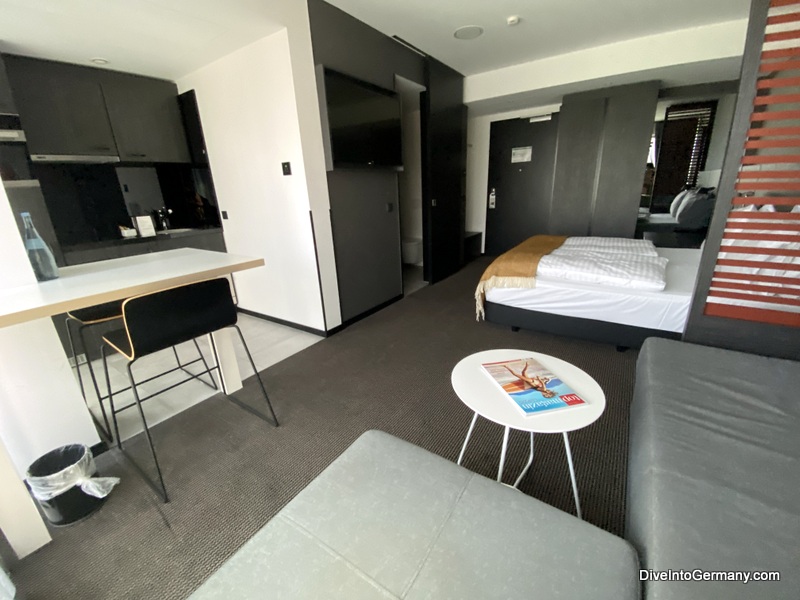
If you would prefer apartment-style accommodation in Leipzig’s Old Town, this is the best option for you! Just a few minutes walk from the main train station and around the corner from the Fine Arts Museum, it’s easy to explore Leipzig from here.
The hotel is located in an historic Brühlpelz building and rooms are either studios or one-bedroom apartments. They all have seating areas and fully equipped kitchens as well as tea and coffee making facilities and washing machines. The upper floors also have great views.
What I love about this hotel is that there is a great range of facilities as well – many apartment hotels focus on just their rooms and also don’t have restaurants, room service, a gym and a pool. But the Adina Leipzig has all of these things! They also have parking available nearby for an extra fee.
Click here for the latest prices or find our full review here.
FUN – Penta Hotel Leipzig Review

This hip, modern hotel is the place to stay in Leipzig for something different. Located to the east of the Old Town about a 5-minute walk from Augustusplatz, it’s easy to explore from here.
Designer rooms are twin and doubles (some with a sofa bed) with a range of extras depending on which you pick. For example, the Penta Playerpad room could have a Playstation, a football table or a pinball machine! You can also chose a room with lounge access for unlimited snacks and drinks in the evening and breakfast included.
Facilities include a large pool with a sauna area and gym. There is also a restaurant and bar which they invite you to treat like your living area. Parking is available for an extra fee.
Find more of the best hotels in Leipzig here.
Leipzig Attractions Map
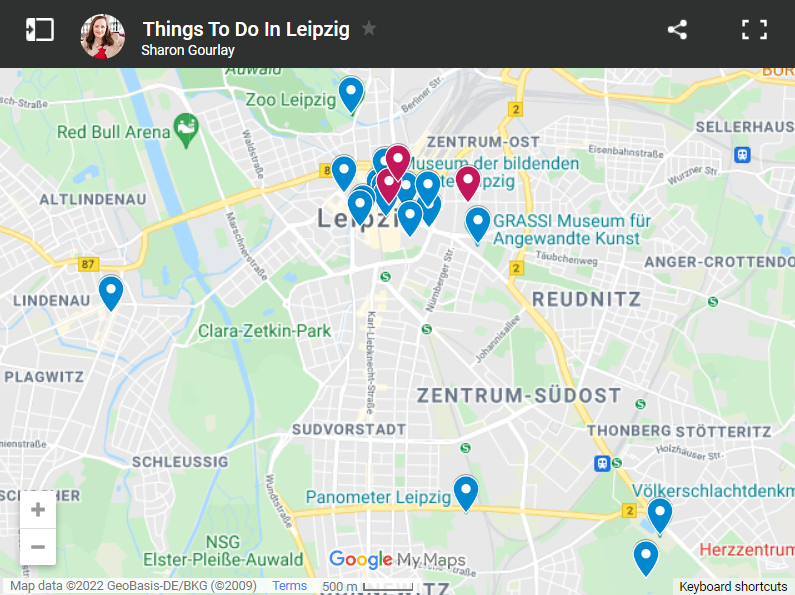
How To Get To Leipzig

We travelled to Leipzig by hire car which made it very easy to get here. It’s a major city, and it’s simple to find.
You can hire a car to get you there by clicking here.
There is also an airport with flights within Germany and Europe.
Click here to see the latest flights and prices.
There are regular trains and buses here. You can find timetables and all your options here.
Once in Leipzig, we found it easy to use public transport, although most of the time, we explored on foot. There is a wide range of trams, buses and trains and one ticket can access what you need. You can find more information here (use browser translate tools).
Most tram and bus stops and train stations have ticket machines and you can also buy them aboard trams and buses. You can also use the LeipzigMove app to buy tickets. Find more information here .
Final Words
Leipzig is an interesting and fun place to visit with some great attractions. I particularly enjoyed learning about the old German Democratic Republic here and I look forward to visiting the massive Christmas Markets next time.
But most of all, I really enjoyed just hanging out in this city. It certainly lives up to the hype in its nickname Hypezig . It ended up being one of my favourite places in Germany and it’s worth a spot in your itinerary.
Whatever you chose to do when you visit, I’m sure you’ll have a great time!
Check out all the best hotels in Leipzig for your great stay here. You can also find our one week itinerary for Eastern Germany that includes Leipzig here or read more guides to visiting East ern Germany here . Find our full guide to nearby Dresden here or nearby (and gorgeous) Quedlinburg here.
Related posts:

By Sharon Gourlay
Sharon first fell in love with Germany back in 2000 on her first visit. She loves the long history, the picturesque Old Towns, the castles, the food, everything really! Since then, she has visited many times and loves writing about Germany here so you can enjoy it too. In fact, Sharon loves German culture so much that she sent her kids to a German primary school in Australia. She especially loves Berlin and towns with charming Old Towns like Celle and Quedlinburg. Sharon also has a Certificate III in International Travel Sales and understands the nitty gritty of travel planning. Through this site, she'll help you have the perfect trip to Germany whether it's your first or tenth time!
Leave a comment Cancel reply
Your email address will not be published. Required fields are marked *
Save my name, email, and website in this browser for the next time I comment.
This site uses Akismet to reduce spam. Learn how your comment data is processed .

- 1.1 Tourist Information
- 2.3 By train
- 2.4 By plane
- 3.1.1 Tickets
- 3.1.2 Leipzig Card
- 3.1.3 Night Bus Network
- 3.2 By taxi
- 4.1 Churches
- 4.2 Museums
- 4.3 Famous houses
- 4.4 Fair-houses and passages
- 4.5 Architecture
- 4.6 Other sights
- 5.1 Sightseeing tours
- 5.2 Concerts
- 5.3 Festivals
- 5.4.1 Riverside woods and parks
- 5.4.2 Leipzig by boat
- 5.4.3 Lakes
- 5.5 Other activities
- 7.1 Specialities
- 7.2.1 In the city center
- 7.2.2 Around the Südplatz
- 7.3 Mid-range
- 7.4 Splurge
- 8.2 Bars and pubs
- 9.1.1 Camping
- 9.1.2 Hostels
- 9.1.3 Hotels
- 9.2 Mid-range
- 9.3 Splurge
- 10 Stay safe
Leipzig is the largest city in the German federal state of Saxony , with a population of approximately 600,000 (Oct 2019). It is the economic centre of the region, known as Germany's "Boomtown" and a major cultural centre, offering interesting sights, shopping and lively nightlife. The Gewandhausorchester is the biggest and one of the most prominent classical orchestras in Germany, and Leipzig Zoological Garden is one of the most modern zoos in Europe. The Neuseenland, outside of Leipzig, is a huge lake district.
Understand [ edit ]
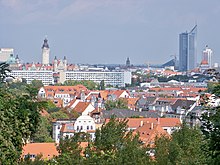
First documented in 1015, and endowed with city and market privileges in 1165, the city of Leipzig has fundamentally shaped the history of Saxony and of Germany. It was founded at the crossing of two ancient trade routes, Via Regia and Via Imperii. Leipzig has always been known as a place of commerce and still has large trade fairgrounds and exhibition halls known as the Leipzig Messe north of the city. Before it became common to dedicate a specific area to trade fairs, they took place in the city. Which is why many of the historical buildings were constructed by merchants, as were Leipzig's unique system of arcades and courtyards.
Other forms of exchange soon followed the trade of goods. The University of Leipzig (Latin: Alma mater lipsiensis ) was founded in 1409, which makes it the second-oldest university in Germany. University facilities are scattered throughout the city, and you cannot miss the central campus at Augustusplatz. Leipzig acquired the nickname Klein Paris ("Little Paris") in the 18th century, when it became a centre of a classical literary movement largely lead by the German scholar and writer Johann Christoph Gottsched.
The city is also the home of the Nikolaikirche (Church of St. Nicholas) – the starting point of peaceful demonstrations against the East German regime which led to German Reunification. The collapse of the Socialist Unity Party of Germany (SED) regime hit Leipzig's economy very heavily (as had communism), but after being on the mend since 1990, it has emerged as one of the success stories of the "New German States".
Traces of Leipzig's history are everywhere: the ring of streets around the city centre marking the former course of the city wall, the city trade houses, abandoned and repurposed industrial buildings in Plagwitz, small town structures in the outskirts where surrounding towns were incorporated during phases of rapid growth, and the battlefields of the Napoleonic wars in the south and southeast of the city.
Today it competes with long time rival Dresden for the title of "biggest city in Saxony" . In the 2011 Census, Dresden overtook Leipzig, but according to 2016 estimates, Leipzig has an edge once more. Leipzig's trendy districts are rapidly gentrifying, especially the Südvorstadt neighborhood and it has thus gained the nickname "Hypezig" which is both used derisively and somewhat appreciatively.
Tourist Information [ edit ]
- 51.34223 12.37521 1 Tourist Information , Katharinenstraße 8 ( near Markt in the city centre ), ☏ +49 341 71 04-260 , fax : +49 341 71 04-271 , [email protected] . You can download some leaflets from their website.
Get in [ edit ]
Leipzig is a transportation hub in Saxony and offers fast connections by rail, road and air throughout Germany. Important east-west and north-south routes have crossed here for a long time and they still do today.
By car [ edit ]
Leipzig can easily be reached by car, as it is very well connected with the Autobahn system. The nearest Autobahns are A14 (North, Northeast), A9 (West) and A38 (South).
By bus [ edit ]
- 51.345101 12.384954 1 Intercity bus station .
Long distance buses connect Leipzig with several major German cities. Buses stop at a bus terminal next to the Central Station's east exit and/or at the airport railway station. Bus operators include Flixbus .
By train [ edit ]

Deutsche Bahn operates regular train service between Leipzig and nearby cities such as Halle (€7.60, 25 minutes), Dessau (€14, 45 minutes), Chemnitz (€19, 65 minutes), Dresden (€30, 65 minutes), Magdeburg (€31, 75 minutes), Weimar (€22, 75 minutes), and Jena (€21, 85 minutes).
High speed trains are available to major cities in Germany including Lutherstadt Wittenberg (€21, 30 minutes), Erfurt (€28, 42 minutes), Berlin (€49, 75 minutes), Nuremberg (€87, 2 hours), Frankfurt (€88, 3 hours), Hamburg (€106, 3 hours) and Munich (€117, 3:15 hours). Prague (€59, 4 hours) can be reached with a transfer in Dresden , but direct busses between Leipzig and Prague are faster.
If you book well in advance reduced-fare (limited refunding, set date and train) tickets are available starting at €29 (€21.75 with Bahn card 25, no Bahn card 50 discount). Your best chance on reduced fares are off-peak hours on weekdays. Even if you buy your ticket one day prior to departure on an ICE, you have a good chance of finding a reduced fare that is cheaper than the full prices (called "Normalpreis" in German) quoted above. However unlike with the Normalpreis you will have to use the train you booked and can't change it. If you aren't travelling alone, it might make sense to see whether there is a discount for the second person travelling the same route or for groups. For more on the price system of German trains see rail travel in Germany ..
Also Flixtrain serves the city.
By plane [ edit ]

Berlin Brandenburg airport ( BER IATA ) is just two hours away by train and offers more options. As an intercontinental flyer you should also consider Frankfurt Airport ( FRA IATA ). During daytime, hourly direct trains take you from the airport station Frankfurt Flughafen Fernbahnhof to Leipzig Hauptbahnhof in about 4 hours for €74 (book in advance and you can get tickets for as little as €29). Many (but not all) airlines flying to/from German airports offer rail&fly. For more see rail air alliances
Get around [ edit ]

Public transport [ edit ]
The primary means of public transport is the tram. LVB operates trams and buses in Leipzig. Most lines run every 10 minutes during the day and at least hourly at night. A single-trip ticket costs €3.20. A full day bus & tram ticket, valid until 04:00 the next morning, costs €9.20; a day ticket for 2-5 people travelling together costs €13.80-27.60. A weekly pass costs €32.90. After 20:00, you must enter buses through the driver's door and show/purchase your ticket.
The tram network is structured like a star with a circle in the centre. Tram lines generally lead from the outskirts into the city, which they half-circle on the ring, and continue to someplace else in the outskirts. Bus lines provide additional direct connections that often do not touch the centre.
Trains ("S-Bahn") cross the city centre in a north-south direction through the city tunnel, connecting Hauptbahnhof and Bayerischer Bahnhof via underground stations at Markt and at Wilhelm-Leuschner Platz. From both ends of the tunnel, lines branch off in several directions towards Leipzig suburbs like Connewitz, Stötteritz, Thekla, fair area and Miltitzer Allee and beyond. The city tunnel provides fast connections north - south, but is not of great help in the east - west direction.
Tickets [ edit ]
LVB is part of the regional integrated transport network MDV . Tickets to nearby towns and cities (e.g. Halle ) are available at LVB ticket offices and vending machines. They are valid for all participating means of transportation. The fares quoted above are for MDV fare zone 110, which is more or less identical with the city. A single-trip ticket includes transfers to other lines. You have to complete your trip within one hour. Buy tickets from:
- Vending machines at some stops and at all train stations, payable with coins or (small) bills
- Vending machines inside the trams. Coins only
- Bus drivers
- One of the LVB service offices
- Some tobacco, stationery, or press shops
Stamp your ticket after boarding the first bus or tram on your itinerary, or on the platform when using a train. Week tickets are issued for 7 days from the set date, month tickets for calendar months. Day and week tickets are valid until 04:00 the next day after their validity has ended; month tickets until noon the day after their validity has ended.
Ticket and service offices:
- LVB-Mobilitätszentrum , Willi-Brand-Platz ( opposite of central station towards Nikolaistraße ). M–F 08:00–20:00, Sa 08:00–16:00 . LVB service and ticket office
- 51.3367 12.3748 2 LVB-Servicezentrum , Petersstraße/Markgrafenstraße ( city centre near Wilhelm-Leuschner-Platz ). M–F 08:00–20:00, Sa 08:00–16:00 . LVB service and ticket office
- LVB online shop . LVB service and ticket office
Leipzig Card [ edit ]
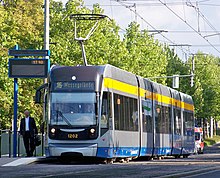
A ticket with benefits is the Leipzig Card . You can buy it at the LVB ticket offices listed above, at tourist information, or online. At a price moderately higher than the corresponding LVB tickets, in addition to unlimited rides, the Leipzig Card offers discounts at a number of tourist attractions. The Leipzig Card is available in three versions:
- Day ticket (valid for one person): €13.40
- 3-day ticket (valid for one person): €26.90
- 3-day group ticket (valid for two adults and up to 3 children under 14): €51.90
A leaflet listing all the benefits is available online .
Night Bus Network [ edit ]
Regular services operate until around midnight. A network of Nightliner bus lines (N1...N10) takes you around at night. All Nightliner buses start from Hauptbahnhof at 01:11, 02:22, and 03:33. They service most parts of the main tram network, but on different routes. Each line makes a loop, returning to Hauptbahnhof at the end. Check the blue network plans at stops or inside trams.

By taxi [ edit ]
Plenty of taxis are available. They wait for customers in various designated locations around the city. You can also wave a taxi on the street if its sign is lit up. To order a taxi to your current location call 4884 . Pubs, restaurants and hotels will be happy to do that for you if you are their customer. Expect a fare of €15–20 for a trip from the outskirts to the centre or vice versa.
Leipzig suffers from the same traffic problems as all cities of its size. Access to the city centre is restricted, so don't plan to go anywhere inside the inner ring of main streets.
If you still want to use a car within the city, be prepared to pay a fee for parking around the centre. Car parks are available at Hauptbahnhof, Augustusplatz, Burgplatz, and several other locations. A parking guidance system is installed on the main streets. Around the inner ring, signs point you to the different car parks and display the current number of unused parking spots. Signs are colour-coded, each color representing a car park location. Since the city centre is pretty compact, for most purposes it won't matter much where you leave your car. When you visit the Gewandhaus or the opera, the car park underneath Augustusplatz is the most convenient option with exits to both buildings.
Watch for the trams when making turns. They are stronger than your car and sometimes come from behind beside the street. At marked tram stops, if the driving lane is to the right of the track, you have to wait behind a stopping tram and let passengers get on and off. After everyone is off the street, you may pass slowly.
Most of the city of Leipzig is a designated low-emission zone ( Umweltzone ). Cars operating within city limits must comply with strict emission standards and have a special green sticker ( Feinstaubplakette ). If you enter the city without the sticker, or with a yellow or red sticker, you risk being fined.

See [ edit ]

Churches [ edit ]

Museums [ edit ]
- 51.28749 12.387713 13 Torhaus Dölitz , Helenenstraße 24, 04279 ( tram 11 to Leinestraße ), ☏ +49 341 33 89 10 7 . W F Sa 10:00–16:00 - subject to change, please call before . Exhibition of pewter figures in historically themed dioramas. The location, the gatehouse and only remainder of an old manor, was one of the hotspots in the battles of the Napoleonic wars. €3 .
- 51.332388 12.36824 15 Universitätsbibliothek Bibliotheca Albertina , Beethovenstr.6, 04107 ( bus 89 to Wächterstraße or Mozartstraße ). M-Sa 08:00-00:00 . The university's library.
- 51.355334 12.390119 21 Straßenbahnmuseum ( Tram museum ), Apelstraße 1 ( tram 9 to Historischer Strbf. ), [email protected] . May-Sep: 3rd Sunday of the month 10:00-17:00 . Dozens of historic trolleys that once ran on Leipzig's tram network. €3 . ( updated May 2019 )
Famous houses [ edit ]
Fair-houses and passages [ edit ].

Unique to Leipzig is its number of passages in the city centre. Some have big entrances, while others may look from the street just like a gate left open. Some belong to historical buildings, some have appeared only a few years ago.
- 51.3394 12.37544 25 Mädlerpassage , Grimmaische Straße/Neumarkt . Upscale shops and bars. The entrance to Auerbachs Keller is inside. Forms a bigger system with Königshauspassage and Messehofpassage.
- 51.341189 12.373459 26 Barthels Hof , Hainstraße/Barfußgäßchen .
- 51.340214 12.377418 27 Speck's Hof and Hansahaus , Nikolaistraße/Reichsstraße/Grimmaische Straße . The oldest passage in Leipzig.
- 51.34212 12.37283 28 Jägerhofpassage , Hainstraße/Große Fleischergasse . Calm atmosphere in the middle of the city. Inside you'll find the arthouse cinema Passage Kinos .
- 51.33845 12.37694 29 Städtisches Kaufhaus , Neumarkt/Universitätsstraße/Kupfergasse/Gewandgäßchen .
Architecture [ edit ]
- 51.342921 12.37479 30 Romanushaus and Fregehaus , Katharinenstraße 23 ( city centre near tourist information ). Baroque architecture.
- 51.2962 12.3935 31 Rundling ( Nibelungensiedlung ), Siegfriedplatz, Siegfriedstraße ( tram 16 to Lößnig or tram 11 to Raschwitzer Straße or local train to Leipzig-Connewitz ). Apartment houses in concentric circles, built in the late 1920s/early 1930s. Streets are named after characters from the "Song of the Nibelungs".
- Stalin era architecture , Roßplatz ( Tram to Augustusplatz or Roßplatz ). Curved to follow the street, huge like a castle -- Leipzig's most prominent relic of the Stalin era sits at the Ring next to the Gewandhaus.
- 51.34571 12.36031 32 Waldstraßenviertel ( northwest of the city centre; Tram 3, 4, 7, 8, 15 to Waldplatz; follow Waldstraße and walk into sidestreets at your discretion ). Europe's largest uninterrupted Gründerzeit district.
- 51.32875 12.33461 33 Plagwitz . An industrial district whose time of glory has passed. Many of its factories died a slow death during the GDR years, which suddenly became visible with the reunification of Germany. Today it is a mixture of old industrial buildings, some in ruins and others repurposed; fallow land; and new developments. Walk around Karl-Heine Straße between Felsenkeller and the railway station Bahnhof Plagwitz, Weißenfelser Straße and Gießerstraße to get a feeling for the place, or walk the path alongside the Karl-Heine Kanal. May appear a bit spooky at night.
- Meyersche Häuser , Several locations: Herrmann-Meyer-Straße in Kleinzschocher; between Erich-Köhn Straße and Demmeringstraße in Lindenau; Hofer Straße in Reudnitz; between Bernburger Straße and Theresienstraße, Hamburger Straße and Schönfelder Straße in Eutritzsch . Herrmann Julius Meyer, owner of a publishing company, initiated in the late 19th century several development projects to provide adequate but cheap housing to factory workers and their families.
- 51.339932 12.379891 34 Krochhochhaus , Goethestraße 2 .
- 51.337489 12.38157 35 Europahaus , Augustusplatz 7 .
- 51.34265 12.38393 37 Wintergartenhochhaus .

Other sights [ edit ]

Do [ edit ]
If you understand some German, get a copy of the monthly city magazine Kreuzer or use the event calendar on their website to get information on upcoming events. You can buy the Kreuzer for €2.50 in press shops and bookstores throughout the city.
Sightseeing tours [ edit ]

- 51.342 12.375 1 Sightseeing tour , Katharinenstaße 8 ( starts at Tourist Information, ends on Augustusplatz ), ☏ +49 341-71 04-230 . Daily 13:30 (in German also 10:30) . The tour lasts 2½ hours, comprising a 1-hour guided walk through the city centre and a bus tour of 1½ hours to sights elsewhere. You can also book each part of the tour individually. Buy your ticket at tourist information, where the tour starts. €15 .
- 51.346 12.379 2 Sightseeing by tram , Kurt-Schumacher Straße ( coming from Hauptbahnhof/Westhalle, walk a few steps towards Berliner Straße/Wilhelm-Liebknecht Platz ), ☏ +49 341-19449 . Saturdays, starting at 11:00 and 14:00; May–September also Sundays 11:00 . Every weekend, LVB offers sightseeing tours in a modified tram called "Gläserner Leipziger" . Buy your ticket in advance from any of the LVB service offices listed above; it includes a day ticket for zone 110 (Leipzig) of the MDV network. The tour takes about 2 hours. €15 per person .
- 51.364 12.376 3 videoSightseeing Leipzig , Lützowstr. 19 ( you decide where to meet your guide when you book ), ☏ +49 341-902 902 89 , [email protected] . individual starting time for small groups . In addition to the comments of a live guide in English or other languages, on-screen historic film footage and photographs give you a deeper insight into Leipzig's history and life today. The standard length of the tour is 2 hours. You can also combine it with a walking tour through the historic centre. from €25 . ( updated Jul 2020 )
Concerts [ edit ]
- 51.33804 12.38062 4 Gewandhaus , Augustusplatz , ☏ +49 341 1270 280 (Tickets) . Mendelssohn's orchestra still exists, but the concert hall is new. Inside is a huge painting by Sighard Gille, visible through the windows from Augustusplatz.
- Motets in St. Thomas Church , Thomaskirche, Thomaskirchhof . Friday 18:00 and Saturday 15:00; unreserved seating, come early (church opens 45 min before) . Listen to the St. Thomas Boys Choir performing Bach's music in its original environment. Be aware that a guest choir may sing instead at any time as the St Thomas Choir travels a lot. Since the motet is primarily a musical form of devotion and not a musical performance for tourists, applause is uncommon and frowned upon. Admission €2 (includes program); children free .
Festivals [ edit ]
- Wave-Gotik-Treffen Leipzig . Date follows Pentecost, late May or early June . World's largest goth festival includes a pagan village, medieval market, and goth music.
- Saxonia International Balloon Fiesta , Leipzig-Lößnig ( Tram 10 or 16 to Lößnig ). late July . Meeting of hot air balloon pilots. Lots of flying balloons if the weather permits flying.
- International Festival for Documentary and Animated Film . every October .
Outdoors [ edit ]
Riverside woods and parks [ edit ].
- 51.357 12.347 11 Aussichtsturm Rosentalhügel ( follow Marienweg from Waldstraße, the hill with the tower is to the right after about 400 m; when you reach a small lake to your right you went too far ). Observation tower. See the city from above. Admission is free. You'll have to climb up stairs in the open and stand on a platform that may shake a bit in the wind. Free .
- 51.31714 12.3622 12 Fockeberg ( west of Fockestraße ). This hill was built as a landfill for World War II debris. It is now a park and the location for several recurrent events: the Fockeberglauf in March and November (a running competition), the Fockebergzeitfahren (an uphill bicycle race), and the Prix de Tacot (a soapbox car race). Admission free .
- 51.3 12.372 13 Wildpark , Koburger Straße ( Tram 9 to Wildpark ). 09:00–18:00/19:00/20:00 depending on the season . Watch wild animals in the woods. If you feel like hiking, after passing through the Wildpark you can turn northwards and walk to Clara-Zetkin Park, or walk south/southeast to Cospudener See. Both are about 2.5 km away. Free .
Leipzig by boat [ edit ]
Leipzig is not located on any major river; instead there are several smaller rivers, their tributaries, and canals from the industrial era, creating a network of waterways that is grandiloquently touted as a "little Venice". Currents are weak to non-existent and motorboat traffic is rare. Thus, Leipzig's rivers and canals are perfect for amateur canoe paddlers and rowers, even for complete rookies in this field. Urban districts like Plagwitz or Schleußig and even the western parts of the city centre as well as the extensive riverside forest and parks may be discovered from the waterside, providing a completely different perspective of the city. There are several boat rentals, typically charging €7–8 per hour for a two-seater kayak or Canadian canoe.
- 51.31865 12.3397 14 Bootsverleih Herold , Antonienstraße 2 ( Tram 1, 2 oder Bus 60 "Rödelstraße" ), ☏ +49 341 480112 . Boat rental offering skiffs (up to 4 persons), kayaks (for 1, 2 or 2+child) and Canadian canoes (for 2, 3, 4 or 5 persons); as well as guided motorboat tours (advance booking required). €7.50/hr for two-seaters; motorboat tour (70 min incl. drink) €14 . ( updated Aug 2019 )
- 51.33 12.34842 15 Bootsverleih am Klingerweg ( SC DHfK Leipzig canoe department ), Klingerweg 2 ( Tram 1, 2 "Klingerweg" ). Boat rental offering skiffs (up to 4 persons), kayaks (for 1, 2 or 2+child) and Canadian canoes (for 3 or 4), large Canadian for 10 (requires a professional cox, advance booking); guided motorboat tours. €8/hr for two-seaters; motorboat tour (70 min incl. coffee) €14 . ( updated Aug 2019 )
Lakes [ edit ]

Leipzig is surrounded by several lakes , resulting from former open-cast lignite mining and now developed into places for various outdoor activities. You can spend a day on the beach, ride a canoe, or go fishing or scuba diving 10 km from the city centre. Be warned that, due to their origins as open-cast mines, the lakes are very deep and have steep sides: don't enter the water unless you are a strong swimmer. The closest lakes are:
- 51.315 12.252 16 Kulkwitzer See , Grünau/Miltitz ( Tram 1 to Lausen, S-1 to Miltitzer Allee, Tram 15 to Plovdiver Straße, or Bus 65 to Straße am See ). Beach; camping; fishing, water sports. This one is the oldest of the close lakes. Converted from a mine in the 1960s, the city grew towards it in the 1980s with the Grünau development. Beach access free; fishing requires a permit, available in the camping office .
- 51.282 12.345 17 Cospudener See , Markkleeberg-West/Knautkleeberg ( Bus 65 via Markkleeberg Bahnhof - tram 9 or local trains - or via Großzschocher - tram 3, change to bus 65 at Huttenstraße. The bus stops right at the northern beach. Buy a ticket for fare zones 110 and 151. The main parking lot is accessible from Brückenstraße. ). Named after Cospuden, a village that fell victim to opencast mining, this lake was the first lignite mine conversion in the region after the end of the GDR. Locals instantly and enthusiastically adopted their new Costa Cospuda . The northern Beach (Nordstrand) is broad and sandy, the perfect place to spend a hot summer day.
- 51.27 12.399 18 Markkleeberger See , Markkleeberg-Ost ( Tram 11 to Markkleeberg-Ost (buy a ticket for fare zones 110 and 151; from the terminal stop proceed on Bornaische Straße in the same direction until you reach the lake ). The youngest of the nearby lakes and perhaps a bit quieter than the other two. It has rather small beaches but a long promenade.
- 51.25805 12.42697 19 Kayaking and Rafting at Markkleeberger See , Wildwasserkehre 1, 04416 Markkleeberg - Auenhain ( by public transport : Bus 106 direction Auenhain or Markkleeberg Bahnhof to stop "Auenhain Kanupark" or bus 141 to "Auenhain Seepark"; by car either (1) roads B2/B95 to Markkleeberg, exit Markkleeberg-Ost or Wachau, respectively and follow the signs for "Markkleeberger See" and "Kanupark" or (2) via highway A38 to exit Leipzig-Südost and follow the signs for Markkleeberg/Auenhain/Kanupark ), ☏ +49 - 34 297 - 14 12 91 . This site was planned for staging the Olympic Games 2012, and was built even though the games were awarded to London. This is one of the two most advanced whitewater kayak parks in Europe.
Other activities [ edit ]
- 51.37 12.32 20 Parkeisenbahn am Auensee , Gustav-Esche Straße 8 ( Tram 10, 11 to Wahren, bus 80 to Auensee ), ☏ +49 341 461 11 51 . operates April–October, M–Sa 14:00–18:00, on Su also 10:00–13:00 . Take a ride on a miniature railway circling around the Lake Auensee in the northwest of the city. €6.50 for a family of 4 .
- 51.4038 12.44684 22 BMW Werk Leipzig , BMW Allee 1, 04349 Leipzig . The BMW assembly plant in Leipzig, which builds the 1er-series and X1 models, offers guided tours of its premises. They require previous appointment - you need to send a request with your preferences in advance and wait for the Visitor's Centre to get back to you. €6 per person (adult), €130 for an individual tour (for up to 30 persons) .
- 51.40563 12.29671 23 Porsche Leipzig , Porschestraße 1 . The Porsche factory in Leipzig, which builds the Cayenne and the Panamera, offers plant tours as well as driving experiences on the test track, combined with meals at the on-site restaurant. A much wider choice of events is offered to users booking in German, via the German version of the website. Factory tour and brunch from €45 .
Buy [ edit ]
There are lots of shops in the city centre, mostly frequented by pedestrians. Leipzig and Germany souvenirs can be found at shops around the Old City Hall. Many independent retailers unique to Leipzig can be found in Südvorstadt; with many interesting clothing stores, food places, and cinemas.
- Christmas Market . As in many other German cities, Leipzig hosts the Leipziger Weinachtsmarkt, or Leipzig Christmas Market, which opens in the last week of November, first week of December and continues until a few days before Christmas Day. The Leipzig Christmas Market is a major event in the city and is essentially a large winter-themed carnival, complete with a giant Ferris Wheel on Augustusplatz in between the Opera House and the Gewandhaus, carrousels and other small rides in addition to the usual market stalls and food vendors. The festivities take place throughout the inner city of Leipzig, with a majority of the market stalls stationed on Market Square in front of the Old Town Hall, but also on Petersstraße, Grimmaische Straße and Nikolaistraße next to Nikolai Church. The market stalls sell a variety of gifts unique to the Ore Mountain region south of Leipzig, as well as various traditional market foods such as fried potato pancakes (Kartoffelpuffer), Heurigen (roasted roll with cheese and meat) and Glühwein (a mulled wine). There are also carolers and Christmas-themed events.
- 51.34451 12.38091 2 Hauptbahnhof , Willy-Brandt-Platz 7 . The Hauptbahnhof is not only one of the biggest train stations in Europe, it's a great shopping mall as well (on three floors boutiques and restaurants are located next to drug stores and supermarkets)
- Fresh Food Market ( on the market square in front of the old town hall ). Tuesday and Friday . local vegetables and all kinds of fruits and flowers.
- Fresh Food Market ( near Leipzig Central Stadium ). Saturdays . may be a bit cheaper (mostly lower-grade goods at a lower price and some discount offers) but the atmosphere is not so nice. Sometimes there are market criers around.
- Antik- und Trödelmarkt ( fleamarket ), Agra Messepark, Bornaische Straße ( tram 11 to Dölitz Straßenbahnhof ). last weekend of every month, 08:00–15:00 .
- [formerly dead link] Westpaket ( fleamarket ), Karl-Heine-Straße ( tram 3, 13, 14 to Felsenkeller ). 4 times a year . A nice alternative fleamarket with approx. 100 booths of locals selling handmade stuff, some antiques and second hand clothes on the pavements. there are also some music groups and food.
Eat [ edit ]
Specialities [ edit ].

Try specialities of Leipzig:
- Lerchen , a sweet dough-wicker filled with marzipan, sold in bakeries.
- Quarkkeulchen , served in traditional restaurants as a dessert
- Leipziger Allerlei , a vegetable dish
- Reformationsbrötchen , a pastry, sold in bakeries in October prior to Reformation Day
Budget [ edit ]
For breakfast or for a snack during the day, turn to one of the many bakery shops you'll find all over the city. Most are open 7 days a week, typically from 06:00 to 18:00 (or from 07:00 to 06:00 on Sundays). €5 buys you a sandwich, a pastry or a piece of cake, and a cup of coffee.
In the city center [ edit ]
- 51.33769 12.372898 1 Zur Pleißenburg , Ratsfreischulstraße 2 . ( updated May 2022 )
- 51.343928 12.37732 2 Wurstmeister , Richard-Wagner-Straße 10A . A Snackbar with German food ( updated May 2022 )
- 51.342458 12.377154 3 Leos Brasserie , Reichsstraße 20 . ( updated May 2022 )
- 51.341634 12.378036 4 Soup&nem Restaurant , Nikolaistraße 18 . Vietnamese-inspired dishes and vegetarian options. ( updated May 2022 )
Around the Südplatz [ edit ]
- 51.322137 12.373251 5 Gaststätte Kollektiv , Karl-Liebknecht-Straße 72 . A nostalgic German restaurant ( updated May 2022 )
- 51.315799 12.37359 6 Schnellbuffet Süd , Karl-Liebknecht-Straße 139 . ( updated May 2022 )
- 51.323748 12.373425 7 La Strada Pizzaria & Eiscafe , Karl-Liebknecht-Straße 56A . ( updated May 2022 )
- 51.325957 12.373594 8 Olive Tree , Karl-Liebknecht-Straße 38 . A kebab restarant ( updated May 2022 )
Mid-range [ edit ]
- Apels Garten , Kolonnadenstraße 2 ( Tram: Gottschedstraße ). Saxon cuisine. ( updated Sep 2022 )
- 51.340795 12.373202 9 Zills Tunnel , Barfußgäßchen 9 . Saxon food. Large portions. Outdoor terrace, rustic cellar, or tunnel courtyard. €9–13 .
- 51.307042 12.379907 10 Zest , Bornaische Straße 54 ( Tram (10 or 11): Pfeffingerstraße ), ☏ +49 341 2319126 . W-M 11:00–23:00 . Vegetarian/vegan restaurant. Try the strawberry basil smoothie. €10–15 .
- Tobagi , Riemannstraße 52 ( Tram: Hohe Straße ). Korean food. ( updated Sep 2022 )
- 51.341189 12.373459 11 Barthel's Hof , Hainstraße 1 . Exotic Saxon dishes. €8–25 .
- Safran , Karl-Liebknecht-Straße . Indian food. ( updated Sep 2022 )
- Ubuntu , Beuchaer Straße 2, Leipzig, Germany, 04318 . ( updated Apr 2023 )
Splurge [ edit ]
- Medici , Nikolaikirchhof 5 . Classy Italian restaurant 3–5 course set: €46–62 .
- 51.338123 12.380117 12 Stadtpfeiffer , Augustusplatz 8 ( inside Gewandhaus ), ☏ +49 341 2 17 89 20 , [email protected] . Tu-Sa from 18:00; closed in July and August . 4 course set: €108 .
Drink [ edit ]

A local beer specialty is Leipziger Gose , a top-fermented brew, containing salt and coriander, with a characteristic, slightly sour flavour, that originated from Goslar but was immensely popular in Leipzig during past centuries. It has however become rather rare and is only served in a few specialised breweries and pubs nowadays, namely Gosenschenke Ohne Bedenken and Bayerischer Bahnhof (see listings below). Gose can be flavoured with green (woodruff) or red (raspberry) syrup, or mixed with liquor.
Today, most Leipzigers prefer more mainstream Pils beers and if you just order "a beer" you will most probably get a Pils by default. Ur-Krostitzer , for example, is brewed just a few kilometers north of Leipzig and was purportedly favoured by the Swedish king Gustavus Adolphus during his stay in the region. Leipzig's Sternburg Export is one of the cheapest among German beer brands (c. 50 cents a bottle in most supermarkets) and is preferred by the young and poor who want to get lit for little money, while only a few enthusiasts actually appreciate its taste.
A local liquor specialty is Leipziger Allasch , a kümmel (caraway-flavoured liquor), and a variety of liquors of Horn's distillery.
You can find a lot of pubs, bars, cafés and restaurants and also some smaller dance clubs along the multicultural Karl-Liebknecht-Straße ("Karli"). The street starts in the south of the inner city and leads you to Südvorstadt and Connewitz (student and alternative quarters). Many pubs, bars and cafés can also be found on 51.34082 12.373658 1 Barfußgässchen . , a narrow lane in the old town.
Cafés [ edit ]

Leipzig has a long and lively coffee house tradition. Although many of the old cafés have disappeared, this tradition lives on. Besides Zum Arabischen Coffee Baum (listed under Museums above) a number of cafés give you a place to relax and have a cup of coffee during the day.
- 51.340656 12.376941 2 Riquet , Schuhmachergäßchen 1 ( city centre ), ☏ +0341 9 61 00 00 . 09:00–20:00 . Built in 1908-09. Two copper elephant heads guard the entrance. The interior is put under preservation and has been restored to its original glory in the 1990s. Wide selection of cakes and gateaux. ( updated Dec 2018 )
- Café Grundmann , August-Bebel-Straße 2 ( tram 10, 11 to Südplatz, then follow Schenkendorfstraße ). Art-deco style. Opened in 1919, refurbished in 1998–2000. Outside the city centre.
Bars and pubs [ edit ]

- 51.329159 12.381344 4 Bayerischer Bahnhof Gasthaus & Gosebrauerei , Bayrischer Platz 1 . Brewery and restaurant in the former ticket hall of Leipzig's oldest railway station. Home-bewed beers (0.5l): €4.60 . ( updated Jul 2021 )
- Chocolate , Gottschedstraße 1 . Sleek design.
- 51.357753 12.367571 5 Gosenschenke Ohne Bedenken , Menckestraße 5 ( Tram 12 to Fritz-Seger-Straße ). Includes the city's prettiest beer garden but not many vegetarian options. Try their beer specialty 'Gose'. It's made with coriander and salt, and is very much an acquired taste. It is usually served with a shot of liquor. Beer (0.5l): €4.50; Food: €11–19 .
- Sixtina , Sternwartenstraße 4 . Has the largest number of different brands of absinthe.
- Tonelli's , Neumarkt 9 . Right in the centre of town. Good German food and drink at a low price. A local mainstay. The only location that offers live music Monday to Saturday starting at 21:00. Tuesdays is "Guitarnight" with guitar guru Christian Rover and occasional international guests, Thursdays the blues scene meets, changing events on other nights.
- Volkshaus , Karl-Liebknecht-Straße 32 ( Tram: Hohe Straße, LVB ). Always a happening place. DJs, football games, and partying all night.
- Spizz , Am Markt 9 ( S-Bahn: Markt ), [email protected] . Right in the centre of town. Popular with all age groups. A place to see and be seen. Also a jazz bar with brass instruments hanging from the ceiling.
Clubs [ edit ]
- 51.302407 12.373948 6 Conne Island , Koburger Straße 3 ( In the suburb of Connewitz, Tram 9 to Koburger Brücke ). Former squat house, now a top venue for punk, rock, ska, and hip-hop concerts.
- Dark Flower , Hainstraße 12–14 . gothic music and dark wave, on Thursday rock music.
- 51.325169 12.330927 7 Elipamanoke , Markranstädter Str. 4, 04229 Leipzig . Dark and dirty techno club with two floors in an old industrial building in the Plagwitz district.
- Flowerpower , Bernhard-Göring-Straße 16 . Weirdly decorated place with hippie 1970s theme. Mostly classic rock. Party lasts well past 04:00.
- 51.31085 12.376238 8 Ilses Erika , Bernhard-Göring-Straße 152 ( Tram: Wiedebachplatz ). Small club features indie and electronic music. Student crowd.
- 51.320916 12.389097 9 Institut für Zukunft , An den Tierkliniken 38–40, 04103 Leipzig . Industrial-style techno club in a former cold store, playing techno on the lower floor, and house on the upper floor.
- 51.337258 12.379006 10 Moritzbastei & Cafe Barbakane , Universitätsstraße 9 ( Tram: Roßplatz ). Very old and big student club bar and cafe. Underground cellars. Live bands or DJs most nights, outdoor films are shown in the summer. Moritzbastei was once a part of the city wall. Students dug it out in the 1970s and turned it into a club.
- 51.325081 12.373331 11 naTo , Karl-Liebknecht-Straße 48 ( Tram 10 or 11 to Südplatz ), ☏ +49 341 30143 97 . Jazz, experimental, and indie music. Also shows film and theatre.
- 51.310295 12.37215 12 Werk II , Kochstraße 132 . In an old factory, now used for concerts, film, theatre, and circus acts.
Sleep [ edit ]
Leipzig is a major trade fair location: occupancy and rates at hotels may starkly rise during fair periods. Consult the calendar at the website of Leipziger Messe for their dates.
Camping [ edit ]
- Campingplatz Leipzig Auensee , Gustav-Esche-Straße 5 .
- Campingplatz am Kulkwitzer See / LeipzigSeen .
- Caravan-Zentrum Leipzig , Prager Straße 200 .
Hostels [ edit ]
- 51.341406 12.373011 1 Hostel & Hotel Five Elements , Kleine Fleischergasse 8 , ☏ +49341355 83 196 . Great hostel right in the centre of Leipzig. Extraordinary good breakfast buffet for another €5 extra. €15 for a bed in 6-bed dorm . ( updated Jun 2018 )
- [formerly dead link] Fairschlafen - Ferienwohnungen in Leipzig , Brühl 61 ( near Hauptbahnhof ), ☏ +49 160 96604793 , [email protected] . Good for budget, comfort and ecological visitors.
- Ferienwohnungen Leipzig ( ferienwohnungen-leipzig.net ), Wintergartenstraße 2 ( Tram 1, 3, 4, 7, 8, 9, 10, 11, 14, 16 to Hauptbahnhof ), ☏ +49 341 2425951 , [email protected] . Popular with families and groups.
- 51.347924 12.377724 2 Central Globetrotter Hostel , Kurt-Schumacher-Str. 41 ( Tram 9, 10, 11, 14, 16 to Wilhelm-Liebknecht Platz ), ☏ +49 341 1498960 , [email protected] . While it's in a somewhat shady area (next to a shop for cannabis paraphernalia) near the main station, the hostel is nice and family-friendly. Dorm bed: €12.50–22; single: €27–31; breakfast €3.50; linen: €2.50; laundry: €3 .
- 51.344339 12.3689 3 Sleepy Lion Hostel , Jacobstraße 1 ( Tram (several lines) to Goerdelerring ), ☏ +49 341 9939480 , [email protected] . In a neat, beautifully refurbished old building close to the city centre. Caters to families and culture-lovers, not party animals. The whole hostel is non-smoking. Dorm bed: €14–22; single: €30–31; breakfast €3.50; linen: €2.50; laundry: €3 .
- 51.354082 12.419357 4 Jugendherberge Leipzig , Volksgartenstr. 24 ( Tram 1 to Löbauer Straße ), ☏ +49 341 245700 , [email protected] . HI hostel. Popular with school groups and families. 4 km outside the city centre (11 minutes by tram). Dorm bed: €17.50–26.50 .
Hotels [ edit ]
- Hotel Plagwitzer Hof , Gießerstraße 28 ( Tram 14 to K.-Heine-/Gießerstraße ), ☏ +49 341 4928606 . Cheap, but service is lacking. €26–68 .
- Weisses Ross , Auguste-Schmidt Straße 20 ( Tram 2, 9, 16 to Roßplatz ). Humble accommodations but close to the centre. Owner is very friendly but speaks only German. Single: €28–35; double: €42–55 .
- 51.40413 12.36917 5 ACHAT Comfort Hotel Messe-Leipzig , Salzhandelsstraße 2 , ☏ +49 341 52460 . €45–79 .
- 51.32128 12.41531 6 Balance Hotel Leipzig-Alte Messe , Breslauer Straße 33 ( Tram 4 to Weißestraße ). €43–83 .
- 51.36666 12.45623 7 B&B Hotel Leipzig - Hotel an der Messe , Torgauer Straße 277 A ( Tram 3, 13 to Portitzer Allee ), ☏ +49 341 271160 . Single €50, double/twin €60, triple €80 . ( updated Dec 2018 )
- 51.35043 12.441 8 City Partner Suite Hotel , Permoserstraße 50 ( Tram 7 or 8 to Theodor-Heuss-Straße ). 4-star hotel. Great value. €60-80 .
- 51.33779 12.39384 9 [dead link] Grand City Hotel Leipzig Zentrum , Gerichtsweg 12 ( Tram 4 or 7 to Gerichtsweg ). 3-star hotel. €39–77 .
- 51.30586 12.37842 10 Hotel Alt-Connewitz , Meusdorfer Straße 47 ( Tram 11 to Pfeffingerstraße ), ☏ +49 341 3013770 . €53–80 .
- 51.32504 12.37534 11 Hotel Markgraf Leipzig , Körnerstraße 36 ( Tram 10 or 11 to Südplatz ). €53–110 .
- 51.3285 12.37439 12 Hotel Michaelis , Paul-Gruner-Straße 44 ( Tram 10, 11 to Hohe Straße, LVB ). €89–129 .
- 51.3119 12.36914 13 [dead link] Leonardo Hotel & Residenz , Windscheidstraße 21 ( Tram 9, 10, 11 to Connewitz, Kreuz ), ☏ +49 341 3033 . €60–140 .
- 51.34974 12.31801 14 Lindner Hotel Leipzig , Hans-Driesch-Straße 27 ( Tram 7 to Rathaus Leutzsch ). One of the best values in Leipzig. €39–78 .
- 51.34955 12.37599 15 Mercure Hotel Art Leipzig , Eutritzscher Straße 15, 04105 Leipzig , ☏ +49 341-303840 , [email protected] . This Mercure is more about modern comforts than art, but unless you are looking for striking new frontiers in hotel room design, you should be very fine with its reasonably-appointed rooms and free WiFi. €67.50 .
- 51.33197 12.38722 16 Mercure Hotel Leipzig Am Johannisplatz , Stephanstraße 6 ( Tram 12, 15 to Gutenbergplatz ), ☏ +49 341 9779 . €55–102 .
- 51.40279 12.38969 17 NH Leipzig Messe , Fuggerstraße 2 ( Tram 16 to Messegelände ), ☏ +49 341 52510 . €44–79 .
- 51.34074 12.37785 18 Motel One Leipzig , Nikolaistraße 23 ( Tram 4, 7, 8, 10, 11, 12, 15, 16 to Augustusplatz ). Double €69-84 . ( updated Dec 2018 )
- 51.34335 12.37894 19 Park Hotel Seaside Leipzig , Richard-Wagner-Straße 7 ( Tram 1, 3, 4, 7, 9, 10, 11, 12, 13, 14 to Hauptbahnhof ). €78–120 .
- 51.34075 12.38686 20 Pentahotel Leipzig , Grosser Brockhaus 3 ( Tram 4, 7, 12, 15 to Johannisplatz ). €272-351 . ( updated Dec 2018 )
- 51.33672 12.39332 21 H+ Hotel Leipzig City Centre , Gutenbergplatz 1 ( Tram 12, 15 to Gutenbergplatz ), ☏ +49 341 1293 . Breakfast included. €80-120 . ( updated Dec 2018 )
- 51.35017 12.46825 22 Ramada Leipzig , Schongauer Straße 39 ( Tram 3, 7 to Sommerfeld ), ☏ +49 341 254 . €70–99 .
- 51.36496 12.38542 23 Top Vivaldi Hotel Leipzig , Wittenberger Straße 87 ( Tram 14, 16 to Eutritzscher Zentrum ), ☏ +49 341 9036 . €50–84 .
- 51.34356 12.38382 24 Best Western Premier Victors Residenz , Georgiring 13 ( Tram 8 to Wintergartenstraße ), ☏ +49 341 6866 . €90–153 .
- 51.34336 12.37695 26 Leipzig Marriott Hotel , Am Hallischen Tor 1 ( Tram 1, 3, 4, 7, 9, 10, 11, 12, 13, 14 to Hauptbahnhof ), ☏ +49 341 9653-0 . 231 guest rooms. Wi-fi. €95–188 .
- 51.33795 12.38228 27 Radisson Blu Hotel, Leipzig ( Tram 4, 7, 8, 10, 11, 12, 15, 16 to Augustusplatz ). €86–155 .
- 51.3437 12.37713 28 Royal International Leipzig , Richard-Wagner-Straße 10 ( Tram 1, 3, 4, 7, 9, 10, 11, 12, 13, 14 to Hauptbahnhof ), ☏ +49 341 231006-0 . This hotel is very close to the train station and to downtown. The rooms are big with a built-in kitchen. Free internet. Single €75–120; double €95–180 .
- 51.34667 12.37554 29 The Westin Leipzig , Gerberstraße 15 ( Tram 9, 10, 11, 14, 16 to Wilhelm-Liebknecht Platz ), ☏ +49 341 9880 . €71–141 .
Stay safe [ edit ]
Leipzig's safety is on par with other major German cities. The basic precautions you would normally take when travelling in Germany will be enough to feel safe. The city center is safe at all times.
As in much of Saxony, there are a lot of far-right extremists in and around Leipzig. But unlike in rural Saxony, they are countered by a strong, active Antifa community , which seldom hesitates to use violence to stop far-right activities. Police reaction to scuffles from both sides can consequently be heavy handed, and they have been attacked by both right- and left-wing political activists.
Cope [ edit ]
- Consulate Generals and other foreign authorities in Leipzig . Online list maintained by tourist information.
- Ludwig Press Shop ( Hauptbahnhof, platform level, in the old waiting hall in the middle ). Broad selection of international newspapers
- Polizeirevier Innenstadt , Ritterstraße 17-21 , ☏ +49 341 7105-0 , toll-free: 110 (for emergencies) . Police station city centre.
- Polizeirevier Mitte , Dimitroffstr. 1 , ☏ +49 341 966-34299 , toll-free: 110 (for emergencies) . Police station for central districts around the immediate centre.
- Bundespolizei Hauptbahnhof ( Federal Police ), Willy-Brandt-Platz 2c ( central station, platform level, near platform 2 ), ☏ +49 341 997990 , toll-free: 110 (for emergencies) .
- Lost Property Office ( Fundbüro ), Technisches Rathaus, Prager Straße 130 ( tram 12 or 15 to Prager/Riebeckstraße; take the side entrance between blocks A and B of the administration building ), ☏ +49 341-123-8400 , fax : +49 341-123-8402 , [email protected] . Tu 09:00–12:00 and 13:00–18:00 .
- Railway Lost Property Office , Willi-Brandt-Platz 7 ( Hauptbahnhof, Querbahnsteig, near western side exit ), ☏ +49 341-9683255 . 06:00–22:00 . If you lost something on a train or in a station.
Go next [ edit ]
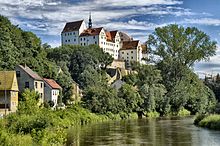
- The Central German Lake District surrounds Leipzig
- Lützen — about 20 km southwest, where two great battles have been fought during the Thirty Years' and the Napoleonic Wars, and where Gustavus Adolphus, one of the most famous kings of Sweden died in the Thirty Years War . Birthplace of the philosopher Friedrich Nietzsche.
- Merseburg – more than thousand-year-old town with interesting old centre, Romanesque/Gothic cathedral and Renaissance palace (30 km west)
- Halle — Leipzig's "twin city" some great things to see. Largest city in Saxony-Anhalt , birthplace of Händel and has a few castles. The cities are linked by frequent local trains, taking half an hour from one main station to the other (40 km northwest)
- Colditz — known for its castle that was used as a prisoner-of-war camp during World War II (50 km southeast)
- Naumburg — with its impressive, UNESCO-listed Romanesque cathedral, home town of philosopher Friedrich Nietzsche, centre of the Saale-Unstrut cultural landscape and wine-growing region can be reached in 40–50 minutes by train (60 km southwest)
- Dessau — former residence of the small principality of Anhalt; both the beautiful Dessau-Wörlitz "garden realm" and the Bauhaus school that pioneered modern architecture and arts are UNESCO World Heritage sites. Local trains run every hour, taking 45–55 minutes (70 km north)
- Lutherstadt Wittenberg — one of the most important sites of Protestant Reformation, is just half an hour away in ICE trains (75 km north)
- Dresden — a must-see with its old baroque centre, the Frauenkirche and its other attractions. Go there in just over an hour by train or car (120 km east)
- Weimar — Germany's "classical city", where several poets, philosophers and artists of the classical era lived and worked, is little more than an hour away by train (130 km southwest)
- Erfurt — the state capital of Thuringia with its medieval old town is 45 minutes away by high-speed train (145 km southwest)
- Berlin — the German capital is just over an hour away by ICE train (190 km north)
- Has custom banner
- Has map markers
- Airport listing
- Has mapframe
- Articles with formerly dead external links
- Articles with dead external links
- Do listing with no coordinates
- Articles with out of date events
- Buy listing with no coordinates
- Eat listing with no coordinates
- Drink listing with no coordinates
- Sleep listing with no coordinates
- Has routebox
- Has Geo parameter
- Leipzig Lowlands-Central Hills
- All destination articles
- Guide cities
- Guide articles
- City articles
- Pages with maps
Navigation menu
- Search Please fill out this field.
- Manage Your Subscription
- Give a Gift Subscription
- Sweepstakes
- City Vacations
Here's Why Leipzig Is Germany’s Most Fascinating City
In Leipzig, you’ll discover a new generation of artists and cultural provocateurs molding this city into one of Germany’s most dynamic and welcoming destinations.
Jeff Chu is an editor-at-large at Travel + Leisure .
:max_bytes(150000):strip_icc():format(webp)/Jeff-Chu-1-5ba972816d394d56b45b227b5e41b423.jpg)
Outside the Spinnerei, all I saw were stolid brick walls. But when I walked through the entrance and into the heart of this massive complex, which fills 25 acres in western Leipzig, I began to sense its story. Stylish young Germans bounced by on bikes, scarves fluttering in their wake. They popped into and out of a café in one building and a large art-supply store on the ground floor of another, stocking up on fuel for their creativity.
The Spinnerei has long been a place of imagining and making things destined for homes and bodies elsewhere. This was once central Europe's largest cotton mill, where, from the late 19th century and into the early 20th, hundreds of thousands of spindles produced countless yards of thread. As industry faded with the fortunes of East Germany, the buildings emptied — until they were rediscovered by a new generation of entrepreneurs.
Manfred Mülhaupt was one of the first to recognize the Spinnerei's potential. He arrived in the early 1990s, squatting with starving-artist friends in one of the Spinnerei's many disused buildings. They rode bikes up and down its wide hallways, painted by day, then danced all night. "The first two, three, four years, we didn't pay anything," he said. "Nothing was happening, so you had enough time to do your work. If you had a party, everyone would come because Leipzig had no bars. No nothing."
Today, the Spinnerei once again thrums with creative life. It houses shops, a restaurant, world-class art galleries, even an art-house cinema. Sunlight streams through the cast-iron casement windows, illuminating the work of the dozens of artists and designers who have ateliers here, including carpenters, sculptors, porcelain makers, and several painters of the famed New Leipzig School. You can even stay in the Spinnerei. Mülhaupt has carved out a four-room guesthouse, the Meisterzimmer, from rooms where he and his friends once squatted. I delighted in the numerous original details he has retained — heavy doors, bathroom fixtures, and pieces of furniture salvaged from the old factory. The Spinnerei, a textile mill that now houses galleries and shops. Ériver Hijano
Like the Spinnerei, Leipzig has found new vigor. Twenty-five years ago, it, along with most of the former German Democratic Republic, was in economic shambles. Over the decade after the fall of the Soviet Union, it lost nearly half its population. Tens of thousands of buildings sat empty, including massive factories, gracious Art Nouveau villas, and late-19th-century apartment houses with Renaissance- and Gothic-style flourishes.
But Leipzig, the largest city in the eastern state of Saxony, has grown faster than any other in Germany , adding more than 100,000 residents since 2000. (Its total population is now 570,000.) Magnetism has downsides. Over the past few years, the influx of artists and the city's affordability have led outsiders to proclaim Leipzig "the new Berlin." Many locals I talked to found that insulting. Why was Berlin — which is just over an hour away by high-speed train — the measure of a German city's worth? Soon Leipzig had another, even worse nickname, popularized by the mainstream media: "Hypezig," a sign of growing discomfort with and backlash against its recent appeal.
This represents both Leipzig's opportunity and its risk. It became popular because it was so unpopular. The city has a reputation for being less insular and more welcoming than, say, Munich or Berlin, but it doesn't necessarily share its secrets easily. "Leipzig is not really about buildings or institutions," Mülhaupt explained. "It's the people. It's their ideas. It's their willingness to try something out." From left: Leipzig, Germany, has a surprising number of green spaces, including Clara-Zetkin Park, which borders the Elsterflutbett River; Barfußgässchen, a restaurant row in the city center. Ériver Hijano
To visit Leipzig now is to experience an urban work in progress, one that is less of a rise and more of a resurrection. In this city that fostered Bach, Mendelssohn, Goethe, and Nietzsche, the centuries-old spirit of experimentation and the enduring ethos of possibility seem stronger than ever. Leipzig's driving force is hospitality — to new ideas, to new creativity, to new people. And none of this is a departure from its rich history. Indeed, it's on that venerable foundation that contemporary Leipzig is building its modern magic.
Leipzig sits at a historic crossroads. In the Middle Ages, it rose to prominence as a trading hub at the intersection of the Via Regia, a major east-west transcontinental route, and the Via Imperii, a north-south thoroughfare.
"The main reason for Leipzig becoming what it is today is its history," said photographer Jörg Dietrich, who makes panoramic photos of cityscapes. As we strolled the streets, he deciphered the histories knit into the surroundings for me. The picturesque, kayak-friendly canals? Part of an unfulfilled 19th-century plan to connect Leipzig's landlocked factories with Hamburg's seaport, 250 miles away. The necklace of lakes offering sailing and sandy beaches just a half-hour's bike ride from Leipzig's center? Open-pit coal mines, deliberately flooded over the past 20 years to transform the scars of the industrial past into recreation areas. The Fockeberg, a verdant, 500-foot hill providing sweeping views? World War II rubble — remnants of the Reich, piled up and planted over to create a pastoral idyll.
Leipzig's location also made it a nexus for the spread of new technologies and ideas. Its university, Germany's second oldest, was founded in 1409; Goethe and Nietzsche were both alumni. The world's first daily newspaper began publication here in 1650. In the late 19th and early 20th centuries, Leipzig became an industrial giant — hence the Spinnerei — as well as a rail hub; its central station is Europe's largest terminal. "Without this history, we wouldn't have these spaces," Dietrich said. A gallery at the Museum of Contemporary Art Leipzig. Ériver Hijano
Another era's loss presaged this one's gain. Take the Museum of Contemporary Art Leipzig, which, fittingly, puts stories of the past in conversation with the art and social concerns of the present day. Established after Germany's reunification, the museum occupies a lush city-center estate that pairs a villa built for a scientist in 1892 with a strikingly modern annex added in 2004. Accessibility was drafted into the architecture. The single-level annex has no stairs, just a gently sloped ramp, and giant windows on the side face the busy Karl-Tauchnitz-Straße. "It's a teaser. It says something to people outside. It's about transparency," curator Julia Schäfer told me. Until art was displayed in those windows, some passers-by mistook the building for a car dealership.
During my visit, the museum was preparing for its spring 2018 exhibition, "Gaudiopolis," which uses the City of Joy, a utopian experiment involving refugee orphans in 1940s Budapest, as its springboard. It deploys art to ask what compassion, democracy, and joy might look like in our times. In the past, the museum has commissioned work reflecting Leipzig's evolving social realities: a 2015 film by Viennese artist Anna Witt focuses on a recent refugee from Syria who came to live in Leipzig, as well as one who fled East Germany in the 1980s. "The point is not to put art on a pedestal or to see it as a masterpiece," Schäfer said. "It's to make connections."
The curatorial staff also uses the space to cultivate community. The museum sits across the street from the famed Academy of Visual Arts and engages students in collaborations. An old stable houses a piano school. And in 2010 and 2012, two former studios were redecorated by artists and converted into guest suites, making this perhaps the only museum in the world that doubles as an inn. "There's no room service," Schäfer said. "But there's art!"
German music is blooming," composer Robert Schumann wrote in 1840. He described his adopted hometown of Leipzig as a musical garden rivaling those of Europe's greatest cities. That musical tradition continues. One need only wander the city to experience it. In one afternoon, I heard: A busking violinist who couldn't have been more than 10 years old playing a Bach gavotte on the busy Petersstraße, a pedestrianized shopping street; a children's a cappella choir in the market square; a pianist practicing scales — up and down, up and down — in a residential neighborhood; and horns blaring out of a fourth-floor window of the conservatory founded by Mendelssohn in 1843. From left: Hotel Paris Syndrome by artist Jun Yang, one of two bookable guest suites that double as installations at the Museum of Contemporary Art Leipzig; “bondage,” a dish at the restaurant Falco that includes veal tongue, langoustine, and wasabi ganache. Ériver Hijano
In the mid 1700s, merchants and civic leaders created a musical ensemble for their own entertainment. Prior to that, nearly all European orchestras had been assembled as amusements for royalty or aristocracy; this one was for the people, and its first venue was a tavern. Eventually, the orchestra moved into the Gewandhaus — the "garment house," used by textile traders — and was renamed for that space in 1781.
Today, the Gewandhausorchester is one of the world's premier orchestras. It will mark its 275th anniversary this year by welcoming Latvian conducting dynamo Andris Nelsons as its new Gewandhauskapellmeister. Its radical accessibility endures. You can hear Gewandhausorchester musicians perform nearly every Saturday at 3 p.m. in central Leipzig's Thomaskirche, accompanying the church's famed boys' choir. Admission is just $2.50.
J. S. Bach served as choir director here for 27 years. Fittingly, the Saturday programs spotlight his work — a rare opportunity to hear classical music performed in the space for which it was written. One Saturday, I crammed myself into a crowded pew in the Gothic sanctuary, which has been largely unchanged for five centuries. What history this space has witnessed: on Pentecost Sunday in 1539, Martin Luther, who had already been excommunicated from the Roman Catholic Church, preached a sermon here.
As the first bars of a Bach motet filled the space, tears came to my eyes, which surprised me. I grew up playing Bach. But it took years for rehearsal's agony to mature into something approaching appreciation, and I still summon the anxiety more quickly than the joy.
The piece they were playing, based on the 149th Psalm's opening lines, is called Singet dem Herrn ein neues Lied : Sing to the Lord a new song. It debuted in 1727, early in Bach's tenure, when he was still building his reputation. He hadn't even been the church's first choice for the job — or its second.
I imagined a bewigged Bach testing his new composition on the congregation with hopeful anticipation. I scanned the diverse crowd. Afternoon light streamed through the stained-glass windows to dance on an elderly man's dampened cheeks. In front of him, a middle-aged couple sat, hands interlaced, her head tucked into his neck and shoulder. Two young men, dressed more for a nightclub than a church, stared at the ribbed ceiling.
The Gewandhausorchester musicians' contracts require them to perform not only in the symphony hall and the opera house but also in the Thomaskirche. The experience feels sacred to them, too. "You are playing this piece composed by Bach where he may have written it," said Turkish-born violinist Kivanç Tire when I met him and violist Tahlia Petrosian after the concert. "Bach is our god!"
Entrepreneurial, not divine, inspiration led Petrosian to launch a series of musical after-parties called Klassik Underground. She wanted to give visiting soloists an opportunity to play in a different setting, and stars including Joshua Bell have accepted her invitation. Once every month or so, soon after the symphony packs up its instruments at the concert hall, some of the musicians reconvene 20 yards away, in the Moritzbastei. These ancient cellars, remnants of Leipzig's 16th-century fortifications, have been converted into a cultural center.
Tickets are just $12, and the format is decidedly experimental. For last June's Klassik Underground concert, soprano Christina Landshamer sang a Bach cantata accompanied by both Gewandhausorchester musicians and images created by Leipzig-based painter Tilo Baumgärtel, which were projected onto the Moritzbastei's walls and vaulted ceilings. Petrosian uses technology to spread the music's reach; every show is recorded on video, then posted online.
"There are lots of opportunities in Leipzig that you wouldn't have elsewhere. From that standpoint, it doesn't get better," said Petrosian, who is Australian. "In bigger cities, it would be very difficult to do projects on the side — and you wouldn't be as revered as you are here." From left: Travelers can navigate the city using the historic, affordable tram system; a room at Meisterzimmer, a guesthouse in the Spinnerei. Ériver Hijano
Later that night, I visited Horns Erben, a bar and music venue in a converted distillery south of the city center. Claudius Bruns, a writer and cabaret singer who manages Horns Erben and lives upstairs, was a pioneer in reincarnating old industrial spaces into new gathering places, a practice that continues today in the bars, restaurants, and clubs that are constantly popping up across the city.
When Bruns moved in, much of the Horns Erben space hadn't been updated since the early 20th century; there were old toilets and ancient heaters in the rooms. Today, the woodwork gleams. Industrial-grade carpets were stripped away, revealing original floorboards. Behind a wall, Bruns discovered an Art Deco door. The building's various closets and crannies are still giving up artifacts from Germany's fraught last century: Weimar-era glass bottles; a box of cigarettes from the 1940s; and most recently, a cache of 1970s East German posters giving instructions for what to do in an American nuclear attack.
Horns Erben's rich past inspired Bruns to stage a monthly improv-theater show in the upstairs bar. He calls the genre "improvised history theater." The series riffs on a fictional bar's communal life through the decades, beginning in 1920. Each show examines three months of German history. They're now into the 1950s.
The wartime shows, Bruns told me, were especially intense: "The actors would say, ‘ Willkommen! Heil Hitler! I'm glad the Jews aren't here anymore.' " The audience was unsettled. The performers strained to stay in character. "It felt so weird in this room, which is not a new room. We assume in that time there were some Nazis here. At the same time, it's history. It's not strangling us."
In 2017 Bruns created another improv show about fascists' reemergence in contemporary Germany. "We can't pretend they're not there," he said. Indeed: in September, when Germans reelected the centrist (and Leipzig University alumna) Angela Merkel as chancellor, they also sent far-right representatives to the Reichstag for the first time since the Nazi era. Here in Saxony, the populist, anti-immigrant far right garnered more than a quarter of the vote. In some parts of the state, it tallied 35 percent — more than anywhere else in Germany. "It's so frightening," Bruns says. "I thought we had overcome." Fashion designers Eva Howitz and Frieder Weissbach on the Cospudener See, a man-made lake. Ériver Hijano
It can be hard to square such xenophobic impulses with the insistent testimony I heard from locals, transplants, and visitors alike that Leipzig is an uncommonly open German city. One afternoon, I met local fashion figures Eva Howitz and Frieder Weissbach for drinks. Their footwear and clothing designs, bearing the Howitzweissbach label, blend the region's craft traditions — shoemaking in nearby Weißenfels, textile work from the village of Jahnsdorf — with sculptural and architectural forms taught in Leipzig's academies. Howitz and Weissbach ignore the conventional fashion-season calendar, and their work, which has a particularly strong following in Australia and Kuwait, sits defiantly outside their industry's mainstream. In Leipzig, they feel free of both the commercial pressures of the larger fashion scene in Berlin and the cultural conservatism of surrounding Saxony. "Leipzig is a bit of an island. We have a heterogeneity you can feel," Weissbach said, citing the city's inspirational mix of students, artists, entrepreneurs, and musicians. "You're quickly a friend when you come here," Howitz added.
This is the Leipzig I encountered. Such eagerness to please often manifests in unconventional ways, including at the table. Take Falco, the only restaurant with two Michelin stars in the former East Germany outside Berlin. Chef Peter Maria Schnurr does serve an elaborate, $308 eight-course tasting menu, which includes a knowingly ostentatious dish-as-social-commentary called "high roller" — an assemblage that includes raw scallops, Royal caviar, hazelnut oil, and lovage. But the governing ethos of the restaurant, which sits on the Westin Hotel's 27th floor and is named for the falcons that nest outside its windows, is decidedly more egalitarian. It offers a more modest $123 prix fixe and, in the bar, a $55 one. If that's still too dear, "come spend 12 euros and have dessert," said Schnurr, an ebullient character so determined to push against fine dining's conventions that he once outfitted his servers in hoodies and red Adidas tracksuit pants.
You'll find a similarly hospitable spirit on the other side of town at Das Japanische Haus ("the Japanese House"), a community center established in 2011 by Fukuoka-born architect Noriko Minkus. Many buildings in Leipzig's east remain unrenovated. Graffiti abounds. Gentrification worries Minkus, but rents are still affordable for spaces like Das Japanische Haus. Patrons of Das Japanische Haus, a community center. Ériver Hijano
The name understates Das Japanische Haus's mission: it gathers people from all nations. At 4 p.m. every Thursday and Saturday, dozens meet to cook a communal meal. (Come at 6 if you just want to eat. There's no set price; you pay what you can afford. The Haus is supported by donations and grants.) Minkus showed me the sign-in sheet from the most recent dinner. The attendees listed their homelands: Germany and Japan, of course, but also more than 30 other countries, including Syria, the U.S., and Botswana.
"The concept is to cook and eat together," said Minkus, a relentlessly cheerful figure. Not everyone converses easily; the most common language is English, not German. The menu is usually vegan, to assuage as many dietary concerns as possible. "Everybody can cut vegetables. Everybody gets hungry. Everybody is welcome," she said, echoing a now-familiar refrain. "Everybody."
A Cultural Tour of Leipzig
Art and music lovers are spoiled for choice in this thriving, progressive city, perfect for a three- or four-day visit.
Getting There
While there are no nonstop flights from the U.S. to Leipzig/Halle Airport, you can connect via Frankfurt or Munich on Lufthansa. Deutsche Bahn operates high-speed nonstop train service from Berlin that takes about 75 minutes.
Getting Around
The historic center is easily walkable. To get to the Plagwitz and Lindenau neighborhoods, where most art galleries are located, as well as East Leipzig, home to the newest bars and boutiques, I relied on the efficient tram and bus network (most rides cost $3 each; a one-day pass is $9).
I stayed at the discreet Luxury Collection property Hotel Fürstenhof Leipzig (doubles from $187), Leipzig’s take on the traditional European grande dame. Built in the 1770s as a home fora wealthy family, it was converted into a hotel in the 1880s; everyone from Marlene Dietrich to rockers AC/DC has checked in. The Meisterzimmer (doubles from $112) is a four-apartment pensione carved out of onetime industrial space in the Spinnerei complex. The apartments have soaring ceilings and massive windows, but beware, there are no curtains or shades yet — I loved the light in the afternoon, not so much in the morning. You can also book one of the two suites at the Museum of Contemporary Art Leipzig (doubles from $149), considered to be art installations in the museum’s collection. One, created by Chinese-Austrian artist Jun Yang, explores themes of counterfeiting and imitation; the other, by Berlin-based American artist Christine Hill, is inspired by the motifs of a hardware store.
Eat & Drink
Falco (tasting menus from $55), in the Westin Hotel, has several set menus that range in price but all feature Peter Maria Schnurr’s playful contemporary European cuisine. For something more casual, Pekar (entrées $7–$12) serves seasonally driven small plates and pizzas. For a drink, try Rudi ; the selection of German gins is excellent.
Experiences
Most Saturdays at 3 p.m., you can hear the famed St. Thomas Boys Choir and the Gewandhausorchester performing a Bach cantata at the Thomaskirche . In Plagwitz, the Spinnerei has numerous galleries, shops, and a restaurant; guided tours of the complex are offered on Fridays and Saturdays. The Klassik Underground (klassikunderground.de) is where top classical musicians perform after hours. The Museum of Contemporary Art includes works by Leipzig-trained painters such as Neo Rauch but also Americans Sarah Sze and Dan Peterman. Leipzigers are rightly proud of their parks. Rent a bike from one of the many Nextbike stations ($1 per 30 minutes, capped at $11 for a full day). A 30-minute ride south on dedicated trails will bring you to Nordstrand, the beach on the northern shore of the Cospudener See. A seven-mile path circles the lake, and there are restaurants both on the beach and at the Pier 1 marina. You can also rent a kayak ($7 an hour or $44 a day) or a canoe ($12 an hour, $62 a day) at Leipzig Harbor (Stadthafen). Go north along the canals to Plagwitz,or south via the Elsterflutbett to the Cospudener See.
Content in this article was produced with assistance from Hotel Fürstenhof Leipzig, a Luxury Collection Hotel.
- The Top 8 Things To...
The Best Things to See and Do in Leipzig

Berlin, Cologne and Munich may draw more crowds, but there are plenty of hidden gems to discover in Leipzig – one of Germany’s most liveable cities. Nicknamed ‘Hypezig’ due its great nightlife, plus a thriving art and music scene, it’s also easy on the eye with its beautiful old buildings, three rivers and many bridges. Follow the footsteps of Johann Sebastian Bach at St Thomas Church, ponder art in the Museum der bildenden Künste and dance to techno in the infamous Distillery nightclub – here’s our round up of the best places to spend your time while in the city.
Visit leipzig’s beautiful st thomas church.
With Johann Sebastian Bach as its choirmaster for 27 years, it’s easy to see why St Thomas Church has a special place in Leipzig’s history. The 600-year-old gothic church now serves as the composer’s final resting place, but it’s also home to the celebrated St Thomas Choir – you can catch performances on Fridays and Saturdays. Other famous figures have frequented its walls – see where Martin Luther gave sermons and Mozart played the church organ.

Catch a show at Oper Leipzig

Party ‘til the early hours at Distillery
Affectionately known as the ‘Tille’, the Distillery nightclub, on the bustling Kurt-Eisner Strasse, is the oldest and one of the most influential techno clubs in Germany. But don’t worry if techno isn’t your scene – there are two floors pumping out everything from reggae and soul to house and drum ‘n’ bass in various corners. Plus, there are frequent live acts with previous sets from Ellen Allien and Carl Craig – book tickets early.
Stroll through Leipzig Market Square
You’ll undoubtedly pass through Leipzig Market Square. It’s enormous and surrounded by a hodge-podge of traditional German architecture and glistening steel-and-glass buildings. The old city hall is particularly impressive with its mint domed clock tower, dating back to the 16th century. Snap a photo before sidling off to Café Bigoti around the corner for one of the best coffees in town.

Marvel at the Monument to the Battle of the Nations
Leipzig’s Monument to the Battle of the Nations was erected in 1913, in celebration of 100 years since Napoleon’s defeat and retreat from Germany. Standing at 91m tall, you can climb 500 stairs to the top where a splendid view of the city awaits. Inside, there is also an abundance of historical information regarding the 1813 battle that finally excised Napoleon from the city. Hitler himself was known to frequent the towering structure, and he even housed his meetings in the city here. It was one of the final strongholds in the city left when the Allies captured Leipzig at the end of the war.

Sip wine in Auerbach’s Cellar
Bach and Martin Luther weren’t the only German historical figures with important connections to Leipzig. Goethe – often regarded as Germany’s Shakespeare – also spent time in the city, as he studied at Leipzig University. Goethe loved to eat and drink at Auerbach’s Cellar, which also happens to be the second oldest restaurant in the city. The wine bar has existed since 1438, making this is an excellent spot to enjoy a drink whilst steeped in the city’s rich history. Despite the fact that this place airs on the touristy side of things, the atmosphere is cosy, and the food is still quite good.

Browse artworks at Museum der Bildenden Künste
Often regarded as an up-and-coming city with an emerging arts scene, no trip to Leipzig would be complete without a look around its art galleries. Swing by Leipzig’s museum of fine arts, Museum der Bildenden Künste. The vast glass building itself is worth marvelling at. Inside, it holds a large collection of paintings, ranging from the 15th century to the present, with notable works by Monet and Munch.

Spot wildlife at Leipzig Zoo
Take a break from the urban landscape and pop into Leipzig Zoo. Spanning across 27ha of land, it’s home to over 850 different species – hailing from Africa, South America and Asia. Notably, Pongoland is a real highlight where a multitude of different primates live, including chimpanzees, bonobos, gorillas, orangutans, and more. Explore the world’s largest indoor rainforest atrium – a great place to hang out when it rains. Bonus for English speakers: nearly every plaque is translated.

Did you know – Culture Trip now does bookable, small-group trips? Pick from authentic, immersive Epic Trips , compact and action-packed Mini Trips and sparkling, expansive Sailing Trips .
Since you are here, we would like to share our vision for the future of travel - and the direction Culture Trip is moving in.
Culture Trip launched in 2011 with a simple yet passionate mission: to inspire people to go beyond their boundaries and experience what makes a place, its people and its culture special and meaningful — and this is still in our DNA today. We are proud that, for more than a decade, millions like you have trusted our award-winning recommendations by people who deeply understand what makes certain places and communities so special.
Increasingly we believe the world needs more meaningful, real-life connections between curious travellers keen to explore the world in a more responsible way. That is why we have intensively curated a collection of premium small-group trips as an invitation to meet and connect with new, like-minded people for once-in-a-lifetime experiences in three categories: Culture Trips, Rail Trips and Private Trips. Our Trips are suitable for both solo travelers, couples and friends who want to explore the world together.
Culture Trips are deeply immersive 5 to 16 days itineraries, that combine authentic local experiences, exciting activities and 4-5* accommodation to look forward to at the end of each day. Our Rail Trips are our most planet-friendly itineraries that invite you to take the scenic route, relax whilst getting under the skin of a destination. Our Private Trips are fully tailored itineraries, curated by our Travel Experts specifically for you, your friends or your family.
We know that many of you worry about the environmental impact of travel and are looking for ways of expanding horizons in ways that do minimal harm - and may even bring benefits. We are committed to go as far as possible in curating our trips with care for the planet. That is why all of our trips are flightless in destination, fully carbon offset - and we have ambitious plans to be net zero in the very near future.

Places to Stay
The best cheap hotels and hostels to book in leipzig, germany.

The Most Unique Hotels in Leipzig, Germany

The Best Hotels in Leipzig, Germany
Culture trip spring sale, save up to $1,100 on our unique small-group trips limited spots..

- Post ID: 843053
- Sponsored? No
- View Payload

Tourist Information

The Tourist Information Centre provides the following services:
- information leaflets and brochures
- street maps
- insider tips
- souvenirs of Leipzig
- travel offers for individuals and groups
- LEIPZIG CARD
Tours of the city on foot or by vehicle and tickets for events can be purchased from our highly competent partners.
Get more information on the website of the Leipzig Tourismus and Marketing GmbH .
Call Center of the Tourist Information:
Telephone: +49 (0)341 7104-260 Fax: +49 (0)341 7104 271 E-Mail: [email protected]
Opening Times
Monday to Friday: 9.30 am to 6 pm Saturday: 9.30 am to 4 pm Sunday: 9.30 am to 3 pm
Phone Numbers of the Tourist Information and Touristic Partners
Tourist information.
Telephone: +49 341 7104-260 (Monday to Friday 9 am to 5 pm)
Accommodation service
Telephone: +49 341 7104-255 (Monday to Friday 9 am to 5 pm)
Individual and group travel
Telephone: +49 341 7104-275 (Monday to Friday 9 am to 5 pm)
City walks and tours
Telephone: +49 341 7104-280
Ticket sale
Telephone: +49 341 14 14 14
- Back To Top

5 Ways Tradition Meets Innovation in Leipzig—and Why You Should Visit Now
Home to world-class music festivals, historic landmarks, idyllic nature, and inspiring galleries, the past and future are inextricably intertwined in this charming metropolis..
- Copy Link copied

Leipzig is a green city with beautiful parks and nature throughout.
Photo ©PK Fotografie
Best known as a mecca of music, Leipzig is a dynamic, cosmopolitan city rooted in history, offering travelers a diverse array of enriching activities where heritage and modernization connect. To the delight of any history buff, here the past comes alive at every turn, its delightful aspects as well as its darkest shadows. Happily, the lessons of the past exist side-by-side with today’s giant rays of hope; they all converge in Leipzig’s exalting culture scene.
The spirit of protest is alive and well: the city hall was formerly the site of the fortress where, in 1519, Martin Luther made the break with Rome that gave rise to the Protestant faith. And, as the site of the 1989 Peaceful Revolution, Leipzig continues to stand for forward-thinking change today.
Indeed, the spirit of innovation and progress—from centuries-old history to the present day—is the core value of Leipzig: a magnificent metropolis whose cultural scene welcomes the creative traveler with open arms and minds.

The internationally renowned St. Thomas Boys Choir on the steps in front of St. Thomas Church
1. Europe’s City of Music
Hardly any other city on Earth can claim as rich a musical heritage as Leipzig, which has reversed its musicians, past and present, for more than 800 years, celebrating them with world-class festivals every year. Travelers can attend a performance of the St. Thomas choir, a world-renowned boys choir and the city’s oldest cultural institution, at the 13th-century Gothic St. Thomas Church, where the music director was none other than Johann Sebastian Bach.
Afterward, walk the 3.3-mile Leipziger Notenspur (Leipzig Music Trail), where you’ll encounter the original workplaces of famous composers including Felix Mendelssohn, widely known as the most important conductor to front Leipzig’s Gewandhaus Orchestra and thought to have fundamentally changed the city’s musical scene. You’ll also see where composers Edvard Grieg, Clara and Robert Schumann, and Richard Wagner worked, the Gewandhaus Orchestra, and the Opera Leipzig along the trail.

Take in the exhibitions at galleries at the Tapetenwerk Leipzig.
2. A bastion of creativity and innovation
For young creative people, Leipzig is no longer an insider secret. The city is renowned across the globe for its dynamic art, music, and festival scenes. Tradition, openness, and the high “feel-good” factor continually attract creatives to the city to stay, making Leipzig a trendy visitors’ destination for individualists. Head to Plagwitz and Lindenau in the west of Leipzig and discover the Spinnerei.
Once Europe’s largest cotton mill, yarn production ceased in 1992, its industrious spinning replaced by the even more dynamic energy of Leipzig’s artistic community. Today, the Spinnerei is an internationally famed art center that’s home to upwards of 100 artists’ studios and eleven galleries and exhibition spaces—an impressive repurposing that now forms a center of the Leipzig art scene, unrivalled worldwide.
More visual inspiration is on offer at Museum of Contemporary Art, home to international modern art created from 1945 to the present. In Leipzig, inspiration is eternal and ubiquitous: here, creative types don’t just feed their soul, they gorge as at a year-round holiday feast. Are you that culture-vulture who journeys far to visit the haunts of poets, philosophers, and preachers? In the city that was home to Schiller and Goethe, you’ll be delighted to visit the latter’s favorite beer hall, Auerbachs Keller (which he immortalized in a scene of Faust ).

St. Nicholas Church, the site of the Peaceful Revolution
Photo ©PUNCTUM
3. The Peaceful Revolution
An absolutely transporting experience is guaranteed at Nikolaikirche (St. Nicholas Church), where worshippers started praying in 1982 for a peaceful end to the Cold War buildup of nuclear weapons. By October 1989, congregants were protesting the growing repressions of the SED (or East German Communist Party) regime. On October 9, 1989, around 70,000 people took to the Leipzig streets, despite the threat of a command to shoot. With candles in their hands, they peacefully demanded more freedom and democracy in East Germany—a decisive catalyst for the start of the Peaceful Revolution that finally led to the fall of the Berlin Wall. Chanting Wir sind das Volk (We are the People) and “No Violence,” people marched across the city’s inner-city ring road.
Then, on November 9, 1989, the Berlin Wall collapsed. With this Peaceful Revolution, the good people of Leipzig changed the course of history for the benefit of all: a great comfort when visiting the Stasi Museum, which has kept intact the headquarters of the secret police, complete with drab linoleum and fluorescent fixtures, plus audio tours and displays serving as a sober reminder of what life used to be like in East Germany.

Leipzig’s industrial heritage and waterways
4. A water enthusiast’s dream
Are you most in your element on the water ? Lucky you, Leipzig boasts more bridges than Venice. It’s also located directly on the water, and while almost all of Leipzig is walkable, it’s a great place for a scenic boat ride. To see first-hand why one of the city’s nicknames is “Little Venice,” book a canoe, kayak, inflatable boat, or boat tour and embark on a journey through the city’s interlocking system of natural rivers and canals. Among them is the Karl-Heine-Canal, a two-mile artificial waterway that runs through the Western part of the city, featuring no fewer than 15 bridges. Traversing it, you’ll pass by several historic sites, among them the golden-hued tower of the Philippuskirche (Philip Church) in the Lindenau district and former industrial architecture with artistic façades.

Picturesque New Lakeland at the gates of the city
5. A culture-rich region
Within an hour’s drive from downtown Leipzig you’ll find castles, fortresses, and miles of idyllic cycling and hiking trails. This is also the location of the Leipziger Neuseenland (New Lakeland), a district of more than 20 distinct, family-friendly lakes with activities to suit every holidaymaker’s taste. These flooded lakes are impressive feats of man-made engineering, parts of an ambitious project that will see completion in 2060. The largest lake, Zwenkauer See, has a maximum depth of 159 feet and is on the site of a former lignite open cast mine. The lakes are perhaps the ultimate expression of the region’s spirit of change that makes Leipzig such an extraordinary, unforgettable destination.

Advertisement
Rb leipzig usa tour 2024: schedule, tickets, stadiums and more, share this article.
For the first time ever, RB Leipzig will conduct a preseason tour of the United States.
The Bundesliga side has announced a two-game tour of the United States, marking the first time it has held its preseason outside of Europe.
RB Leipzig will set up camp in New Jersey at the academy of its sister team, the New York Red Bulls.
“This will be our first preseason outside of Europe, and with the USA we decided to go to a key target market for our club,” said general manager Johann Plenge. “RB Leipzig excites soccer fans both domestically and internationally with its unique story, which has taken us from the fifth division to the Champions League.”
The club has already announced a friendly against Aston Villa at Red Bull Arena, with one further match yet to be confirmed.
Here are the fixtures for RB Leipzig’s summer tour of the United States, with information on purchasing tickets set to come.
RB Leipzig USA tour 2024
July 31: RB Leipzig vs. Aston Villa — Red Bull Arena, Harrison, NJ.
Bundesliga 2023-24 top scorers: Tracking the German goalscoring race
Soccer champions tour 2024: schedule, tickets, stadiums and more, wrexham usa tour 2024: schedule, tickets, stadiums and more.
We occasionally recommend interesting products and services. If you make a purchase by clicking one of the links, we may earn an affiliate fee. Pro Soccer Wire operates independently, though, and this doesn’t influence our coverage.
Most Popular
La liga 2023-24 top scorers: tracking the pichichi race, liga mx clausura 2024 top scorers: tracking the golden boot race, inter miami roster and salaries for 2024 mls season, 'hello' - smith pauses tv interview to call out thorns for team photo without her, asian cup 2024: schedule, how to watch and live stream, the top 25 highest-paid premier league players in 2023-24, the top 25 highest-paid mls players in 2023.
Please enter an email address.
Thanks for signing up.
Please check your email for a confirmation.
Something went wrong.
Recommended
Cops raid illegal nyc pot shop just one day after defiant worker dared nypd to shut down the store.
- View Author Archive
- Email the Author
- Get author RSS feed
Contact The Author
Thanks for contacting us. We've received your submission.
Thanks for contacting us. We've received your submission.
It didn’t take much to smoke these guys out.
Cops raided an illegal pot shop in Brooklyn Monday – a day after an irate, weed-puffing worker dared authorities to shut down the store and boasted he doesn’t “give a f–k.”
The sheriff’s office and NYPD swept through Gelato marijuana shop on 86th Street in Bay Ridge, hours after The Post reported on the shop and a citywide epidemic of unlicensed weed sellers.

“We’re happy to respond to community complaints,” city Sheriff Antony Miranda, who was on the scene, told The Post.
Authorities took cannabis flowers, edibles, pre-roilled joints, THC vapes and illegal flavored vape products out of the store — slapping them with $25,000 worth of penalties, a spokesperson for Mayor Eric Adams said.
The raid comes after the worker offered a Post reporter a puff of a joint on Sunday, saying promises to padlock the illicit shops was “nothing new.”
“That’s always been a possibility of getting raided here,” the worker said. “But I’m not going to be put out of a job!
“I’ll put a table outside and sell in the street. I don’t give a f–k! You can’t mess with a person’s money!”

The worker promised everyone “will adjust” and added: “They’re housing illegal immigrants and paying their way to get the vote for Biden, and this is what they’re going to do? Come raid pot shops?”
City Councilman Justin Branna, who represents the area, mocked the store as authorities swept through the shop.
“Play stupid games, win stupid prizes. If you are operating completely illegally, maybe don’t talk trash and taunt the authorities in the NY Post. Just a thought,” Brannan wrote on X .
Brannan later told The Post that Gelato has been on the community’s “radar” for some time.
“I support the legalization of recreational marijuana but these new retail licenses from the state will be worthless and tax revenue will be a far cry from what’s anticipated unless we get more licenses out the door and get serious about the illegal weed shops masquerading as legit dispensaries,” Brannan said.
The Post visited numerous suspected illegal cannabis locations on Sunday, more than week after the mayor and Gov. Kathy Hochul held a victory lap press conference hailing a tougher state law making it easier to padlock unlicensed cannabis shops — but the change wasn’t immediately followed up with the promised crackdown.
Many illicit pot shops have immediately reopened after raids and temporary shutdown orders.
“We have not started enforcement under the new law yet. That’s coming in the next couple weeks,” the mayor’s spokesperson said on Monday.

“Gelato has been on our radar for a while and it’s been raided several times so everyone is hopeful the new laws they just passed in Albany will finally get this right and give the City of New York the power we should have had all along,” Brannan added.
The store is just one of more than 100 suspected illegal weed shops that The Post was able to identify in short order by reaching out to a few elected officials, community boards and business groups.
Community Board 10 in southern Brooklyn — which covers Bay Ridge, Dyker Heights and Fort Hamilton — identified more than 20 illegal pot shops.
Adams last week claimed there are as many as 2,800 illegal smoke shops in the city while there are only 53 state-licensed dispensaries in the city and just 116 in the entire state.
Share this article:

Advertisement
RB Leipzig set for first US tour in summer 2024
Red Bulls²: Base camp at RBNY | Friendly against Aston Villa | Wide range of activities and events planned | Reunion with Emil Forsberg
Family Business in New York: RB Leipzig, two-time Germann Cup winner, will leave Europe for preseason for the first time in its history, with a trip to the USA planned from July 28 to August 4 .
During the US tour, Marco Rose and his team will set up base camp at the New York Red Bulls Academy in Whippany, NJ, and are sure to see some familiar faces during their stay such as Emil Forsberg (2015-2024 at RB Leipzig), RBNY head coach Sandro Schwarz and Jochen Schneider , Head of Sports at the MLS club and previously part of the management at Leipzig from 2015 to 2019.
US is calling!
Friendly against Aston Villa
On top of that, RB Leipzig will also play its first friendly of the 2024/25 season in the Red Bull Arena in Harrison, NJ . The team will face English Premier League side Aston Villa on July 31 with kick-off at 8pm local time.
The seven-time English champion, who has former Leverkusen players Leon Bailey and Moussa Diaby in its ranks, currently sits fourth in the Premier League and, like RB Leipzig, is on course for Champions League qualification. Leipzig is planning a second friendly at the end of the tour on the East Coast.
Plenty of activities planned off the pitch
Alongside the friendly games and daily, high-intensity practice sessions, there will also be lots of events happening away from the turf in the New York metropolitan Area . They include the unveiling of the new RB Leipzig jersey for the 2024/25 season, CSR activities, public training, autograph sessions and some exciting collaborations with Red Bull athletes in North America.
Das Tour-Announcement
Johann Plenge, RB Leipzig General Manager
- “This will be our first preseason outside of Europe, and with the USA we decided to go to a key target market for our club. RB Leipzig excites soccer fans both domestically and internationally with its unique story, which has taken us from the fifth division to the Champions League. We’ve brought the world of soccer back to Leipzig with our exciting European runs in recent years and as a host city for EURO 2024 . Now we’re bringing Leipzig to the world! We want to take advantage of our good and special connection to New York and strengthen it for years to come. It’s an important step for us, but also for the Bundesliga, which rightly enjoys a great reputation in the US.”
Rouven Schröder, RB Leipzig sporting director
- “Our coaching staff and players can look forward to an incredibly professional training camp with two friendlies against ambitious opponents. With the 2026 World Cup on the horizon, the USA is one of the most exciting sports markets in the world, and its love for soccer continues to grow. This trip to the US will create some great memories for our team and we’re looking forward to meeting our colleagues at New York Red Bulls and the MLS .”
Emil Forsberg, 325 appearances for RB Leipzig
- “All of us at RBNY – and myself in particular – are really excited that RB Leipzig is coming to New York for its first US tour. It will be a special reunion with players, coaches and staff for me that I wasn’t expecting so soon. Not only are the conditions at our training complex great, but New York is also the perfect city for RB Leipzig and the Bundesliga to become better known in the USA. I’m sure that we’ll have a great time together.”
The MVP kids' trip to Leipzig
Several connections between RB Leipzig and the USA
Over the years, RB Leipzig has been able to establish several links to the USA and to New York specifically. Former US international Terrence Boyd (14 caps) was the first American to feature for the club, playing there from 2014 to 2017. Fellow American Tyler Adams then joined RB Leipzig in 2019 after having spent the previous four years at the New York Red Bulls . The midfielder would go on to score the winning goal in our Champions League quarterfinal against Atlético Madrid in August 2020, helping us reach the semi-finals of the competition for the first time in our history. The 2022/23 season then saw US youngster Caden Clark make the move to Leipzig, also from RBNY. Additionally, Jesse Marsch enjoyed a stint at the club as an assistant coach in 2018/19, before returning as head coach from July to December 2021.
RB Leipzig was also involved in hosting youth soccer camps in the New York metropolitan area in both 2022 and 2023. Over 300 kids took part in the week-long camps in Hoboken, NJ and Brooklyn, NY, which were led by coaches from the RB Leipzig Soccer School. The respective MVPs from each camp were rewarded with the opportunity to fly to Germany in order to attend a home game at the Red Bull Arena.
Recently, the club’s academy hosted players from the New York Red Bulls’ U13 and U14 sides. On top of joint practices and off-field activities, the teams also took part in several friendlies, as well as attending the Bundesliga game against VfL Wolfsburg.
New York Summer Camp 2022
Top 3 in the USA
In addition to various on-the-ground activities, the club has also been able to reach millions of fans in the USA with the help of TV, streaming platforms and its social media channels. RB Leipzig is currently among the top three Bundesliga teams in terms of US TV ratings. Of the club’s nearly seven million followers across various social media platforms such as Instagram , TikTok and YouTube , a total of 10 per cent are already from the USA.
In order to continue serving their ever-expanding international audience, RB Leipzig has also launched an English-language WhatsApp Account ( @RBLeipzigEnglish ). In addition to expanding their English website coverage, the club is planning to release an English-language version of its official app on top of that.
Subscribe to the newsletter now for all information about RB Leipzig's US tour.

We are Leipzig!
More From Forbes
Rb leipzig to play aston villa on summer us tour.
- Share to Facebook
- Share to Twitter
- Share to Linkedin
RB Leipzig announced that the club will hold a training camp in New Jersey from July 28 to August 4. ... [+] As part of the US Tour the club will play Aston Villa on July 31 at the New York Red Bulls Arena in Harrison, NJ. Photo: Jan Woitas/dpa (Photo by Jan Woitas/picture alliance via Getty Images)
For the first time in the club’s history, RB Leipzig will play two preseason friendly matches in the United States this summer. Leipzig will train at the New York Red Bulls Academy in Whippany, New Jersey, the home of its Major League Soccer sister club, the New York Red Bulls.
“This will be our first preseason outside of Europe, and in the United States, we decided to go to a key target market for our club,” RB Leipzig CBO Johann Plenge said in a club statement. RB Leipzig excites soccer fans both domestically and internationally with its unique story, which has taken us from the fifth division to the Champions League.”
The club will also play a friendly against Aston Villa at the Red Bull Arena in Harrison, New Jersey, on Jul. 31. On Aug. 4, the club plans to play a second friendly against a yet-to-be-determined opponent somewhere on the East Coast.
“We will be at their training facilities and have a very close exchange with them,” Plenge said when asked why Leipzig opted not to play against their sister club. “We wanted to play Aston Villa because we think it is exciting to bring together European teams and have them compete in the US. Aston Villa has been playing an impressive season not only in the Premier League but also the Conference League.”
What does the tour mean from a commercial standpoint? According to RB Leipzig , the club is currently among the top three Bundesliga teams in terms of US television ratings. The club also has seven million followers on various social media platforms, 10% coming from the United States.
Apple’s iPhone AI Plans Confirmed With New Software Release
Packers complete safety overhaul with georgia’s javon bullard, sopranos star on james gandolfini s caring reaction to her ms diagnosis.
Johann Plenge, Managing Director of RB Leipzig, announcing the club's US Tour at the Red Bull Arana ... [+] in Leipzig (Photo by Jan Woitas/picture alliance via Getty Images)
“Soccer fans in the United States are following the RB Leipzig story,” Plenge said. “We are convinced that it is a great story, and we want to spread the word about our story and reach more fans. But it is also important for our partners. First and foremost, Red Bull in the US market is very relevant for the brand, and we will try to activate together.”
That activation will also include presenting new kit sponsor Puma and working together closely with sister club New York Red Bulls. “We will go to the match on July 30 [against Pachuca] and do commercial activations,” Plenge said. “We will also do commercial activations with our new equipment partner and launch our jersey during the US tour.”
One of the key aspects of the tour will be to work closely with the New York Red Bulls. “For me, that’s more important than connecting our soccer team with other kinds of sports,” Plenge said. “I want our coaches to exchange, the sporting directors to exchange, and most importantly our players.”
Focusing on player engagement makes sense from an RB Leipzig point of view. After all, in the likes of Tyler Adams and Caden Clark, RB Leipzig has recruited from the Red Bulls in the past. Finding more talent in North America through their sister club has been, in fact, something Leipzig has wanted to deepen for some time, and the US Tour will, therefore, be a two-way street of exchanging ideas.
Player transfers, however, haven’t been just one way. In February, Leipzig legend Emil Forsberg headed stateside to join the New York Red Bulls. The Swedish playmaker has voiced his excitement about seeing his former teammates. “Not only are the conditions at our training complex great, but New York is also the perfect city for RB Leipzig and the Bundesliga to become better known in the USA,” Forsberg said before concluding. “I’m sure that we’ll have a great time together.”
Manuel Veth is the host of the Bundesliga Gegenpressing Podcast and the Area Manager USA at Transfermarkt . He has also been published in the Guardian, Newsweek, Howler, Pro Soccer USA, and several other outlets. Follow him on Twitter: @ManuelVeth and on Threads: @manuveth
- Editorial Standards
- Reprints & Permissions
RB Leipzig Announce First Ever U.S. Tour in Summer of 2024
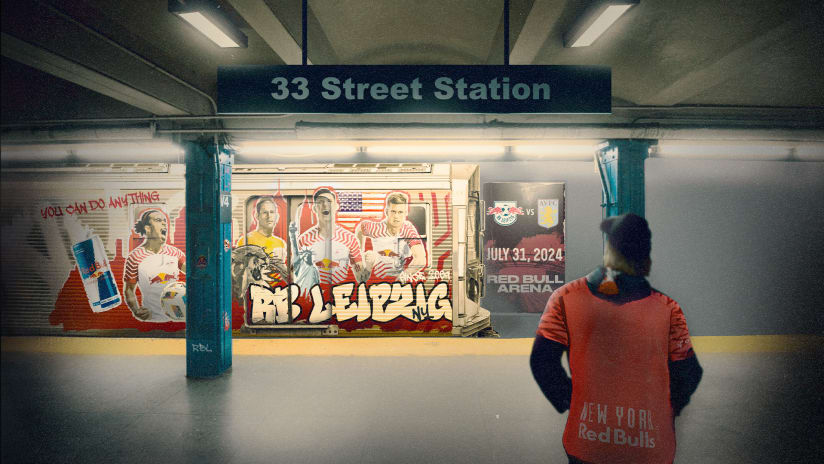
- Share on Facebook
HARRISON, N.J. (April 25, 2024) – RB Leipzig have announced that the club will leave Europe for preseason for the first time in the club’s history with a trip to the United States planned from July 28 to August 4.
Leipzig will participate in its first friendly of the 2024/25 season on Wednesday, July 31 at Red Bull Arena against English Premier League side Aston Villa with kick-off set for 8 p.m. ET.
“This will be our first preseason outside of Europe and with the USA, we decided to go to a key target market for our club. RB Leipzig excited soccer fans both domestically and internationally with its unique story, which has taken us from the fifth division to the Champions League,” said RB Leipzig CEO Johann Plenge. “We have brought the world of soccer back to Leipzig with our exciting European runs in recent years and as a host city for EURO 2024. Now we’re bringing Leipzig to the world! We want to take advantage of our good and special connection to New York and strengthen it for years to come. It is an important step for us, but also for the Bundesliga, which rightly enjoys a great reputation in the US.”
While in the United States, RB Leipzig will set up camp at New York Red Bulls Academy in Whippany, N.J.
“All of us at RBNY – and myself in particular – are really excited that RB Leipzig is coming to New York for its first US tour. It will be a special reunion with players, coaches, and staff for me that I was not expecting so soon,” said New York Red Bulls Captain Emil Forsberg. “Not only are the conditions at our training complex great, but New York is also the perfect city for RB Leipzig and the Bundesliga to become better known in the USA. I’m sure that we will have a great time together.”
RB Leipzig have had many connections to the United States over the years, which includes Tyler Adams, who joined RB Leipzig in 2019 after having spent four years with the New York Red Bulls. Adams would go onto score the winning goal in the Champions League quarterfinal against Atletico Madrid in August of 2020, helping Leipzig reach the semifinals of the competition for the first time in their club history. Former New York Red Bulls homegrown Caden Clark also joined RB Leipzig during the 2022/23 season, as well as former New York Red Bulls Head Coach Jesse Marsch, who served as RB Leipzig Head Coach from July to December 2021.
RB Leipzig has also hosted youth soccer camps in New York metropolitan area in 2022 and 2023. Over 300 kids took part in the week-long camps in Hoboken, NJ and Brooklyn, N.Y., which were led by coaches from the RB Leipzig Football School. Most recently, RB Leipzig Academy hosted players from New York Red Bulls U-13 and U-14 sides, where they took part in trainings as well as several friendlies and also attend an RB Leipzig match against vFl Wolfsburg.
Related Stories
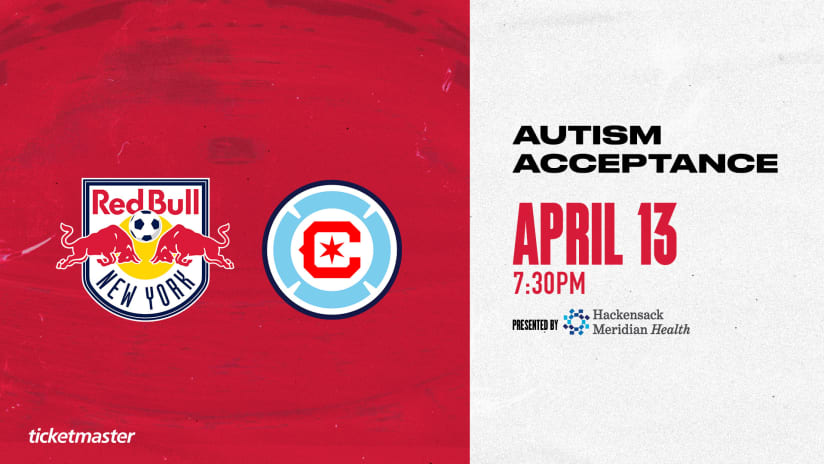
- Ask A Question
- Find Tickets

- Sign Up Now
Visit A City is having some trouble loading.
Please try again in a couple of minutes or send us an email to [email protected] .
- Mock Drafts
- Scouting Reports
- 2024 Prospects

Complete List Of Kansas City Chiefs 2024 NFL Draft Picks
Chiefs GM Brett Veach did an amazing job working the board with key trades to fill positions of need.
- Author: Chris Pirrone
The Chiefs once again ended the season on top of the NFL. Yet the 2023 regular season wasn't as smooth as the end might have made it out to be. This offseason, GM Brett Veach and Coach Andy Reid had some clear holes to fill when analyzing the 2024 draft. Namely, Wide Receiver, Offensive Tackle, Cornerback, Running Back, Interior OL.
The Kansas City Chiefs seemed to exit this years 2024 NFL Draft looking like one of the smartest teams and biggest winners, working multiple trades to get highly regareded players at positions of need.
Here is how Veach and Reid did with their selections for the Kansas City Chiefs 2024 NFL Draft:
Round 1, Pick 28: Texas WR Xavier Worthy Round 2, Pick No. 64: BYU OT Kingsley Suamataia Round 4, Pick 131: TCU TE Jared Wiley Round 4, Pick 133: Washington State DB Jaden Hicks Round 5, Pick 159: Penn State OL Hunter Nourzad Round 6, Pick 211: Tennessee CB Kamal Hadden Round 7, Pick 248: Holy Cross OG C.J. Hanson
For more Chiefs draft coverage check out SI's Chiefs site.
Latest News

Bears Out in Full Force at Caleb Williams' Pro Day Workout
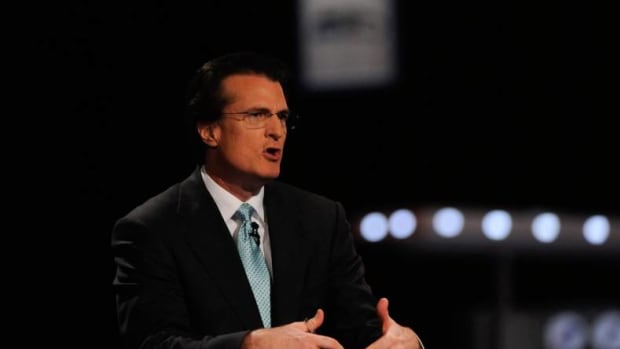
Mel Kiper's New Mock Draft Has a Name We Never See in the 1st Round
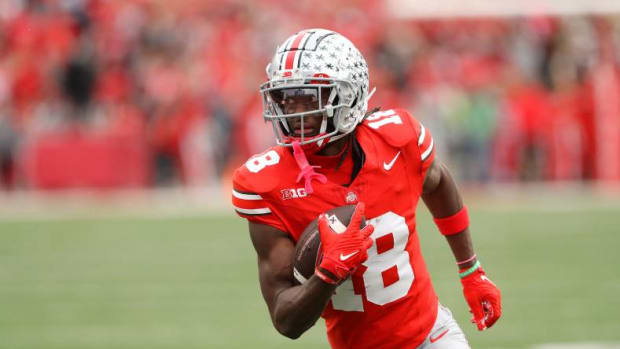
2024 NFL Mock Draft: Daniel Jeremiah Chooses Chaos in New 1st-Round Projection

49ers Lose Draft Pick Over Accounting Errors

2024 NFL Mock Draft: Multiple Teams Trade Up for Top QBs

IMAGES
VIDEO
COMMENTS
Leipzig is not just a lively city with plenty of variety and full of culture, creativity, history and the spirit of the age.Leipzig is also embedded in a vast and incredible region with refreshing lakes and waterways, fairytale castles and palaces and miles of idyllic cycling and hiking paths.Come and explore Leipzig with everything it has to offer in and around the city.
6. Zeitgeschichtliches Forum Leipzig. 415. Speciality Museums. Our new permanent exhibition, Our History. Dictatorship and Democracy after 1945, highlights new themes and explores the post-reunification period in more detail. Here, visitors are taken on a journey through history - from the years after the Second World War to life in former ...
THE OLD CITY HALL. The heart of Leipzig is the marketplace, site of the Altes Rathaus (Old City Hall), one of the finest examples of Renaissance architecture in Germany. This long building was constructed in only nine months, in 1556-57, by Hieronymus Lotter, mayor of Leipzig and architect to the prince elector.
Now, it is flanked by some of the most famous buildings in the city, including Leipzig's first high-rise building, Kroch-Haus, the Opera House and Gewandhaus, the only new GDR concert house. 9. Mädler Passage. Mädler Passage is one of few completely preserved shopping arcades in Germany.
5. Leipzig Zoo Leipzig Zoo . More than just a day's outing for children, Zoo Leipzig is among Germany's best, where 850 different animal species live in habitats very close to their natural homes. Here, you can watch through an underwater glass wall as elephants swim, be greeted by the calls of black howler monkeys, see penguins play, look for alligators in the murky re-creation of the ...
What to See and Do in Leipzig. Introduction Leipzig has one of the longest histories of any German city. As a trade city, that history goes back to the Holy Roman Empire, when Leipzig sat at the intersection of two vital medieval trade routes: the Via Regia (east-west) and the Via Imperii (north-south). More recently, in 1989, Leipzig made its own history by playing a key role in the fall of ...
City-Hochhaus Leipzig. To enjoy a spectacular view of Leipzig, make your way to City-Hochhaus. This modern skyscraper features a panoramic terrace on its 36th floor, which provides a brilliant vantage point across the city. You'll get to see the Old Town landmarks in a new light, while also learning what lies beyond this part of the city.
4. Völkerschlachtdenkmal. Source: Shutterstock. Völkerschlachtdenkmal. A lasting piece of Wilhelmine architecture is this monument to the Battle of Leipzig. The battle took place in 1813, and brought about one of Napoleon's final defeats, against a coalition of armies from Russia, Prussia, Austria and Sweden.
Tourist-Information. The Tourist Information Centre provides the following services: information leaflets and brochures, street maps, advice, insider tips, souvenirs of Leipzig, travel offers for individuals and groups, LEIPZIG CARD. Tours of the city on foot or by vehicle and tickets for events can be purchased from our highly competent partners.
Asisi Panometer. Located south of the centre is one of my favourite of the things to do around Leipzig, the Asisi Panometer. At 50 metres tall and 57 metres in diameter, this gasometer is big with a brick shell. Today, it shows the world's largest panoramas.
Leipzig. Leipzig is the largest city in the German federal state of Saxony, with a population of approximately 600,000 (Oct 2019). It is the economic centre of the region, known as Germany's "Boomtown" and a major cultural centre, offering interesting sights, shopping and lively nightlife. The Gewandhausorchester is the biggest and one of the ...
10. Mendelssohn-Haus Leipzig. 277. Speciality Museums. Classical music fans will appreciate a visit to Felix Mendelssohn Bartholdy's home (now a museum) and his music salon where we hold concerts every Sunday at 11:00. Find information about Mendelssohn's family, esp. about his sister Fanny Hensel.
1. Tour the Augustusplatz. Address: Augustuspl.Leipzig, Germany. Located at the east end of Leipzig city, Augustusplatz is the largest square in Europe. In this square, you can explore cathedrals and several historical landmarks. Also, this square hosts festivals, concerts, and seasonal markets all year round.
But Leipzig, the largest city in the eastern state of Saxony, has grown faster than any other in Germany, adding more than 100,000 residents since 2000. (Its total population is now 570,000.) (Its ...
Help. Use this easy going one day Leipzig itinerary to guide you through the city at a comfortable pace. The itinerary includes must-see attractions but it won't rush you off your feet. With one day you don't have to rush but can visit the major attractions like Monument to the Battle of the Nations, St. Thomas Church and Grassi Museum as ...
Overview. one day in the beautiful city of Leipzig will give you enough time to see the top attractions. The itinerary takes you at a comfortable pace from attraction to attraction so that you won't miss a thing. You'll visit Monument to the Battle of the Nations, St. Thomas Church and Grassi Museum. With one day you don't have to rush but can ...
Leipzig's Monument to the Battle of the Nations was erected in 1913, in celebration of 100 years since Napoleon's defeat and retreat from Germany. Standing at 91m tall, you can climb 500 stairs to the top where a splendid view of the city awaits. Inside, there is also an abundance of historical information regarding the 1813 battle that ...
09:30 Monument to the Battle of the Nations. A memorial dedicated to the ones who died during the 1813 Battle of Leipzig. . 22 mins. File Upload Bot (Magnus Manske) 10:50 Grassi Museum. A museum combination of music, art, and culture. . 10 mins.
Call Center of the Tourist Information: Telephone: +49 (0)341 7104-260 Fax: +49 (0)341 7104 271 E-Mail: [email protected] Opening Times. Monday to Friday: 9.30 am to 6 pm Saturday: 9.30 am to 4 pm Sunday: 9.30 am to 3 pm
Leipzig is the most populous city in the German state of Saxony.The city has a population of 628,718 inhabitants as of 2023. It is the eighth most populous city in Germany. The name of the city and those of many of its districts are of Slavic origin.. Leipzig is located about 150 km (90 mi) southwest of Berlin, in the southernmost part of the North German Plain (the Leipzig Bay), at the ...
1. Europe's City of Music. Hardly any other city on Earth can claim as rich a musical heritage as Leipzig, which has reversed its musicians, past and present, for more than 800 years, celebrating them with world-class festivals every year. Travelers can attend a performance of the St. Thomas choir, a world-renowned boys choir and the city's ...
📌 Location : Leipzig , Germany Date recorded: July 2:20 PMWeather: 🌤️ 35°C | 95°FLeipzig is unarguably one of the most beautiful cities in the world, ...
Multiple law enforcement officers were hit by gunfire Monday afternoon in Charlotte, N.C., according to local police. U.S. Marshals Task Force, which includes officers from different agencies, was …
Here are the fixtures for RB Leipzig's summer tour of the United States, with information on purchasing tickets set to come. RB Leipzig USA tour 2024. July 31: RB Leipzig vs. Aston Villa — Red Bull Arena, Harrison, NJ.
The city cannabis enforcers raided an illegal "Gelato" marijuana shop in Brooklyn Monday morning after a defiant worker there dared authorities to shut them down during an interview wit…
Family Business in New York: RB Leipzig, two-time Germann Cup winner, will leave Europe for preseason for the first time in its history, with a trip to the USA planned from July 28 to August 4.. During the US tour, Marco Rose and his team will set up base camp at the New York Red Bulls Academy in Whippany, NJ, and are sure to see some familiar faces during their stay such as Emil Forsberg ...
RB Leipzig announced that the club will hold a training camp in New Jersey from July 28 to August 4. [+] As part of the US Tour the club will play Aston Villa on July 31 at the New York Red Bulls ...
RB Leipzig excited soccer fans both domestically and internationally with its unique story, which has taken us from the fifth division to the Champions League," said RB Leipzig CEO Johann Plenge. "We have brought the world of soccer back to Leipzig with our exciting European runs in recent years and as a host city for EURO 2024.
Interactive map of Leipzig with all popular attractions - Naschmarkt , Monument to the Battle of the Nations, St. Thomas Church and more. Take a look at our detailed itineraries, guides and maps to help you plan your trip to Leipzig.
Here is how Veach and Reid did with their selections for the Kansas City Chiefs 2024 NFL Draft: Round 1, Pick 28: Texas WR Xavier Worthy Round 2, Pick No. 64: BYU OT Kingsley Suamataia